 The BBC (British Broadcasting Company, as it was known at the time) started the world’s first regular high definition – ‘high’ in this case being relative to what was technologically possible at the time – public television service at 3 p.m. on 2 November 1936, transmitting 405-line black-and-white pictures from Alexandra Palace (London) to an audience of less than 400 sets. The transmitter range was only 30 miles, and programming was very minimal to begin with – an hour in the afternoon and an hour in the evening, and nothing on Sundays until February 1938 – due to a lack of budget and studio facilities (only one studio available until 1938 when the second studio housing the Baird camera was recommissioned) and also due to early concerns about eye strain, though staring for long periods at a small flickering screen must have been difficult.
The BBC (British Broadcasting Company, as it was known at the time) started the world’s first regular high definition – ‘high’ in this case being relative to what was technologically possible at the time – public television service at 3 p.m. on 2 November 1936, transmitting 405-line black-and-white pictures from Alexandra Palace (London) to an audience of less than 400 sets. The transmitter range was only 30 miles, and programming was very minimal to begin with – an hour in the afternoon and an hour in the evening, and nothing on Sundays until February 1938 – due to a lack of budget and studio facilities (only one studio available until 1938 when the second studio housing the Baird camera was recommissioned) and also due to early concerns about eye strain, though staring for long periods at a small flickering screen must have been difficult.
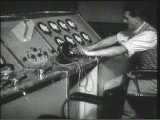 Lord Selsdon’s Committee, set up by the Postmaster General in 1935 had advised that the BBC should hold a public trial of the two systems proposed – Baird’s 240-line mechanical scanning system and Marconi-EMI’s 405-line electronic scanning system, so both systems were used on alternate weeks with each system’s equipment housed in separate 40 foot long studios. The Marconi-EMI system was so obviously superior in all respects that the Baird system was dropped by February 1937; Baird’s camera was fixed and required the subject to be specially lit, compared with Marconi-EMI’s cameras which could even be used outside with an extension lead. Baird had tried to overcome camera restrictions using an “intermediate film system” where celluloid film was rapidly processed and fed into an optical scanner, but it became fairly obvious that this cumbersome and expensive technique was merely a stop-gap compared to the Marconi-EMI system’s future potential.
Lord Selsdon’s Committee, set up by the Postmaster General in 1935 had advised that the BBC should hold a public trial of the two systems proposed – Baird’s 240-line mechanical scanning system and Marconi-EMI’s 405-line electronic scanning system, so both systems were used on alternate weeks with each system’s equipment housed in separate 40 foot long studios. The Marconi-EMI system was so obviously superior in all respects that the Baird system was dropped by February 1937; Baird’s camera was fixed and required the subject to be specially lit, compared with Marconi-EMI’s cameras which could even be used outside with an extension lead. Baird had tried to overcome camera restrictions using an “intermediate film system” where celluloid film was rapidly processed and fed into an optical scanner, but it became fairly obvious that this cumbersome and expensive technique was merely a stop-gap compared to the Marconi-EMI system’s future potential.
 Before World War 2 television was slow to catch on, largely due to the limited range of the transmissions, lack of programmes, and the cost of the receivers (£60 upwards) meant that typically only wealthy people could afford them, so programming was aimed generally at this audience; especially as the BBC itself was controlled by people from these affluent social groups.
Before World War 2 television was slow to catch on, largely due to the limited range of the transmissions, lack of programmes, and the cost of the receivers (£60 upwards) meant that typically only wealthy people could afford them, so programming was aimed generally at this audience; especially as the BBC itself was controlled by people from these affluent social groups.
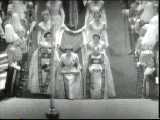 Television was still very much in its infancy when the service restarted in 1946. One set per street was common, and families often visited friends or relatives who had a set in order to watch events such as the Coronation in 1953. Also only two studios were available until 1949 when the BBC opened eight new West London studios (one ex-variety theatre and the rest were converted film studios).
Television was still very much in its infancy when the service restarted in 1946. One set per street was common, and families often visited friends or relatives who had a set in order to watch events such as the Coronation in 1953. Also only two studios were available until 1949 when the BBC opened eight new West London studios (one ex-variety theatre and the rest were converted film studios).
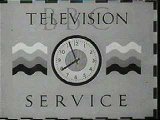 After World War 2 a comprehensive transmitter building programme ensured more people outside heavy populated areas such as London could watch television, though it was slow to progress due to funding restrictions. In 1949 television reached the Midlands, Manchester in 1951, Scotland in 1952, then Wales and the West Country. Lack of signal coverage didn’t stop people living in ‘fringe’ areas putting up large aerials in an attempt to receive some form of television picture even if the end result was unwatchable from time to time due to nearby interference, even though for the first few post-war years television was heavily restricted to a small number of programmes each day, typically starting with a demonstration film in the morning and concluding with a news broadcast being relayed in sound only. Large gaps between programmes were very common, with interlude films or tuning signal captions being displayed between programmes.
After World War 2 a comprehensive transmitter building programme ensured more people outside heavy populated areas such as London could watch television, though it was slow to progress due to funding restrictions. In 1949 television reached the Midlands, Manchester in 1951, Scotland in 1952, then Wales and the West Country. Lack of signal coverage didn’t stop people living in ‘fringe’ areas putting up large aerials in an attempt to receive some form of television picture even if the end result was unwatchable from time to time due to nearby interference, even though for the first few post-war years television was heavily restricted to a small number of programmes each day, typically starting with a demonstration film in the morning and concluding with a news broadcast being relayed in sound only. Large gaps between programmes were very common, with interlude films or tuning signal captions being displayed between programmes.
 On December 2 1953, the BBC introduced a new symbol for use as visual identification (or an ident) for its Television Service, which quickly gained the nickname of “bat’s wings” due to its shape, and was the world’s first animated television ident symbol. Two ‘eyes’ rotated in the centre of a mechanical model whilst flashes of light shone on the wings at quarter-turn intervals; this was constructed as a mechanical model and the animation was filmed because the model was too fragile for regular use. The concept was developed by talented designer Abram Games, who was commissioned by the BBC on the strength of his emblem design for the Festival of Britain in 1951.
On December 2 1953, the BBC introduced a new symbol for use as visual identification (or an ident) for its Television Service, which quickly gained the nickname of “bat’s wings” due to its shape, and was the world’s first animated television ident symbol. Two ‘eyes’ rotated in the centre of a mechanical model whilst flashes of light shone on the wings at quarter-turn intervals; this was constructed as a mechanical model and the animation was filmed because the model was too fragile for regular use. The concept was developed by talented designer Abram Games, who was commissioned by the BBC on the strength of his emblem design for the Festival of Britain in 1951.
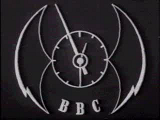 Games also designed this clock as well as static cards featuring a simplified version of the same logo. Both the animated symbol and the clock remained in use until the end of 1959, but static captions featuring the symbol continued to be used until October 1960, whilst elements of the symbol (such as miniature lightning flashes) continued to be used for Schools programming until October 1961. During the mid-fifties, television was becoming more ambitious in terms of quantity and breadth, especially as post-war rationing was gradually coming to an end; programmes during this era included Mainly For Women, quiz show What’s My Line?, comedy series Emney Enterprises, drama serial The Grove Family, children’s favourite The Flowerpot Men and the groundbreaking six-part science fiction drama Quatermass and the Pit.
Games also designed this clock as well as static cards featuring a simplified version of the same logo. Both the animated symbol and the clock remained in use until the end of 1959, but static captions featuring the symbol continued to be used until October 1960, whilst elements of the symbol (such as miniature lightning flashes) continued to be used for Schools programming until October 1961. During the mid-fifties, television was becoming more ambitious in terms of quantity and breadth, especially as post-war rationing was gradually coming to an end; programmes during this era included Mainly For Women, quiz show What’s My Line?, comedy series Emney Enterprises, drama serial The Grove Family, children’s favourite The Flowerpot Men and the groundbreaking six-part science fiction drama Quatermass and the Pit.

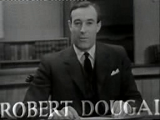
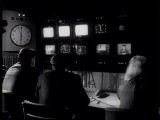 Television was starting to prove that the coverage of news and current events could combine the immediacy of a radio news report with visuals which were far more up-to-date than a cinema newsreel, even if news bulletins in particular were somewhat restricted in terms of what was achievable with the resources available to them. The use of still photographs to illustrate news stories (as opposed to moving pictures) was extremely commonplace, with regional news programmes in particular continuing with the practice into the 1980s primarily due to a lack of resources.
Television was starting to prove that the coverage of news and current events could combine the immediacy of a radio news report with visuals which were far more up-to-date than a cinema newsreel, even if news bulletins in particular were somewhat restricted in terms of what was achievable with the resources available to them. The use of still photographs to illustrate news stories (as opposed to moving pictures) was extremely commonplace, with regional news programmes in particular continuing with the practice into the 1980s primarily due to a lack of resources.
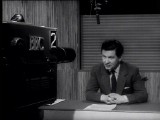 The early post-war BBC news bulletins were often almost identical in format to the newsreels shown in cinemas, but competition from Independent Television News from 1955 onwards caused the BBC to adopt a more flexible presentation format for its bulletins. Shown here is Richard Baker presenting the 6pm news bulletin.
The early post-war BBC news bulletins were often almost identical in format to the newsreels shown in cinemas, but competition from Independent Television News from 1955 onwards caused the BBC to adopt a more flexible presentation format for its bulletins. Shown here is Richard Baker presenting the 6pm news bulletin.
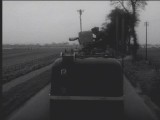 Post-war improvements in television technology meant that outside broadcasts of events such as horse racing were not only technically feasible but a wireless link meant that the action could be relayed back to the studios in real time from a moving vehicle for a truly live broadcast with no need to rush-process reels of film.
Post-war improvements in television technology meant that outside broadcasts of events such as horse racing were not only technically feasible but a wireless link meant that the action could be relayed back to the studios in real time from a moving vehicle for a truly live broadcast with no need to rush-process reels of film.
 The advent of video recording using magnetic tape in 1956 not only meant that programmes could now be easily recorded and reused, but also allowed for the recording of outdoor and indoor events for replaying at a more convenient time. Shown here is one of the first videotape recorders that was housed at the BBC’s Lime Grove studios; early videotapes were unreliable so the recording had to be replayed by a technician to check the quality of the recording before it was used for broadcast. Due to the high price of both the recorder and the tapes, the tapes were frequently wiped and reused after a programme had been shown or after a later repeat showing, therefore many programmes were not kept for posterity as a consequence unless they were judged to be of particular importance.
The advent of video recording using magnetic tape in 1956 not only meant that programmes could now be easily recorded and reused, but also allowed for the recording of outdoor and indoor events for replaying at a more convenient time. Shown here is one of the first videotape recorders that was housed at the BBC’s Lime Grove studios; early videotapes were unreliable so the recording had to be replayed by a technician to check the quality of the recording before it was used for broadcast. Due to the high price of both the recorder and the tapes, the tapes were frequently wiped and reused after a programme had been shown or after a later repeat showing, therefore many programmes were not kept for posterity as a consequence unless they were judged to be of particular importance.
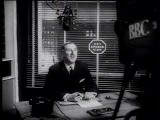 Video playback was particularly useful for the replay of sporting events such as horse racing, though good quality and immediate slow motion action replays had to wait for the invention of magnetic videodisc recording in 1968, and the replay time of these early disc recorders was limited to less than 30 seconds. Pictured here is the presenter of Sportsview, Peter Dimmock.
Video playback was particularly useful for the replay of sporting events such as horse racing, though good quality and immediate slow motion action replays had to wait for the invention of magnetic videodisc recording in 1968, and the replay time of these early disc recorders was limited to less than 30 seconds. Pictured here is the presenter of Sportsview, Peter Dimmock.
 Current affairs is a very important part of the schedule, and uses the medium of television to effectively cover the background to current news stories with a greater depth than is generally possible with a conventional news bulletin; here is Cliff Michelmore presenting an episode of Tonight. Other similar programmes include Panorama, which was (and still is) the BBC’s flagship current affairs programme that usually tackles a single topical issue in depth.
Current affairs is a very important part of the schedule, and uses the medium of television to effectively cover the background to current news stories with a greater depth than is generally possible with a conventional news bulletin; here is Cliff Michelmore presenting an episode of Tonight. Other similar programmes include Panorama, which was (and still is) the BBC’s flagship current affairs programme that usually tackles a single topical issue in depth.
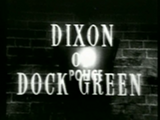 Dixon of Dock Green, with Jack Warner as PC Dixon was a long running police series that was rather old-fashioned in its approach even when it was first shown, but was popular nevertheless and lasted right up until 1976 when the competition (such as Z Cars and Softly Softly Task Force) started to make it look way past its “sell-by date”.
Dixon of Dock Green, with Jack Warner as PC Dixon was a long running police series that was rather old-fashioned in its approach even when it was first shown, but was popular nevertheless and lasted right up until 1976 when the competition (such as Z Cars and Softly Softly Task Force) started to make it look way past its “sell-by date”.
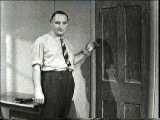 The increase in viewers combined with competition from ITV by 1955 lead to new programme ideas being explored. From 1956 onwards, Barry Bucknell (pictured here) presented do-it-yourself projects on television, firstly as a contributor to About The Home which was then followed by his own series, entitled Barry Bucknell’s Do It Yourself. Just like many contemporaneous studio-based productions, this was broadcast live, resulting in the occasional (and inevitable) on-screen mishap. He then went on to present the much more ambitious house renovation programme Bucknell’s House in 1962, featuring a house in Ealing bought for £2,250. This area of programming was relatively neglected during the following decades until the advent of Changing Rooms in 1994, though there was On the House shown in the mid 1980s.
The increase in viewers combined with competition from ITV by 1955 lead to new programme ideas being explored. From 1956 onwards, Barry Bucknell (pictured here) presented do-it-yourself projects on television, firstly as a contributor to About The Home which was then followed by his own series, entitled Barry Bucknell’s Do It Yourself. Just like many contemporaneous studio-based productions, this was broadcast live, resulting in the occasional (and inevitable) on-screen mishap. He then went on to present the much more ambitious house renovation programme Bucknell’s House in 1962, featuring a house in Ealing bought for £2,250. This area of programming was relatively neglected during the following decades until the advent of Changing Rooms in 1994, though there was On the House shown in the mid 1980s.
 Grandstand was the name of the BBC’s long-running sports magazine programme that was broadcast between 1958 and 2007, mainly on Saturday afternoons when much of the sporting action took place. Peter Dimmock presented the first three programmes but David Coleman then took over the role of presenter who was followed by Frank Bough, Des Lynam, Steve Rider and a slew of guest presenters during its final years up until Grandstand‘s final broadcasts during the last weekend of January 2007. It was most likely axed because the BBC now had fewer rights to broadcast sport than it did in the past due to increased competition from other broadcasters; notably pay-TV sport channels provided by broadcasters like BSkyB and BT.
Grandstand was the name of the BBC’s long-running sports magazine programme that was broadcast between 1958 and 2007, mainly on Saturday afternoons when much of the sporting action took place. Peter Dimmock presented the first three programmes but David Coleman then took over the role of presenter who was followed by Frank Bough, Des Lynam, Steve Rider and a slew of guest presenters during its final years up until Grandstand‘s final broadcasts during the last weekend of January 2007. It was most likely axed because the BBC now had fewer rights to broadcast sport than it did in the past due to increased competition from other broadcasters; notably pay-TV sport channels provided by broadcasters like BSkyB and BT.
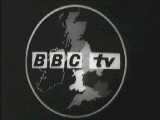

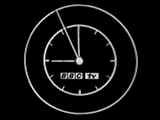 The above images illustrate the style of programme promotion used circa 1960, with its contemporary style and bold graphics replacing the Abram Games-designed “bat’s wings” symbol; elements of the new design had been introduced during 1959 prior to its formal introduction in 1960. Note the “BBC tv” italic letters appearing in separate square boxes similar to the modern BBC logo style, and the clock kept the unusually long second hand previously used for the “bat’s wing” clock. However this presentation style didn’t last nearly as long as the Abram Games symbol, with the introduction of the first of a succession of various globe symbols used to identify BBC Television soon to follow together with changes in style for the BBC corporate logo.
The above images illustrate the style of programme promotion used circa 1960, with its contemporary style and bold graphics replacing the Abram Games-designed “bat’s wings” symbol; elements of the new design had been introduced during 1959 prior to its formal introduction in 1960. Note the “BBC tv” italic letters appearing in separate square boxes similar to the modern BBC logo style, and the clock kept the unusually long second hand previously used for the “bat’s wing” clock. However this presentation style didn’t last nearly as long as the Abram Games symbol, with the introduction of the first of a succession of various globe symbols used to identify BBC Television soon to follow together with changes in style for the BBC corporate logo.
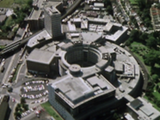 With television now rapidly becoming the dominant broadcasting medium in the UK, the BBC needed somewhere that was much bigger than Alexandra Palace to accommodate its production requirements, therefore a new headquarters known as BBC Television Centre was commissioned and built on a suitable site in West London, with construction commencing in 1952 and Television Centre was ready for use by June 1960. From the air, the Television Centre buildings appear to take on the shape of a question mark, because that layout was thought to be best for the site in general.
With television now rapidly becoming the dominant broadcasting medium in the UK, the BBC needed somewhere that was much bigger than Alexandra Palace to accommodate its production requirements, therefore a new headquarters known as BBC Television Centre was commissioned and built on a suitable site in West London, with construction commencing in 1952 and Television Centre was ready for use by June 1960. From the air, the Television Centre buildings appear to take on the shape of a question mark, because that layout was thought to be best for the site in general.
 The BBC naturally wanted to show off its new Television Centre building to its viewers, so a special light entertainment programme was shown on 29 June 1960 in order to do just that, logically entitled First Night. Not all of the BBC’s departments moved into the new building straightaway, with (for example) the News division not moving into Television Centre until 1969. The Open University was to make use of otherwise-unused Alexandra Palace studio facilities from 1970 onwards.
The BBC naturally wanted to show off its new Television Centre building to its viewers, so a special light entertainment programme was shown on 29 June 1960 in order to do just that, logically entitled First Night. Not all of the BBC’s departments moved into the new building straightaway, with (for example) the News division not moving into Television Centre until 1969. The Open University was to make use of otherwise-unused Alexandra Palace studio facilities from 1970 onwards.


The 1963 Eurovision Song Contest came from London due to the United Kingdom winning the previous year’s contest, giving the BBC an opportunity to show off its still relatively new Television Centre headquarters to a much bigger Eurovision audience worldwide.
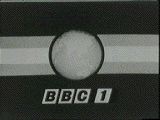 The introduction of BBC2 in 1964, which enabled extra programmes which were not necessarily of mass appeal to be shown, and eventually colour was introduced to (what was now known as) BBC1 by the end of the decade. Some very memorable and ground-breaking programmes were being produced during this period which are still being shown around the world today, such as Steptoe and Son, and the long-running Doctor Who series began. Other programmes shown during the late 1960s included the popular sitcom Beggar My Neighbour, soap The Newcomers and football club drama United.
The introduction of BBC2 in 1964, which enabled extra programmes which were not necessarily of mass appeal to be shown, and eventually colour was introduced to (what was now known as) BBC1 by the end of the decade. Some very memorable and ground-breaking programmes were being produced during this period which are still being shown around the world today, such as Steptoe and Son, and the long-running Doctor Who series began. Other programmes shown during the late 1960s included the popular sitcom Beggar My Neighbour, soap The Newcomers and football club drama United.
 The weather forecast had progressed from the use of hand-drawn maps to the use of magnetic symbols by the mid-1960s as shown here, and this style of map continued to be used for several years after BBC1 had started broadcasting in colour in 1969. Before the use of magnetic symbols, everything had to be hand-drawn which was a time-consuming practice as well as being rather inflexible; the whole map obviously had to be redrawn if a correction was required.
The weather forecast had progressed from the use of hand-drawn maps to the use of magnetic symbols by the mid-1960s as shown here, and this style of map continued to be used for several years after BBC1 had started broadcasting in colour in 1969. Before the use of magnetic symbols, everything had to be hand-drawn which was a time-consuming practice as well as being rather inflexible; the whole map obviously had to be redrawn if a correction was required.
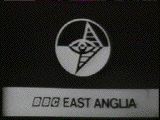 Despite BBC1 getting the go-ahead to start a colour service in 1969, the regional centres were inevitably slower to upgrade all of their equipment to provide a colour service due to cost reasons, and it was several months before Television Centre was fully colour-equipped. The news magazine programme Nationwide incorporating reports and features from the various regions also started in this particular year, and some of the regional contributions weren’t produced in colour until the end of the 1970s. (Inside Out is perhaps the modern spiritual successor to Nationwide even if The One Show has a similar mix of features and studio discussion pieces.)
Despite BBC1 getting the go-ahead to start a colour service in 1969, the regional centres were inevitably slower to upgrade all of their equipment to provide a colour service due to cost reasons, and it was several months before Television Centre was fully colour-equipped. The news magazine programme Nationwide incorporating reports and features from the various regions also started in this particular year, and some of the regional contributions weren’t produced in colour until the end of the 1970s. (Inside Out is perhaps the modern spiritual successor to Nationwide even if The One Show has a similar mix of features and studio discussion pieces.)
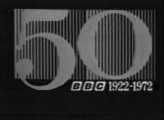 1972 was the 50th anniversary of the BBC, though at that time less than 20% of viewers had a colour television despite a colour service being available on all three channels since 1969; the BBC’s summer Olympic Games coverage did however help to boost colour television sales during 1972. Notable BBC1 programmes broadcast during the early 1970s included Bruce Forsyth and the Generation Game (its initial title) which started in 1971, science fiction drama Moonbase 3, drama series Owen, M.D., plus the popular sitcoms Are You Being Served? and the very long-running Last Of The Summer Wine began in 1972.
1972 was the 50th anniversary of the BBC, though at that time less than 20% of viewers had a colour television despite a colour service being available on all three channels since 1969; the BBC’s summer Olympic Games coverage did however help to boost colour television sales during 1972. Notable BBC1 programmes broadcast during the early 1970s included Bruce Forsyth and the Generation Game (its initial title) which started in 1971, science fiction drama Moonbase 3, drama series Owen, M.D., plus the popular sitcoms Are You Being Served? and the very long-running Last Of The Summer Wine began in 1972.
 By the mid 1970s most families had at least one television set, and nearly all of the populated regions of the British Isles could receive television pictures in some form even if it was only a 405-line monochrome signal. Sitcoms and studio-based light entertainment were of extremely high quality during this period, with many classic programmes produced including It Ain’t Half Hot Mum, Some Mothers Do ‘Ave ‘Em, The Good Life and The Liver Birds. The Two Ronnies, The Morecambe and Wise Show and The Mike Yarwood Show featured in what many people now consider to be the BBC’s greatest ever Christmas Day schedule in 1977.
By the mid 1970s most families had at least one television set, and nearly all of the populated regions of the British Isles could receive television pictures in some form even if it was only a 405-line monochrome signal. Sitcoms and studio-based light entertainment were of extremely high quality during this period, with many classic programmes produced including It Ain’t Half Hot Mum, Some Mothers Do ‘Ave ‘Em, The Good Life and The Liver Birds. The Two Ronnies, The Morecambe and Wise Show and The Mike Yarwood Show featured in what many people now consider to be the BBC’s greatest ever Christmas Day schedule in 1977.
First given a public demonstration in 1972, the BBC-developed CEEFAX information service commenced public transmissions in September 1974 though it wasn’t until 1976 when suitable set-top boxes for the service were available to buy in any quantity.
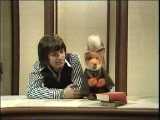 The Basil Brush Show started life as a children’s programme in 1968, showing on Thursdays just before the early evening news, but by the mid-1970s it had moved to an early Saturday evening slot and was now a very popular mainstream family entertainment show, featuring top singing stars like Cilla Black, Demis Roussos and Petula Clark that often did a comedy duet with fox puppet Basil as well as singing on their own. Basil is shown here with Roy North, who became Basil’s human sidekick in 1976.
The Basil Brush Show started life as a children’s programme in 1968, showing on Thursdays just before the early evening news, but by the mid-1970s it had moved to an early Saturday evening slot and was now a very popular mainstream family entertainment show, featuring top singing stars like Cilla Black, Demis Roussos and Petula Clark that often did a comedy duet with fox puppet Basil as well as singing on their own. Basil is shown here with Roy North, who became Basil’s human sidekick in 1976.
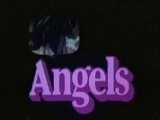 Angels was a popular drama series set in a fictional (St. Angela’s) hospital, and is just one example of the BBC’s prodigious drama output from the 1970s. Indeed Angels survived until the early 1980s and was the spiritual predecessor to Casualty (which started in 1986) and its later spin-off Holby City which are now shown on a regular basis. Other drama offerings from this period included historical drama I, Claudius, and science fiction series Blake’s 7 began in 1978.
Angels was a popular drama series set in a fictional (St. Angela’s) hospital, and is just one example of the BBC’s prodigious drama output from the 1970s. Indeed Angels survived until the early 1980s and was the spiritual predecessor to Casualty (which started in 1986) and its later spin-off Holby City which are now shown on a regular basis. Other drama offerings from this period included historical drama I, Claudius, and science fiction series Blake’s 7 began in 1978.

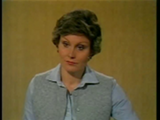

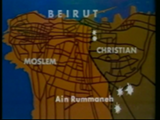 Pictured is what a typical BBC News bulletin looked like in 1978, with Angela Rippon being the newsreader. There was still a predominance of photographs used during this period as opposed to the video clips that typify modern news bulletins, though national news bulletins were steadily becoming more sophisticated in their visual presentation.
Pictured is what a typical BBC News bulletin looked like in 1978, with Angela Rippon being the newsreader. There was still a predominance of photographs used during this period as opposed to the video clips that typify modern news bulletins, though national news bulletins were steadily becoming more sophisticated in their visual presentation.
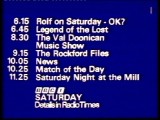 Here’s an example of a BBC1 Saturday evening programme schedule as broadcast on 14 April 1979. At this point virtually all new programmes were now being produced in colour, though there were still a significant number of people that didn’t have colour televisions; 1976 being the year when colour TV licences outnumbered those issued for black and white. 1979 also saw the broadcast of what was the most ambitious natural history series commissioned up to that point, namely Life on Earth, presented by David Attenborough.
Here’s an example of a BBC1 Saturday evening programme schedule as broadcast on 14 April 1979. At this point virtually all new programmes were now being produced in colour, though there were still a significant number of people that didn’t have colour televisions; 1976 being the year when colour TV licences outnumbered those issued for black and white. 1979 also saw the broadcast of what was the most ambitious natural history series commissioned up to that point, namely Life on Earth, presented by David Attenborough.
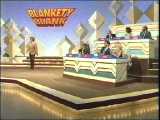 Blankety Blank was a popular BBC quiz show which was first presented by Terry Wogan (famous for having his long stick microphone bent by Kenny Everett), but was later presented by Les Dawson. Then the series was revived with Lilly Savage at the helm, followed by ITV giving the idea a brief revival itself but none of these revivals matched the popularity of the original series.
Blankety Blank was a popular BBC quiz show which was first presented by Terry Wogan (famous for having his long stick microphone bent by Kenny Everett), but was later presented by Les Dawson. Then the series was revived with Lilly Savage at the helm, followed by ITV giving the idea a brief revival itself but none of these revivals matched the popularity of the original series.
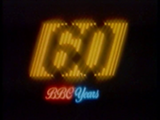 1982 was the 60th anniversary of the BBC, and the “60 BBC Years” slogan was also used at the bottom of the BBC1 globe ident for a while as part of the celebrations. September that same year also saw the introduction of a new light entertainment series: The Late, Late Breakfast Show, which featured a selection of occasionally dangerous stunts performed by members of the public in the “Give It A Whirl” slot that resulted in several injuries and a death that caused the show to be cancelled in 1986. The Late-Late Breakfast Show was presented by Noel Edmonds who at that point was famous for presenting breakfast shows both on the radio and Swap Shop on BBC1, hence the tongue-in-cheek title.
1982 was the 60th anniversary of the BBC, and the “60 BBC Years” slogan was also used at the bottom of the BBC1 globe ident for a while as part of the celebrations. September that same year also saw the introduction of a new light entertainment series: The Late, Late Breakfast Show, which featured a selection of occasionally dangerous stunts performed by members of the public in the “Give It A Whirl” slot that resulted in several injuries and a death that caused the show to be cancelled in 1986. The Late-Late Breakfast Show was presented by Noel Edmonds who at that point was famous for presenting breakfast shows both on the radio and Swap Shop on BBC1, hence the tongue-in-cheek title.
 1982 was also the year of the Falklands War, with the BBC naturally devoting significant coverage to this particular news story allowing for the limitations of war reporting. Also the raising of the wreck of the Mary Rose was shown live on television in the same year.
1982 was also the year of the Falklands War, with the BBC naturally devoting significant coverage to this particular news story allowing for the limitations of war reporting. Also the raising of the wreck of the Mary Rose was shown live on television in the same year.
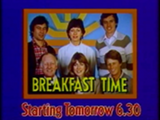 The start of 1983 heralded the launch of breakfast television, with the BBC getting in first with their Breakfast Time before the new TV-am ITV franchise started over on Channel 3. Frank Bough and the team turned out to be just what the nation was waiting for in terms of breakfast television in the morning, and the new TV-am got off to a bad start to the day as a consequence.
The start of 1983 heralded the launch of breakfast television, with the BBC getting in first with their Breakfast Time before the new TV-am ITV franchise started over on Channel 3. Frank Bough and the team turned out to be just what the nation was waiting for in terms of breakfast television in the morning, and the new TV-am got off to a bad start to the day as a consequence.
 By January 1985 the old 405-line VHF network had completely closed down, and a full daytime television schedule launched in 1986 that included Neighbours, the Australian soap opera which is still being shown on Channel 5. By 1989 the BBC and other broadcasters also faced competition from the newly-emerging satellite services (Sky and BSB, with Sky eventually taking over BSB to form BSkyB). Pictured is an example of what a Saturday evening’s viewing on BBC1 looked like on the 6th of June 1987.
By January 1985 the old 405-line VHF network had completely closed down, and a full daytime television schedule launched in 1986 that included Neighbours, the Australian soap opera which is still being shown on Channel 5. By 1989 the BBC and other broadcasters also faced competition from the newly-emerging satellite services (Sky and BSB, with Sky eventually taking over BSB to form BSkyB). Pictured is an example of what a Saturday evening’s viewing on BBC1 looked like on the 6th of June 1987.
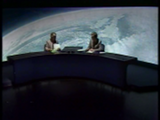


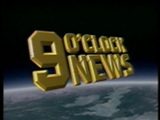 This graphic style used for BBC News has the nickname of “Star Wars” due to the logo appearing to be constructed in space using a beam of light; it certainly seemed to match the mood of the period in terms of its drama and pomposity.
This graphic style used for BBC News has the nickname of “Star Wars” due to the logo appearing to be constructed in space using a beam of light; it certainly seemed to match the mood of the period in terms of its drama and pomposity.
 The 1980s was also the era of the video cassette recorder or ‘VCR’; although such devices were available in the 1970s (and earlier) it was this decade that saw them become widely available and (by 1987) inexpensive thanks to the aggressive pricing of Far Eastern-produced machines such as Amstrad. Teletext became commonplace on more expensive sets and included on some of the cheaper ones too, and Nicam stereo sound was introduced towards the end of the decade, initially from certain transmitters only.
The 1980s was also the era of the video cassette recorder or ‘VCR’; although such devices were available in the 1970s (and earlier) it was this decade that saw them become widely available and (by 1987) inexpensive thanks to the aggressive pricing of Far Eastern-produced machines such as Amstrad. Teletext became commonplace on more expensive sets and included on some of the cheaper ones too, and Nicam stereo sound was introduced towards the end of the decade, initially from certain transmitters only.
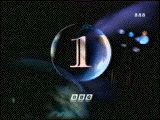 All smoke and mirrors? The globe above was replaced with this smoky light reflecting version in 1991, together with the return of the 1960s typeface. The word ‘Stereo’ appeared in the top-left hand corner when a programme with a stereo soundtrack followed – BBC1 was the last established UK channel to formally introduce Nicam stereo, which it did in September 1991, but not all major transmitters had been upgraded to carry the digital signal from day one.
All smoke and mirrors? The globe above was replaced with this smoky light reflecting version in 1991, together with the return of the 1960s typeface. The word ‘Stereo’ appeared in the top-left hand corner when a programme with a stereo soundtrack followed – BBC1 was the last established UK channel to formally introduce Nicam stereo, which it did in September 1991, but not all major transmitters had been upgraded to carry the digital signal from day one.
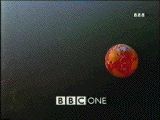 The change from a globe to a balloon (albeit with a globe pattern) came at the same time as the BBC changed its onscreen font to Gill Sans in October 1997, which was part of Martin Lambie-Nairn’s corporate vision for the BBC. The adoption of Gill Sans was something that was both traditional and forward-thinking in terms of looking better when displayed in the new widescreen format and when decompressed from a digitally-compressed datastream compared with the old sloping rhombus typeface that dates back to the 1960s. A variety of short video clips are used featuring the BBC balloon in different locations around the British Isles (above a castle, behind a suspension bridge, etc.), meaning that the balloon usually had a different ‘view’ before each programme as opposed to the essentially static backdrop that the globe had.
The change from a globe to a balloon (albeit with a globe pattern) came at the same time as the BBC changed its onscreen font to Gill Sans in October 1997, which was part of Martin Lambie-Nairn’s corporate vision for the BBC. The adoption of Gill Sans was something that was both traditional and forward-thinking in terms of looking better when displayed in the new widescreen format and when decompressed from a digitally-compressed datastream compared with the old sloping rhombus typeface that dates back to the 1960s. A variety of short video clips are used featuring the BBC balloon in different locations around the British Isles (above a castle, behind a suspension bridge, etc.), meaning that the balloon usually had a different ‘view’ before each programme as opposed to the essentially static backdrop that the globe had.


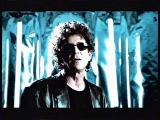
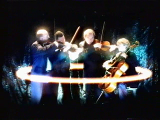
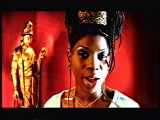


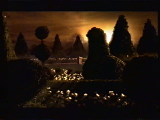
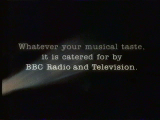 Also launched at the same time as the new corporate look for the BBC was perhaps the most successful UK TV-based promotion of all time; it was based around a simple concept, namely that the BBC offers a huge variety of different types of music, catering for almost every taste on its numerous radio and television services.
Also launched at the same time as the new corporate look for the BBC was perhaps the most successful UK TV-based promotion of all time; it was based around a simple concept, namely that the BBC offers a huge variety of different types of music, catering for almost every taste on its numerous radio and television services.
 Set to the soundtrack of Perfect Day, a song originally performed by Lou Reed who also appears amongst the numerous celebrities who both take it in turns to sing and appear on screen, with a slide projector showing various images interspersed with the celebrities. Also note the thin black bars appearing at the top and bottom of the pictures, indicating that it was one of the first BBC productions to be produced in widescreen format, though the widescreen format was only formally introduced with the introduction of digital widescreen broadcasting the following year.
Set to the soundtrack of Perfect Day, a song originally performed by Lou Reed who also appears amongst the numerous celebrities who both take it in turns to sing and appear on screen, with a slide projector showing various images interspersed with the celebrities. Also note the thin black bars appearing at the top and bottom of the pictures, indicating that it was one of the first BBC productions to be produced in widescreen format, though the widescreen format was only formally introduced with the introduction of digital widescreen broadcasting the following year.
 This version of Perfect Day was released as a charity record and sold more than a million copies in the UK, reaching Number 1 in the singles chart and most likely to have been a major factor in the popularity of this particular promotion, though it has to be said that the promotion itself was exquisitely produced and directed therefore is essentially a work of art in its own right.
This version of Perfect Day was released as a charity record and sold more than a million copies in the UK, reaching Number 1 in the singles chart and most likely to have been a major factor in the popularity of this particular promotion, though it has to be said that the promotion itself was exquisitely produced and directed therefore is essentially a work of art in its own right.
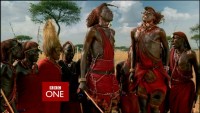 March 2002 saw a radical new look introduced for BBC One; the main channel logo now appears in a box just like the BBC Two logo, but more controversially the globe as a centrepiece has now been banished to the history books, and instead various sequences using dance as a theme have been introduced. The whole emphasis was to introduce a modern multicultural ‘feel’ to the channel, but whether the identity of the channel had been diluted as a result is open to debate, especially as the channel’s presentation package only lasted four years before being replaced by something else.
March 2002 saw a radical new look introduced for BBC One; the main channel logo now appears in a box just like the BBC Two logo, but more controversially the globe as a centrepiece has now been banished to the history books, and instead various sequences using dance as a theme have been introduced. The whole emphasis was to introduce a modern multicultural ‘feel’ to the channel, but whether the identity of the channel had been diluted as a result is open to debate, especially as the channel’s presentation package only lasted four years before being replaced by something else.
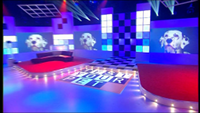 Several programming ideas were tried in 2004 with mixed results; Test your Pet, presumably intended to be educational in relation to animal training but ended up being closer in spirit to to the somewhat infamous but fun Pets Win Prizes. As well as testing pets, humans were equally tested in Come and Have a Go… If You Think You’re Smart Enough, consumer issues were aired in the short-lived Brassed Off Britain, detective drama Murphy’s Law received an airing but something rather more enduring also debuted soon afterwards – Strictly Come Dancing, a dance competition show which rapidly became very popular and continues to this day. And the following year saw the rejuvenation of an old idea which also proved to be just as popular.
Several programming ideas were tried in 2004 with mixed results; Test your Pet, presumably intended to be educational in relation to animal training but ended up being closer in spirit to to the somewhat infamous but fun Pets Win Prizes. As well as testing pets, humans were equally tested in Come and Have a Go… If You Think You’re Smart Enough, consumer issues were aired in the short-lived Brassed Off Britain, detective drama Murphy’s Law received an airing but something rather more enduring also debuted soon afterwards – Strictly Come Dancing, a dance competition show which rapidly became very popular and continues to this day. And the following year saw the rejuvenation of an old idea which also proved to be just as popular.
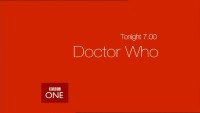 By 2005 Lorraine Heggessey had been replaced by Peter Fincham as controller of BBC One, and the general consensus was that Heggessey had left the channel in a relatively strong position in terms of its drama output with a newly rejuvenated Doctor Who alongside other popular series like New Tricks, proving that it is still possible to have a drama series that appeals to the whole family, though the channel was criticised in the BBC Annual Report for perhaps running too many repeats in peak time. Hustle and A Picture of Britain were other examples of popular programmes, plus The Kumars at No 42 being an example of a programme transferred from BBC Two to BBC One.
By 2005 Lorraine Heggessey had been replaced by Peter Fincham as controller of BBC One, and the general consensus was that Heggessey had left the channel in a relatively strong position in terms of its drama output with a newly rejuvenated Doctor Who alongside other popular series like New Tricks, proving that it is still possible to have a drama series that appeals to the whole family, though the channel was criticised in the BBC Annual Report for perhaps running too many repeats in peak time. Hustle and A Picture of Britain were other examples of popular programmes, plus The Kumars at No 42 being an example of a programme transferred from BBC Two to BBC One.
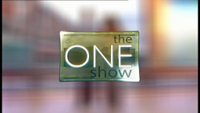 August 2006 saw the first four week trial run of The ONE Show, but its debut had notable differences compared to what the series became when it returned as an (almost) regular fixture of early weekday evenings on BBC One starting from July 2007, notably a different co-presenter alongside Adrian Chiles (Nadia Sawalha), plus a different title sequence with different music as well as the studio being based in Birmingham (the studio overlooked a canal).
August 2006 saw the first four week trial run of The ONE Show, but its debut had notable differences compared to what the series became when it returned as an (almost) regular fixture of early weekday evenings on BBC One starting from July 2007, notably a different co-presenter alongside Adrian Chiles (Nadia Sawalha), plus a different title sequence with different music as well as the studio being based in Birmingham (the studio overlooked a canal).
 During the 2006 trial there was a more formal use of a map showing different UK locations where each regional feature originated from. The ONE Show was thought of by some people as being a spiritual successor to Nationwide, but this was perhaps more the case for the trial run with its map-based presentation as opposed to the revamped final version which had essentially become just a succession of studio-linked features.
During the 2006 trial there was a more formal use of a map showing different UK locations where each regional feature originated from. The ONE Show was thought of by some people as being a spiritual successor to Nationwide, but this was perhaps more the case for the trial run with its map-based presentation as opposed to the revamped final version which had essentially become just a succession of studio-linked features.
 The ONE Show‘s trial run was judged to have been a success but several changes were made including the moderately controversial step of moving the show’s studio base to London as well as employing Christine Bleakley as a co-presenter since Sawalha was no longer available, though both Chiles and Bleakley were later lured by ITV in order to head up their new GMTV replacement, Daybreak, but that didn’t work out as expected therefore both are now employed on different projects within ITV productions. (Chiles was and still is noted for his football punditry.)
The ONE Show‘s trial run was judged to have been a success but several changes were made including the moderately controversial step of moving the show’s studio base to London as well as employing Christine Bleakley as a co-presenter since Sawalha was no longer available, though both Chiles and Bleakley were later lured by ITV in order to head up their new GMTV replacement, Daybreak, but that didn’t work out as expected therefore both are now employed on different projects within ITV productions. (Chiles was and still is noted for his football punditry.)
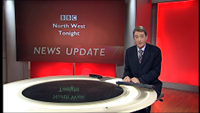 Also included immediately after The ONE Show during its 2006 trial was a short regional news opt-out billed as an “news update”; illustrated here is the BBC North West Tonight News Update, presented by Gordon Burns who has now retired and been replaced by Roger Johnson (ex-BBC South Today).
Also included immediately after The ONE Show during its 2006 trial was a short regional news opt-out billed as an “news update”; illustrated here is the BBC North West Tonight News Update, presented by Gordon Burns who has now retired and been replaced by Roger Johnson (ex-BBC South Today).
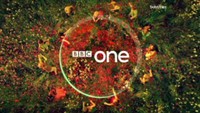 What comes around…The dance and movement idents were inevitably replaced by new idents in 2006, and Red Bee Media had been contracted to produce their replacement. For inspiration they looked at some of the early 1950s BBC Television Service idents which inevitably used some form of circle as part of a tuning signal for viewers to adjust their TV sets, and everything from the Abram Games “bat’s wing” symbol to the later globes also featured a circle as part of their design, so Red Bee proposed that a new identity theme should be based around the concept of circles. New idents were produced which featured real life circular elements such as hippos, surfers, dancing children and the moon, plus the channel logo was given a new and bolder treatment. A circle signifies ‘togetherness’ in the eyes of the branding consultants, but whether viewers actually made the connection remained to be seen.
What comes around…The dance and movement idents were inevitably replaced by new idents in 2006, and Red Bee Media had been contracted to produce their replacement. For inspiration they looked at some of the early 1950s BBC Television Service idents which inevitably used some form of circle as part of a tuning signal for viewers to adjust their TV sets, and everything from the Abram Games “bat’s wing” symbol to the later globes also featured a circle as part of their design, so Red Bee proposed that a new identity theme should be based around the concept of circles. New idents were produced which featured real life circular elements such as hippos, surfers, dancing children and the moon, plus the channel logo was given a new and bolder treatment. A circle signifies ‘togetherness’ in the eyes of the branding consultants, but whether viewers actually made the connection remained to be seen.
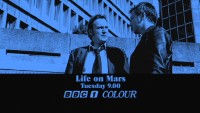 The second series of the critically-acclaimed drama Life On Mars (about a policeman who thinks that he’s living in 1973) was shown on BBC One and repeated on BBC Four during February and March of 2007. Red Bee Media was given the contract to produce promotional material for this series, and the end result was an imaginative collection of various items such as bus shelter posters and promotional clips which had been given a retro 1970s-style treatment.
The second series of the critically-acclaimed drama Life On Mars (about a policeman who thinks that he’s living in 1973) was shown on BBC One and repeated on BBC Four during February and March of 2007. Red Bee Media was given the contract to produce promotional material for this series, and the end result was an imaginative collection of various items such as bus shelter posters and promotional clips which had been given a retro 1970s-style treatment.
 Plus each episode of Life On Mars on BBC One began with a widescreen recreation of the style of globe ident that was in use during this era, whilst viewers in Wales were treated to a different, genuine mechanical globe complete with a voiceover provided by a continuity announcer who had worked during the early-’70s period. (Though BBC Wales didn’t actually use this type of globe until 1974.)
Plus each episode of Life On Mars on BBC One began with a widescreen recreation of the style of globe ident that was in use during this era, whilst viewers in Wales were treated to a different, genuine mechanical globe complete with a voiceover provided by a continuity announcer who had worked during the early-’70s period. (Though BBC Wales didn’t actually use this type of globe until 1974.)
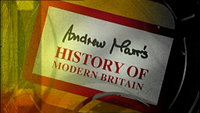 Other BBC One programmes in 2007 included the rather ambitious series Andrew Marr’s History of Modern Britain which attempted to cover a huge subject in five programmes broadcast between 22 May and 19 June, and its critical success resulted in a follow-up series entitled Andrew Marr’s The Making of Modern Britain.
Other BBC One programmes in 2007 included the rather ambitious series Andrew Marr’s History of Modern Britain which attempted to cover a huge subject in five programmes broadcast between 22 May and 19 June, and its critical success resulted in a follow-up series entitled Andrew Marr’s The Making of Modern Britain.
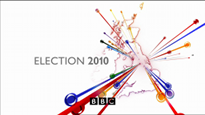 2010 saw a General Election in which a coalition government was returned, given no overall majority in the House of Commons. The BBC was on-hand to provide its comprehensive results service as is normal for such occasions, with its BBC News channel also providing rolling coverage once the main programme had drawn to a close.
2010 saw a General Election in which a coalition government was returned, given no overall majority in the House of Commons. The BBC was on-hand to provide its comprehensive results service as is normal for such occasions, with its BBC News channel also providing rolling coverage once the main programme had drawn to a close.
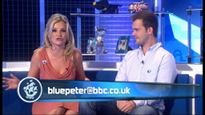 The first major department to move from London’s Television Centre to MediaCityUK in Salford Quays was children’s television, with the Blue Peter garden following Blue Peter to its new Salford home and is now a rooftop garden. This picture is taken from the very first Blue Peter to be broadcast from Salford, with the two regular presenters arriving via dramatic means – Helen Skelton by helicopter and Barney Harwood by jet ski.
The first major department to move from London’s Television Centre to MediaCityUK in Salford Quays was children’s television, with the Blue Peter garden following Blue Peter to its new Salford home and is now a rooftop garden. This picture is taken from the very first Blue Peter to be broadcast from Salford, with the two regular presenters arriving via dramatic means – Helen Skelton by helicopter and Barney Harwood by jet ski.


And finally…BBC North West Tonight was the last department to move out of Broadcasting House in Oxford Street, relocating to its new home in the BBC’s new MediaCityUK complex at nearby Salford, and is now based alongside the BBC’s children’s TV and sport departments (amongst others) that had already relocated there from London. Manchester’s Broadcasting House was opened in July 1976 and had formerly been the home for everything from Mark and Lard to Life On Mars over the years. Demolition of Broadcasting House commenced in August 2012 and had been completed by the end of March 2013.
 2012 was certainly a busy year for the BBC in terms of large public events; firstly there was the Queen’s Diamond Jubilee with its associated river pageant and concert to cover as well as the London Olympic Games later in the year. The BBC’s coverage of the pageant was, however, not one of its finest moments due to several technical problems meaning that many of the planned live links with boats taking part in the pageant had to be cancelled, inevitably resulting in land-based presenters such as Fearne Cotton being left with the task of filling in much more frequently than originally intended.
2012 was certainly a busy year for the BBC in terms of large public events; firstly there was the Queen’s Diamond Jubilee with its associated river pageant and concert to cover as well as the London Olympic Games later in the year. The BBC’s coverage of the pageant was, however, not one of its finest moments due to several technical problems meaning that many of the planned live links with boats taking part in the pageant had to be cancelled, inevitably resulting in land-based presenters such as Fearne Cotton being left with the task of filling in much more frequently than originally intended.
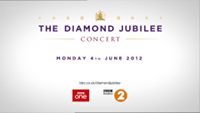 Thankfully the BBC’s coverage of the Diamond Jubilee concert went much more smoothly, even if there were a few complaints about concert sound quality from some viewers. Various big-name acts took to the stage, including Stevie Wonder, Annie Lennox, Robbie Williams, Tom Jones, Sir Cliff Richard, Grace Jones doing a highly memorable routine with a hula hoop to Slave to the Rhythm, and Madness performing on top of Buckingham Palace whilst various images were being projected on the front of the building. The end result was a concert which was watched by an average of nearly 15 million viewers.
Thankfully the BBC’s coverage of the Diamond Jubilee concert went much more smoothly, even if there were a few complaints about concert sound quality from some viewers. Various big-name acts took to the stage, including Stevie Wonder, Annie Lennox, Robbie Williams, Tom Jones, Sir Cliff Richard, Grace Jones doing a highly memorable routine with a hula hoop to Slave to the Rhythm, and Madness performing on top of Buckingham Palace whilst various images were being projected on the front of the building. The end result was a concert which was watched by an average of nearly 15 million viewers.


 Once in a lifetime…The London 2012 Olympic Games promised the biggest sporting spectacle the UK had ever seen, therefore it was the BBC’s obligation to provide the best and most comprehensive coverage possible for its viewers. Indeed the BBC devoted a very significant chunk of its resources to the Games as a consequence, which included an extra HD TV channel for digital terrestrial (Freeview) viewers, 30 additional HD channels for viewing via satellite, cable or online plus other radio and online resources. It wasn’t surprising therefore that an elaborate animated promotion was commissioned to promote the BBC’s wide-ranging coverage of such a major event.
Once in a lifetime…The London 2012 Olympic Games promised the biggest sporting spectacle the UK had ever seen, therefore it was the BBC’s obligation to provide the best and most comprehensive coverage possible for its viewers. Indeed the BBC devoted a very significant chunk of its resources to the Games as a consequence, which included an extra HD TV channel for digital terrestrial (Freeview) viewers, 30 additional HD channels for viewing via satellite, cable or online plus other radio and online resources. It wasn’t surprising therefore that an elaborate animated promotion was commissioned to promote the BBC’s wide-ranging coverage of such a major event.
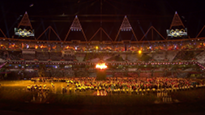 Shown on BBC1, BBC One HD and also on the BBC HD channel in 3D, the London 2012 Olympics Opening Ceremony was watched by a peak of 27 million viewers; that’s roughly half the population of the UK tuning in to watch at least some of the ceremony’s live coverage. Danny Boyle was responsible for producing and directing the ceremony’s elaborate routines, set design and special effects that culminated in the lighting of the Olympic cauldron by eight promising young athletes using the Olympic torch that had previously been carried around the UK by various selected individuals over the previous weeks.
Shown on BBC1, BBC One HD and also on the BBC HD channel in 3D, the London 2012 Olympics Opening Ceremony was watched by a peak of 27 million viewers; that’s roughly half the population of the UK tuning in to watch at least some of the ceremony’s live coverage. Danny Boyle was responsible for producing and directing the ceremony’s elaborate routines, set design and special effects that culminated in the lighting of the Olympic cauldron by eight promising young athletes using the Olympic torch that had previously been carried around the UK by various selected individuals over the previous weeks.
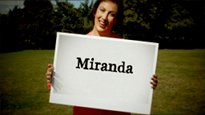 Despite recent distractions such as the aforementioned Olympics and Diamond Jubilee as well as the upheaval of moving staff and equipment out of Television Centre prior to its redevelopment, BBC One as a channel has continued to be a strong performer in terms of popular entertainment, factual programming, drama and comedy, with shows such as Strictly Come Dancing, Frozen Planet, Africa and Call the Midwife all attracting attention, with Miranda, Mrs Brown’s Boys and Outnumbered being three of the most popular comedies produced by the BBC in recent years. (Mrs Brown’s Boys is actually a co-production with Irish broadcaster RTÉ, who gets to broadcast each episode before the BBC does.)
Despite recent distractions such as the aforementioned Olympics and Diamond Jubilee as well as the upheaval of moving staff and equipment out of Television Centre prior to its redevelopment, BBC One as a channel has continued to be a strong performer in terms of popular entertainment, factual programming, drama and comedy, with shows such as Strictly Come Dancing, Frozen Planet, Africa and Call the Midwife all attracting attention, with Miranda, Mrs Brown’s Boys and Outnumbered being three of the most popular comedies produced by the BBC in recent years. (Mrs Brown’s Boys is actually a co-production with Irish broadcaster RTÉ, who gets to broadcast each episode before the BBC does.)
 Another important event for the BBC happened on 21 December 2012, which was the very last occasion when CBBC programmes were broadcast in a block on BBC One. Showing selected children’s television programmes on BBC One in the future isn’t out of the question, and there were plans to show series such as Horrible Histories in a teatime slot where they can be appreciated by a family audience as opposed to the (predominantly) children (and their parents) audience of the CBBC and CBeebies channels. Childrens’ television has perhaps been changed the most radically by the digital TV revolution, namely that many parents quickly opted to choose dedicated childrens’ TV channels for their children to watch when given the choice to do so.
Another important event for the BBC happened on 21 December 2012, which was the very last occasion when CBBC programmes were broadcast in a block on BBC One. Showing selected children’s television programmes on BBC One in the future isn’t out of the question, and there were plans to show series such as Horrible Histories in a teatime slot where they can be appreciated by a family audience as opposed to the (predominantly) children (and their parents) audience of the CBBC and CBeebies channels. Childrens’ television has perhaps been changed the most radically by the digital TV revolution, namely that many parents quickly opted to choose dedicated childrens’ TV channels for their children to watch when given the choice to do so.

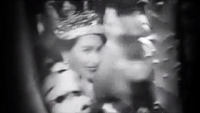
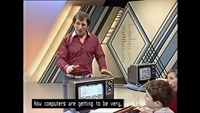
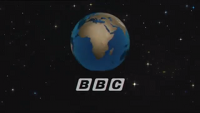 Where next…2012 also saw the BBC on the receiving end of some bad publicity in relation to the alleged antics of a now-deceased DJ and TV presenter Jimmy Savile, with some people thinking that BBC management at the time had some knowledge of Savile’s behind-the-scenes misbehaviour even though it’s almost certain that management at the time knew relatively little (if anything) as to what really happened, as well as most of his lewd behaviour occurring outside of BBC premises. Anyway, this breaking news story subsequently led to two misreporting mishaps primarily involving the BBC’s Newsnight current affairs programme that were most likely caused by major staff changes made in short succession leading to mistakes being made, but these incidents did somewhat tarnish the BBC’s reputation for scrupulously accurate current affairs reporting as a consequence, hence something was clearly needed to act as a PR offensive in order to repair the damage.
Where next…2012 also saw the BBC on the receiving end of some bad publicity in relation to the alleged antics of a now-deceased DJ and TV presenter Jimmy Savile, with some people thinking that BBC management at the time had some knowledge of Savile’s behind-the-scenes misbehaviour even though it’s almost certain that management at the time knew relatively little (if anything) as to what really happened, as well as most of his lewd behaviour occurring outside of BBC premises. Anyway, this breaking news story subsequently led to two misreporting mishaps primarily involving the BBC’s Newsnight current affairs programme that were most likely caused by major staff changes made in short succession leading to mistakes being made, but these incidents did somewhat tarnish the BBC’s reputation for scrupulously accurate current affairs reporting as a consequence, hence something was clearly needed to act as a PR offensive in order to repair the damage.
 Visually impressive in its design and scope, “Where Next?” sets out to remind the BBC’s viewers of all the good things the BBC has done over the years in terms of both programming and innovative firsts, starting with the British Broadcasting Company’s first radio broadcasts followed by the first TV broadcasts, the first live outside broadcast, the 1952 Coronation coverage, satellite broadcasting, the start of colour broadcasting on BBC2, Monty Python’s Flying Circus, CEEFAX, computer literacy with the BBC Micro, Newsround, Live Aid, Morph, Walking With Dinosaurs, The Office, Planet Earth on the iPlayer, Doctor Who and the online video streams for the 2012 Olympic Games, seamlessly linking one clip to another using all manner of visual trickery, and ending in a succession of BBC logos shown below an enduring symbol of BBC television, namely a globe.
Visually impressive in its design and scope, “Where Next?” sets out to remind the BBC’s viewers of all the good things the BBC has done over the years in terms of both programming and innovative firsts, starting with the British Broadcasting Company’s first radio broadcasts followed by the first TV broadcasts, the first live outside broadcast, the 1952 Coronation coverage, satellite broadcasting, the start of colour broadcasting on BBC2, Monty Python’s Flying Circus, CEEFAX, computer literacy with the BBC Micro, Newsround, Live Aid, Morph, Walking With Dinosaurs, The Office, Planet Earth on the iPlayer, Doctor Who and the online video streams for the 2012 Olympic Games, seamlessly linking one clip to another using all manner of visual trickery, and ending in a succession of BBC logos shown below an enduring symbol of BBC television, namely a globe.
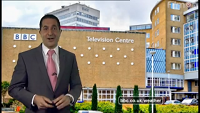 Moving out…As the BBC Television Centre site was now going to be substantially redeveloped to include apartments and office space amongst other uses including new television studios, the final BBC One news broadcast from the ‘old’ Television Centre took place on 18 March 2013, followed by programmes shown on 22 March comprising of a concert featuring the group Madness followed by a farewell programme: Goodbye Television Centre, both broadcast on BBC Four. Originally tried as a one-off Christmas special in 2015, 2016 saw the introduction of Michael McIntyre’s Big Show as a series with celebrity guests and features based around members of the public which recall earlier entertainment formats such as Noel’s House Party and The Late Late Breakfast Show.
Moving out…As the BBC Television Centre site was now going to be substantially redeveloped to include apartments and office space amongst other uses including new television studios, the final BBC One news broadcast from the ‘old’ Television Centre took place on 18 March 2013, followed by programmes shown on 22 March comprising of a concert featuring the group Madness followed by a farewell programme: Goodbye Television Centre, both broadcast on BBC Four. Originally tried as a one-off Christmas special in 2015, 2016 saw the introduction of Michael McIntyre’s Big Show as a series with celebrity guests and features based around members of the public which recall earlier entertainment formats such as Noel’s House Party and The Late Late Breakfast Show.
 BBC One’s on-screen identity based around circles had served the channel well for ten years but by the start of 2017 it was inevitably considered to be time for a new look for the channel. A new identity package was introduced that was built around the concept of ‘oneness’, namely the shared experiences of groups of people such as roller skaters (pictured), an exercise class, wheelchair athletes, tandem cyclists, night kayakers, etc., and inevitably this invited some comparisons with the dance-and-movement idents used from 2002-2006 except this time there was no dancing and no accompanying music.
BBC One’s on-screen identity based around circles had served the channel well for ten years but by the start of 2017 it was inevitably considered to be time for a new look for the channel. A new identity package was introduced that was built around the concept of ‘oneness’, namely the shared experiences of groups of people such as roller skaters (pictured), an exercise class, wheelchair athletes, tandem cyclists, night kayakers, etc., and inevitably this invited some comparisons with the dance-and-movement idents used from 2002-2006 except this time there was no dancing and no accompanying music.
 2017 also saw the delayed completion of Television Centre refurbishment under new owners, with BBC Studioworks (a separate private company) now in charge of Television Centre’s three studios and post-production facilities which officially re-opened on 1 September 2017, with programmes such as the new music show Sounds Like Friday Night already making use of them.
2017 also saw the delayed completion of Television Centre refurbishment under new owners, with BBC Studioworks (a separate private company) now in charge of Television Centre’s three studios and post-production facilities which officially re-opened on 1 September 2017, with programmes such as the new music show Sounds Like Friday Night already making use of them.
 Christmas 2017 saw the introduction of a new festive package of idents and on-screen graphics, and it soon became clear that there was a new star of the show (so to speak). A promotional animation featuring a girl and her father where the girl suffers stage fright at a school concert proved to be popular with many viewers, and also formed the basis for short ‘stings’ and idents shown during the Christmas period such as this pictured ident where father and daughter are trying to fix Christmas lights.
Christmas 2017 saw the introduction of a new festive package of idents and on-screen graphics, and it soon became clear that there was a new star of the show (so to speak). A promotional animation featuring a girl and her father where the girl suffers stage fright at a school concert proved to be popular with many viewers, and also formed the basis for short ‘stings’ and idents shown during the Christmas period such as this pictured ident where father and daughter are trying to fix Christmas lights.
 From early 2018 the BBC began a gradual corporate-wide roll out of a new font entitled ‘Reith’ to replace Gill Sans (Gill Sans also requiring an expensive corporate licence for its usage), though the new font wasn’t generally used for on-screen presentation until October 2021 when a new look was introduced across most of the television channels. Some areas such as News and online had to wait a little longer before updating, so initially the BBC logo refresh wasn’t as comprehensive as it was back in 1997.
From early 2018 the BBC began a gradual corporate-wide roll out of a new font entitled ‘Reith’ to replace Gill Sans (Gill Sans also requiring an expensive corporate licence for its usage), though the new font wasn’t generally used for on-screen presentation until October 2021 when a new look was introduced across most of the television channels. Some areas such as News and online had to wait a little longer before updating, so initially the BBC logo refresh wasn’t as comprehensive as it was back in 1997.
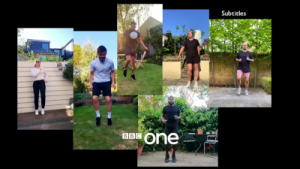 The beginning of 2020 saw a major global COVID pandemic breaking out which necessitated a fundamental rethink of ‘Oneness’ as a branding concept for BBC One, because if groups of people could no longer safely congregate together for fear of transmitting a potentially deadly virus, showing groups of people as ‘Oneness’ would obviously be no longer appropriate. Hence ‘lockdown Oneness’ was introduced, with a new selection of idents showing groups of people, pets or objects in separate rectangles but congregated together virtually, therefore showing solidarity with people confined to their homes for health reasons. Likewise various programmes were badly affected by social distancing measures introduced to avoid infection; the production of drama series such as EastEnders were put on hold and other programmes such as Have I Got News For You, The One Show and The Ranganation were rejigged to avoid using studio audiences as well as making use of ‘virtual guests’ using video links.
The beginning of 2020 saw a major global COVID pandemic breaking out which necessitated a fundamental rethink of ‘Oneness’ as a branding concept for BBC One, because if groups of people could no longer safely congregate together for fear of transmitting a potentially deadly virus, showing groups of people as ‘Oneness’ would obviously be no longer appropriate. Hence ‘lockdown Oneness’ was introduced, with a new selection of idents showing groups of people, pets or objects in separate rectangles but congregated together virtually, therefore showing solidarity with people confined to their homes for health reasons. Likewise various programmes were badly affected by social distancing measures introduced to avoid infection; the production of drama series such as EastEnders were put on hold and other programmes such as Have I Got News For You, The One Show and The Ranganation were rejigged to avoid using studio audiences as well as making use of ‘virtual guests’ using video links.
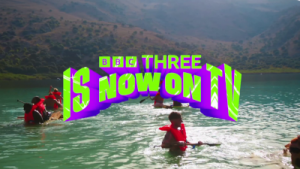 One surprise was the return of BBC Three as a TV channel in February 2022. Obviously it was thought that BBC Three was still a valuable proposition as a traditional linear TV channel and it still wasn’t as relevant when restricted as an iPlayer-only service. Clearly linear TV is still appreciated by lots of young people despite the rise of the BBC’s iPlayer and commercial streaming services such as Netflix, Disney+ and Amazon Prime Video.
One surprise was the return of BBC Three as a TV channel in February 2022. Obviously it was thought that BBC Three was still a valuable proposition as a traditional linear TV channel and it still wasn’t as relevant when restricted as an iPlayer-only service. Clearly linear TV is still appreciated by lots of young people despite the rise of the BBC’s iPlayer and commercial streaming services such as Netflix, Disney+ and Amazon Prime Video.
 The worldwide decline of the ‘soap opera’ (serial drama) combined with recent budget cuts caused by government freezing of the TV licence fee (still the BBC’s primary income at this point) meant that the BBC took a decision to cancel medical drama series Holby City. On air since 12 January 1999, Holby City was basically a complementary series to Casualty. The last episode was transmitted on 29 March 2022 and Holby City as a whole was fundamentally a ‘love letter’ to the NHS.
The worldwide decline of the ‘soap opera’ (serial drama) combined with recent budget cuts caused by government freezing of the TV licence fee (still the BBC’s primary income at this point) meant that the BBC took a decision to cancel medical drama series Holby City. On air since 12 January 1999, Holby City was basically a complementary series to Casualty. The last episode was transmitted on 29 March 2022 and Holby City as a whole was fundamentally a ‘love letter’ to the NHS.
 1 April 2022 finally saw the previously-delayed introduction of new ‘lens’ idents based around a rotating ‘sphere’ or lens effect incorporating two or more live action scenes. Several idents feature different scenes including a dance floor, park bench, skateboard park and outdoors late at night.
1 April 2022 finally saw the previously-delayed introduction of new ‘lens’ idents based around a rotating ‘sphere’ or lens effect incorporating two or more live action scenes. Several idents feature different scenes including a dance floor, park bench, skateboard park and outdoors late at night.
 2022 represents a major milestone for the BBC as a whole, being the 100th anniversary of both the BBC being incorporated as a company (18 October) and the first 2LO broadcast on November 14…
2022 represents a major milestone for the BBC as a whole, being the 100th anniversary of both the BBC being incorporated as a company (18 October) and the first 2LO broadcast on November 14…
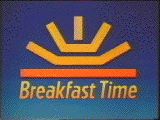 There had been occasional attempts at breakfast television in the UK previously (Yorkshire Television’s Good Morning Calendar for ITV (Yorkshire region only) in 1977 and later on BBC1’s Swap Shop tried an earlier start with AM-UK), but the market for breakfast television was still considered to be limited in the UK because it was thought that most people might be too busy to watch television at that time of the day. Once a commercial breakfast television franchise had been created and awarded to TV-am in 1980 alongside other ITV franchise changes, TV-am’s launch was scheduled for 1 February 1983 in order to avoid the other ITV franchise changes at the start of 1982 as well as the launch of Channel 4 the following November. However the BBC decided to get in first with a ‘spoiler’ programme, namely Breakfast Time on BBC1 which launched a month earlier, and much to TV-am’s dismay (they were due on air shortly) it was not the serious news programme some thought it might have been, but was a direct competitor which helped to hit TV-am’s initial viewing figures badly. Later on, Breakfast Time was scrapped and replaced with a more serious BBC Breakfast News format.
There had been occasional attempts at breakfast television in the UK previously (Yorkshire Television’s Good Morning Calendar for ITV (Yorkshire region only) in 1977 and later on BBC1’s Swap Shop tried an earlier start with AM-UK), but the market for breakfast television was still considered to be limited in the UK because it was thought that most people might be too busy to watch television at that time of the day. Once a commercial breakfast television franchise had been created and awarded to TV-am in 1980 alongside other ITV franchise changes, TV-am’s launch was scheduled for 1 February 1983 in order to avoid the other ITV franchise changes at the start of 1982 as well as the launch of Channel 4 the following November. However the BBC decided to get in first with a ‘spoiler’ programme, namely Breakfast Time on BBC1 which launched a month earlier, and much to TV-am’s dismay (they were due on air shortly) it was not the serious news programme some thought it might have been, but was a direct competitor which helped to hit TV-am’s initial viewing figures badly. Later on, Breakfast Time was scrapped and replaced with a more serious BBC Breakfast News format. TV-am followed swiftly afterwards, launched with a barrage of publicity on 1st February 1983. It featured a mixture of familiar and unfamiliar presenters (David Frost being the key figure) and had a ‘bright and breezy’ approach to waking the nation up in the morning. Expectations were set high for the new service, but in reality there were several unanswered questions; most notably just how many people in the UK were prepared to watch television instead of listening to the radio at that time of day especially given the BBC1 competition.
TV-am followed swiftly afterwards, launched with a barrage of publicity on 1st February 1983. It featured a mixture of familiar and unfamiliar presenters (David Frost being the key figure) and had a ‘bright and breezy’ approach to waking the nation up in the morning. Expectations were set high for the new service, but in reality there were several unanswered questions; most notably just how many people in the UK were prepared to watch television instead of listening to the radio at that time of day especially given the BBC1 competition.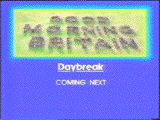 The main breakfast show’s title Good Morning Britain – a title since revived by ITV but with no connection to the TV-am original – deliberately echoed the similar US programme Good Morning America, and the British show had much in common with its American counterpart, such as the use of an on-screen clock, and the use of a caption to tell viewers what was to follow the commercial break. TV-am also made other programmes to show during its allocated time slot, such as Daybreak (the same title also used much later by ITV for its unconnected breakfast show), Data Run, and Wacaday presented by Timmy Mallet.
The main breakfast show’s title Good Morning Britain – a title since revived by ITV but with no connection to the TV-am original – deliberately echoed the similar US programme Good Morning America, and the British show had much in common with its American counterpart, such as the use of an on-screen clock, and the use of a caption to tell viewers what was to follow the commercial break. TV-am also made other programmes to show during its allocated time slot, such as Daybreak (the same title also used much later by ITV for its unconnected breakfast show), Data Run, and Wacaday presented by Timmy Mallet.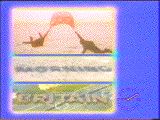 After the commercial break had finished, this caption was shown, which also features the on-screen clock (showing ten past nine, in the bottom-right hand corner). By April TV-am’s future looked bleak – viewing figures had plummeted to about 100,000, partly courtesy of what was considered to be surprisingly strong competition from Breakfast Time. (Anyone remember Russell Grant’s horoscopes?) So Greg Dyke was brought in from London Weekend Television to try and improve things – David Frost was replaced by Nick Owen and TV-am went downmarket, successfully reversing the drop.
After the commercial break had finished, this caption was shown, which also features the on-screen clock (showing ten past nine, in the bottom-right hand corner). By April TV-am’s future looked bleak – viewing figures had plummeted to about 100,000, partly courtesy of what was considered to be surprisingly strong competition from Breakfast Time. (Anyone remember Russell Grant’s horoscopes?) So Greg Dyke was brought in from London Weekend Television to try and improve things – David Frost was replaced by Nick Owen and TV-am went downmarket, successfully reversing the drop.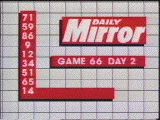 At the time there was a craze among tabloid newspapers for running bingo competitions, so a bright idea was to tell the viewers what the day’s numbers were so they didn’t have to buy the newspaper. Occasionally the numbers were misread, though any mistakes were inevitably corrected. Nick Owen bizarrely had to dress up in a beefeater’s outfit and blow a trumpet to introduce this part of the programme!
At the time there was a craze among tabloid newspapers for running bingo competitions, so a bright idea was to tell the viewers what the day’s numbers were so they didn’t have to buy the newspaper. Occasionally the numbers were misread, though any mistakes were inevitably corrected. Nick Owen bizarrely had to dress up in a beefeater’s outfit and blow a trumpet to introduce this part of the programme!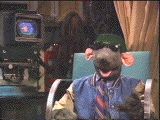 Roland Rat was also introduced as part of the April shake-up. Created by David Claridge and introduced to TV-am by Anne ‘Teletubbies’ Wood, Roland Rat proved to be very popular with the viewers and gave the breakfast start-up a much needed shot in the arm. Rat mania even spawned two UK Top 40 records in 1983/4 – Rat Rapping and Love Me Tender. Anne Diamond also had to work alongside ‘Roland Rat Superstar’ which must have been a tough act to keep up with! Thankfully Roland Rat is still very much alive today…
Roland Rat was also introduced as part of the April shake-up. Created by David Claridge and introduced to TV-am by Anne ‘Teletubbies’ Wood, Roland Rat proved to be very popular with the viewers and gave the breakfast start-up a much needed shot in the arm. Rat mania even spawned two UK Top 40 records in 1983/4 – Rat Rapping and Love Me Tender. Anne Diamond also had to work alongside ‘Roland Rat Superstar’ which must have been a tough act to keep up with! Thankfully Roland Rat is still very much alive today…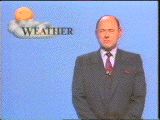 The weather forecast was presented by Commander Philpott, whose style was certainly different from the competition – come to think of it anything else past or present. ‘Stiff upper lip British’ was perhaps the best way to describe the Commander’s technique.
The weather forecast was presented by Commander Philpott, whose style was certainly different from the competition – come to think of it anything else past or present. ‘Stiff upper lip British’ was perhaps the best way to describe the Commander’s technique.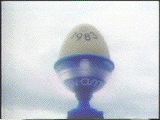 This caption was shown at the end of the programme, with one egg cup added to the picture for each year since 1983 (1984 = two egg cups displayed, etc.), though in later years only a few of the cups actually appeared in the caption. TV-am was a programme contractor in its own right, and was independent of the other companies that formed the ITV network.
This caption was shown at the end of the programme, with one egg cup added to the picture for each year since 1983 (1984 = two egg cups displayed, etc.), though in later years only a few of the cups actually appeared in the caption. TV-am was a programme contractor in its own right, and was independent of the other companies that formed the ITV network.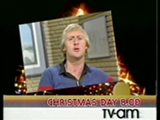 TV-am also promoted its shows at other times on the ITV network, with this example promoting Chris Tarrant and Roland Rat appearing on Christmas Day 1984 and a Princess Anne interview shown on Boxing Day.
TV-am also promoted its shows at other times on the ITV network, with this example promoting Chris Tarrant and Roland Rat appearing on Christmas Day 1984 and a Princess Anne interview shown on Boxing Day.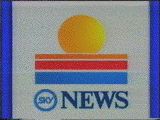 TV-am did its own news gathering in early years, but later on the news was provided by Rupert Murdoch’s Sky News until TV-am’s demise at the end of 1992.
TV-am did its own news gathering in early years, but later on the news was provided by Rupert Murdoch’s Sky News until TV-am’s demise at the end of 1992. TV-am were among the losers when the ITV broadcasting franchises were reviewed in 1991, so from the 1st January 1993 TV-am was replaced by GMTV. This picture was the very last to be transmitted by TV-am; the colour of the main scene was faded moments before the picture faded abruptly. An era had come to an end.
TV-am were among the losers when the ITV broadcasting franchises were reviewed in 1991, so from the 1st January 1993 TV-am was replaced by GMTV. This picture was the very last to be transmitted by TV-am; the colour of the main scene was faded moments before the picture faded abruptly. An era had come to an end. TV-am’s replacement, GMTV (which prior to 2004 was part-owned by Carlton, Granada and Disney) to begin with tried to establish its own identity but slowly evolved over the years into something that looks very similar to TV-am, and also provided signed news and additional cartoons on ITV2 during the same timeslot for a while under the GMTV2 banner, though (like TV-am) GMTV and ITV are technically two separate entities that just happen to use the same channel. Whilst GMTV was a separate entity from ITV, if ITV wanted to ‘borrow’ time from GMTV in order (for example) to show a sporting event, it had to compensate GMTV somehow (either financially or by giving GMTV additional air time) as a result. GMTV ceased to exist after ITV plc bought out Disney’s share of the broadcaster and what was still a physically separate commercial television franchise became fully integrated into the ITV channel as Daybreak. Later on the separate breakfast franchise was abolished by the Digital Economy Act and Daybreak has since been replaced by Good Morning Britain; nothing to do with TV-am but using the same name as TV-am’s original breakfast show.
TV-am’s replacement, GMTV (which prior to 2004 was part-owned by Carlton, Granada and Disney) to begin with tried to establish its own identity but slowly evolved over the years into something that looks very similar to TV-am, and also provided signed news and additional cartoons on ITV2 during the same timeslot for a while under the GMTV2 banner, though (like TV-am) GMTV and ITV are technically two separate entities that just happen to use the same channel. Whilst GMTV was a separate entity from ITV, if ITV wanted to ‘borrow’ time from GMTV in order (for example) to show a sporting event, it had to compensate GMTV somehow (either financially or by giving GMTV additional air time) as a result. GMTV ceased to exist after ITV plc bought out Disney’s share of the broadcaster and what was still a physically separate commercial television franchise became fully integrated into the ITV channel as Daybreak. Later on the separate breakfast franchise was abolished by the Digital Economy Act and Daybreak has since been replaced by Good Morning Britain; nothing to do with TV-am but using the same name as TV-am’s original breakfast show.

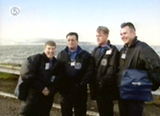 In the late 1980s attention was diverted momentarily to satellite tv in the guise of BSB, though this was ‘merged’ with the News Corp.-owned Sky service in 1990. Initially it was envisaged that the remaining terrestrial allocations would be used for local services, but a change of heart caused by a lack of suitable applicants combined with a desire to generate revenue caused a fifth ‘national’ service to be born. It was essentially a two-horse race, with the winner having to arrange for thousands of video recorders, games consoles, etc. to be adjusted because a common frequency used to distribute video signals (UHF channel 36) was widely used by Channel 5. Retuning delays forced a planned December 1996 launch to be postponed.
In the late 1980s attention was diverted momentarily to satellite tv in the guise of BSB, though this was ‘merged’ with the News Corp.-owned Sky service in 1990. Initially it was envisaged that the remaining terrestrial allocations would be used for local services, but a change of heart caused by a lack of suitable applicants combined with a desire to generate revenue caused a fifth ‘national’ service to be born. It was essentially a two-horse race, with the winner having to arrange for thousands of video recorders, games consoles, etc. to be adjusted because a common frequency used to distribute video signals (UHF channel 36) was widely used by Channel 5. Retuning delays forced a planned December 1996 launch to be postponed.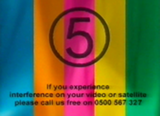 Channel 5 was launched on Saturday March 30 1997 into what was a much more hostile media climate than what existed at the start of the previous four services. As well as the other four terrestrial channels, Channel 5 has to compete against the numerous and growing number of satellite channels, as well as (arguably) ‘new media’ services such as the internet (which was starting to grow rapidly at the time); these rival services also happen to attract mostly the young target audience that the new channel was aiming at. To cap it all, due to the restricted coverage, less than 70% of the country could receive it, and many of those that could had to suffer an inferior picture due to many transmitters operating on a lower power.
Channel 5 was launched on Saturday March 30 1997 into what was a much more hostile media climate than what existed at the start of the previous four services. As well as the other four terrestrial channels, Channel 5 has to compete against the numerous and growing number of satellite channels, as well as (arguably) ‘new media’ services such as the internet (which was starting to grow rapidly at the time); these rival services also happen to attract mostly the young target audience that the new channel was aiming at. To cap it all, due to the restricted coverage, less than 70% of the country could receive it, and many of those that could had to suffer an inferior picture due to many transmitters operating on a lower power.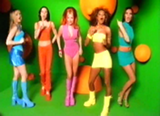 Who better to launch a new tv channel wanting to portray a young image than the hottest popular music act of the moment which also happens to have five members as well! Enter the Spice Girls, performing a song based on Manfred Mann’s “5-4-3-2-1” (same tune, different lyrics: retitled “1-2-3-4-5”). Trivia time: Channel 5 is the only terrestrial station never to have had a test card (though before launch it did have a tuning signal caption), and has provided a 24-hour service from day one. It was also the only terrestrial station to feature a permanent on-screen identification ‘bug’ or DOG (digitally originated graphic) at the time, though they subsequently made the symbol less prominent before ditching it altogether with the change from Channel 5 to “Five”, then it appeared again with a later rebrand.
Who better to launch a new tv channel wanting to portray a young image than the hottest popular music act of the moment which also happens to have five members as well! Enter the Spice Girls, performing a song based on Manfred Mann’s “5-4-3-2-1” (same tune, different lyrics: retitled “1-2-3-4-5”). Trivia time: Channel 5 is the only terrestrial station never to have had a test card (though before launch it did have a tuning signal caption), and has provided a 24-hour service from day one. It was also the only terrestrial station to feature a permanent on-screen identification ‘bug’ or DOG (digitally originated graphic) at the time, though they subsequently made the symbol less prominent before ditching it altogether with the change from Channel 5 to “Five”, then it appeared again with a later rebrand.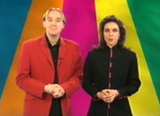 Tim Vine and Julia Bradbury presented the very first programme at 6 pm, showing highlights of forthcoming programmes. The channel (like those before it) was aiming to be different from existing services, though some of the ideas were ‘borrowed’ from various sources. The concept of a short news bulletin (except during movies) every hour is similar to many radio stations, and having a ‘stripped and stranded’ schedule whereby the same type of programming is shown at the same time slot every weekday was a practice already adopted by various satellite channels.
Tim Vine and Julia Bradbury presented the very first programme at 6 pm, showing highlights of forthcoming programmes. The channel (like those before it) was aiming to be different from existing services, though some of the ideas were ‘borrowed’ from various sources. The concept of a short news bulletin (except during movies) every hour is similar to many radio stations, and having a ‘stripped and stranded’ schedule whereby the same type of programming is shown at the same time slot every weekday was a practice already adopted by various satellite channels.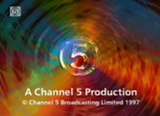 The channel’s programming arrangements are identical to that of Channel 4; most programming is provided by ‘independent’ producers, though some of the production companies that were originally used such as Grundy were owned by Fremantle Media (now Talkback Thames), whose parent company (Bertlesmann/RTL) at the time owned a majority share in Channel 5.
The channel’s programming arrangements are identical to that of Channel 4; most programming is provided by ‘independent’ producers, though some of the production companies that were originally used such as Grundy were owned by Fremantle Media (now Talkback Thames), whose parent company (Bertlesmann/RTL) at the time owned a majority share in Channel 5.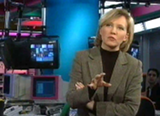 Where Channel 5 really innovated was its news service. As well as the concept of short hourly bulletins which was new at least to terrestrial television in the UK, there were differences in the presentation and content of the main news programme (initially shown at 8:30 pm). Channel 5’s original lineup of news presenters included Kirsty Young (pictured), Rob Butler, Scott Chisholm and Charlie Stayt.
Where Channel 5 really innovated was its news service. As well as the concept of short hourly bulletins which was new at least to terrestrial television in the UK, there were differences in the presentation and content of the main news programme (initially shown at 8:30 pm). Channel 5’s original lineup of news presenters included Kirsty Young (pictured), Rob Butler, Scott Chisholm and Charlie Stayt. Originally produced by ITN (who also provide ITV and Channel 4 news programming), Channel 5 News aims to be highly visual yet informative but at the same time less formal in style – for example the presenter does not sit at a desk as is traditional. The end result has won various awards. Kirsty Young later moved to ITV, and Sky took over production of Five News for a while before it reverted back to ITN more recently.
Originally produced by ITN (who also provide ITV and Channel 4 news programming), Channel 5 News aims to be highly visual yet informative but at the same time less formal in style – for example the presenter does not sit at a desk as is traditional. The end result has won various awards. Kirsty Young later moved to ITV, and Sky took over production of Five News for a while before it reverted back to ITN more recently. Here is Channel 5’s first Monday evening lineup with wildlife, property, a film and comedy all featuring in the schedule as well as news bulletins every hour. None of the featured programmes are still on-air.
Here is Channel 5’s first Monday evening lineup with wildlife, property, a film and comedy all featuring in the schedule as well as news bulletins every hour. None of the featured programmes are still on-air.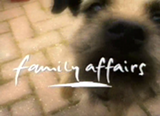 General purpose tv channels try to feature at least one soap opera in their schedule; the home-grown effort is entitled Family Affairs which finished at the end of 2005, though the channel for a while also showed imported US soaps such as Melrose Place and Sunset Beach which were hitherto only viewable on satellite channels in the UK. Nowadays it is Neighbours that fulfils the channel’s soap opera quotient; something that used to be shown on daytime BBC1 from 1986 to 2008.
General purpose tv channels try to feature at least one soap opera in their schedule; the home-grown effort is entitled Family Affairs which finished at the end of 2005, though the channel for a while also showed imported US soaps such as Melrose Place and Sunset Beach which were hitherto only viewable on satellite channels in the UK. Nowadays it is Neighbours that fulfils the channel’s soap opera quotient; something that used to be shown on daytime BBC1 from 1986 to 2008.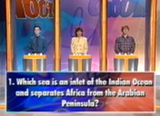 The early evening period (originally 5:30-6:30pm) during Monday to Friday was initially used for now defunct quiz shows such as 100% (pictured) and Whittle; the latter being suspiciously similar in format to a quiz previously tried by ITV and then dropped. 100% featured three contenstants answering 100 multiple choice questions – the person at the end with the highest percentage of correct answers wins £100 and is invited back to appear on the next show. This format was later extended for 100% Gold (for older people) and 100% Challenge (featuring winners from Mastermind), as well as a variety of special one-off programmes devoted to specialist subjects.
The early evening period (originally 5:30-6:30pm) during Monday to Friday was initially used for now defunct quiz shows such as 100% (pictured) and Whittle; the latter being suspiciously similar in format to a quiz previously tried by ITV and then dropped. 100% featured three contenstants answering 100 multiple choice questions – the person at the end with the highest percentage of correct answers wins £100 and is invited back to appear on the next show. This format was later extended for 100% Gold (for older people) and 100% Challenge (featuring winners from Mastermind), as well as a variety of special one-off programmes devoted to specialist subjects. Channel 5 often shows programmes featuring animals of some description, whether it is about the work of a wildlife sanctuary (Wildlife SOS, pictured), or wild animals in continents such as Africa.
Channel 5 often shows programmes featuring animals of some description, whether it is about the work of a wildlife sanctuary (Wildlife SOS, pictured), or wild animals in continents such as Africa.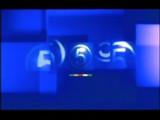 For its first four or so years, Channel 5’s audience share was still small compared with the other four terrestrial channels, but the channel’s majority shareholder (Bertlesmann/RTL) had other plans. Indeed RTL openly declared that they were no longer interested in acquiring any part of ITV and are concentrating their efforts instead on improving Channel 5’s audience figures in the UK which included a major investment in new programming. However Channel 5 still had a decidedly downmarket image that sometimes even included soft porn after the 9 pm watershed, so major moves were required to improve this situation.
For its first four or so years, Channel 5’s audience share was still small compared with the other four terrestrial channels, but the channel’s majority shareholder (Bertlesmann/RTL) had other plans. Indeed RTL openly declared that they were no longer interested in acquiring any part of ITV and are concentrating their efforts instead on improving Channel 5’s audience figures in the UK which included a major investment in new programming. However Channel 5 still had a decidedly downmarket image that sometimes even included soft porn after the 9 pm watershed, so major moves were required to improve this situation.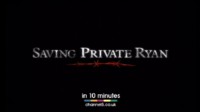 With Dawn Airey as programme controller (she recently defected to BSkyB), some radical moves were made in order to improve Channel 5’s programming along with its reputation. Its one quality import, CSI: Crime Scene Investigation was heavily promoted in quality newspapers, and changes were made to the schedule such as the axing of Night Fever and the acquisition of Home and Away which was originally shown on ITV. The channel even put in a bid for The Simpsons which caught Channel 4 by surprise and helped escalate the bidding war as a result, but better programmes were just one part of its quest for self-improvement.
With Dawn Airey as programme controller (she recently defected to BSkyB), some radical moves were made in order to improve Channel 5’s programming along with its reputation. Its one quality import, CSI: Crime Scene Investigation was heavily promoted in quality newspapers, and changes were made to the schedule such as the axing of Night Fever and the acquisition of Home and Away which was originally shown on ITV. The channel even put in a bid for The Simpsons which caught Channel 4 by surprise and helped escalate the bidding war as a result, but better programmes were just one part of its quest for self-improvement.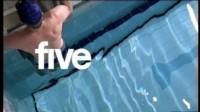 In order to convince more people to start watching the channel on a regular basis, some drastic action was taken. Firstly what was known as Channel 5 is now simply known as Five, with the word being used in lower case as a logo. The rebranding was accompanied by a whole new presentation package which includes a mixture of new live action-based and plain idents with the word ‘five’ often appearing and disappearing with a 3D effect; the ‘five stripes’ device (shown above) also being abandoned in preference to individually using five shades of five colours for text and background colours.
In order to convince more people to start watching the channel on a regular basis, some drastic action was taken. Firstly what was known as Channel 5 is now simply known as Five, with the word being used in lower case as a logo. The rebranding was accompanied by a whole new presentation package which includes a mixture of new live action-based and plain idents with the word ‘five’ often appearing and disappearing with a 3D effect; the ‘five stripes’ device (shown above) also being abandoned in preference to individually using five shades of five colours for text and background colours.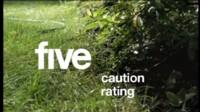 But it didn’t stop there – Five scrapped the contentious permanent on-screen logo for the time being so it would be identified more closely with the other four terrestrial channels. Five’s presentation package was developed by the same agency (Spin) that worked on the previous Channel 4 idents, hence some general similarities between the two channels’ overall presentation until Channel 4 changed its on-air identity on 31 December 2004. The channel was at this point 100% owned by RTL, the Bertlesmann-owned company that operates various other European TV channels, after UBM (United Business Media) sold its stake in July 2005, but that state of affairs wasn’t to last forever.
But it didn’t stop there – Five scrapped the contentious permanent on-screen logo for the time being so it would be identified more closely with the other four terrestrial channels. Five’s presentation package was developed by the same agency (Spin) that worked on the previous Channel 4 idents, hence some general similarities between the two channels’ overall presentation until Channel 4 changed its on-air identity on 31 December 2004. The channel was at this point 100% owned by RTL, the Bertlesmann-owned company that operates various other European TV channels, after UBM (United Business Media) sold its stake in July 2005, but that state of affairs wasn’t to last forever.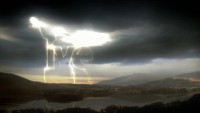

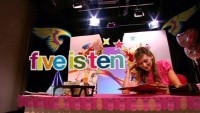 March 30 2007 was Channel Five’s tenth anniversary, and the channel celebrated with an evening of special programmes featuring (amongst other things) a group of ten year-olds interviewing the potential future prime minister Gordon Brown, ‘reality TV’ offering The Ten Demandments, and a light-hearted quiz entitled Blame it on the Spice Girls. Quite. Also Channel Five acquired the rights to show the Australian soap opera Neighbours, of which it started to show from 2008 when the BBC’s contract expired.
March 30 2007 was Channel Five’s tenth anniversary, and the channel celebrated with an evening of special programmes featuring (amongst other things) a group of ten year-olds interviewing the potential future prime minister Gordon Brown, ‘reality TV’ offering The Ten Demandments, and a light-hearted quiz entitled Blame it on the Spice Girls. Quite. Also Channel Five acquired the rights to show the Australian soap opera Neighbours, of which it started to show from 2008 when the BBC’s contract expired.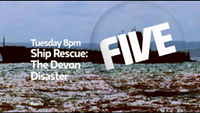 It wasn’t long (October 2008) before Channel Five had yet another image makeover, with a change of font for the FIVE logo which now appeared in capitals within a circle and yet more idents as a consequence. Earlier that same year, Dawn Airey had been rehired from ITV and promptly went on a cost-cutting spree at the channel. Programmes shown during this era included Paul Merton in India, Grey’s Anatomy, Police Interceptors and the return of quiz Going for Gold along with the CSI franchise acquired via a pan-European deal with parent company RTL.
It wasn’t long (October 2008) before Channel Five had yet another image makeover, with a change of font for the FIVE logo which now appeared in capitals within a circle and yet more idents as a consequence. Earlier that same year, Dawn Airey had been rehired from ITV and promptly went on a cost-cutting spree at the channel. Programmes shown during this era included Paul Merton in India, Grey’s Anatomy, Police Interceptors and the return of quiz Going for Gold along with the CSI franchise acquired via a pan-European deal with parent company RTL. Despite all the hard work, it just wasn’t enough. Five’s German owner RTL was rapidly running out of patience with what it had dubbed “the English patient” in its European channel portfolio, having written off a large debt in 2009 and made a decision to only concentrate on owning broadcasters and channels that were either first or second in terms of popularity in their native countries, meaning that it was now actively willing to sell off Five to another company. BSkyB had long been suspected of being a potential buyer of Five, but it had primarily concentrated on pay-TV broadcasting via satellite with its free-to-air channels on Freeview being an ‘accidental’ sideshow perhaps to avoid its desirable channel slots falling into the hands of competitors, therefore the eventual buyer of Five turned out to be Richard Desmond and his media empire which includes the Express and Star newspapers. The company changed hands on 23 July 2010 for £103.5m.
Despite all the hard work, it just wasn’t enough. Five’s German owner RTL was rapidly running out of patience with what it had dubbed “the English patient” in its European channel portfolio, having written off a large debt in 2009 and made a decision to only concentrate on owning broadcasters and channels that were either first or second in terms of popularity in their native countries, meaning that it was now actively willing to sell off Five to another company. BSkyB had long been suspected of being a potential buyer of Five, but it had primarily concentrated on pay-TV broadcasting via satellite with its free-to-air channels on Freeview being an ‘accidental’ sideshow perhaps to avoid its desirable channel slots falling into the hands of competitors, therefore the eventual buyer of Five turned out to be Richard Desmond and his media empire which includes the Express and Star newspapers. The company changed hands on 23 July 2010 for £103.5m. From Five to 5…Another thing on Richard Desmond’s to-do list was changing the name back to Channel 5 because he felt that the original brand resonated more strongly with the public, and he wasted no time in doing such a thing, therefore new idents, etc., were commissioned to go with the new name.
From Five to 5…Another thing on Richard Desmond’s to-do list was changing the name back to Channel 5 because he felt that the original brand resonated more strongly with the public, and he wasted no time in doing such a thing, therefore new idents, etc., were commissioned to go with the new name.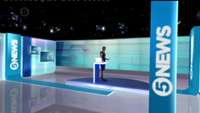 With the new identity came a new look for 5 News, which still maintained the “standing up” ethos that Channel 5 had made its own from the beginning.
With the new identity came a new look for 5 News, which still maintained the “standing up” ethos that Channel 5 had made its own from the beginning.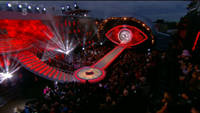 Perfect match…Upon acquiring Five, Richard Desmond made several bold and somewhat rash claims relating to what he wanted to do with the broadcaster that were probably not meant to be taken seriously, such as acquiring EastEnders of all things (!!!), but he did say he wanted to make a big programming acquisition from another channel. That turned out to be Big Brother: a reality TV series which had gone into decline when shown on Channel 4 as well as being perceived to have tarnished Channel 4’s reputation as a broadcaster, therefore Desmond was able to acquire the rights to Big Brother when they came up for renewal. Big Brother, Celebrity Big Brother and their various spin-off programmes have been solid performers for Channel 5, which proved how good the fit between programme format and broadcaster turned out to be.
Perfect match…Upon acquiring Five, Richard Desmond made several bold and somewhat rash claims relating to what he wanted to do with the broadcaster that were probably not meant to be taken seriously, such as acquiring EastEnders of all things (!!!), but he did say he wanted to make a big programming acquisition from another channel. That turned out to be Big Brother: a reality TV series which had gone into decline when shown on Channel 4 as well as being perceived to have tarnished Channel 4’s reputation as a broadcaster, therefore Desmond was able to acquire the rights to Big Brother when they came up for renewal. Big Brother, Celebrity Big Brother and their various spin-off programmes have been solid performers for Channel 5, which proved how good the fit between programme format and broadcaster turned out to be. Although initially regulated by the Independent Broadcasting Authority (IBA) with financial cross-subsidy from the ITV franchises, Channel 4 was a broadcaster designed to be independent from ITV, but due to a perceived high risk of financial failure such measures were necessary along with ITV franchises providing some of the programming and being responsible for the channel’s advertising sales, effectively leaving Channel 4 to do what it wanted without having to specifically pander to any of its advertisers. Its remit was and still is essentially similar to BBC2, namely producing specialist programmes for a smaller audience as well as popular programmes, though to begin with Channel 4 was unique in that the majority of programmes were commissioned from small independent production companies.
Although initially regulated by the Independent Broadcasting Authority (IBA) with financial cross-subsidy from the ITV franchises, Channel 4 was a broadcaster designed to be independent from ITV, but due to a perceived high risk of financial failure such measures were necessary along with ITV franchises providing some of the programming and being responsible for the channel’s advertising sales, effectively leaving Channel 4 to do what it wanted without having to specifically pander to any of its advertisers. Its remit was and still is essentially similar to BBC2, namely producing specialist programmes for a smaller audience as well as popular programmes, though to begin with Channel 4 was unique in that the majority of programmes were commissioned from small independent production companies.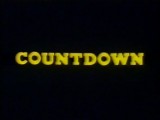 Channel 4 launched with a sequence showing clips from various forthcoming programmes, but the very first programme to be shown on Channel 4 when it finally launched on 2 November 1982 was Countdown. Based on a long-running French TV quiz format entitled Des Chiffres et des Lettres (Numbers and Letters), Countdown started life as an regional (Yorkshire) ITV programme entitled Calendar Countdown earlier in 1982 before being commissioned for Channel 4 by controller Sir Jeremy Issacs.
Channel 4 launched with a sequence showing clips from various forthcoming programmes, but the very first programme to be shown on Channel 4 when it finally launched on 2 November 1982 was Countdown. Based on a long-running French TV quiz format entitled Des Chiffres et des Lettres (Numbers and Letters), Countdown started life as an regional (Yorkshire) ITV programme entitled Calendar Countdown earlier in 1982 before being commissioned for Channel 4 by controller Sir Jeremy Issacs.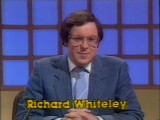 Countdown is a fairly ‘genteel’ quiz based on games that use numbers and letters, and is the only Channel 4 programme apart from Channel 4 News which is still being produced today. The very first presenter to appear on the new channel was none other than Richard Whiteley, who was a familiar face to ITV viewers in the Yorkshire region (Yorkshire TV – now owned by Granada – produces Countdown for Channel 4). Richard became a cult figure nationally as a result of presenting Countdown though he sadly died in June 2005 after an illness.
Countdown is a fairly ‘genteel’ quiz based on games that use numbers and letters, and is the only Channel 4 programme apart from Channel 4 News which is still being produced today. The very first presenter to appear on the new channel was none other than Richard Whiteley, who was a familiar face to ITV viewers in the Yorkshire region (Yorkshire TV – now owned by Granada – produces Countdown for Channel 4). Richard became a cult figure nationally as a result of presenting Countdown though he sadly died in June 2005 after an illness. One familiar face that appeared on the very first edition of Countdown was that of Ted Moult, who was known nationally to many people as a gardener and also from his appearances on other TV quiz shows. And one person making her TV debut was Carol Vorderman, who was initially just employed as the ‘resident statistician’ and was presented as a graduate from Cambridge University; she of course was later to take greater responsibility for both the letters and numbers games.
One familiar face that appeared on the very first edition of Countdown was that of Ted Moult, who was known nationally to many people as a gardener and also from his appearances on other TV quiz shows. And one person making her TV debut was Carol Vorderman, who was initially just employed as the ‘resident statistician’ and was presented as a graduate from Cambridge University; she of course was later to take greater responsibility for both the letters and numbers games.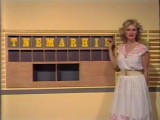 The very first Countdown ‘letters game’ produced this selection of consonants and vowels – T, N, E, M, A, R, H, I, B – of which the two contestants were able to think of two seven-letter words ‘raiment’ (an item of clothing) and ‘minaret’ (a thin tower that’s part of a mosque) respectively. Note the different colour scheme used for the letters board compared with that used today.
The very first Countdown ‘letters game’ produced this selection of consonants and vowels – T, N, E, M, A, R, H, I, B – of which the two contestants were able to think of two seven-letter words ‘raiment’ (an item of clothing) and ‘minaret’ (a thin tower that’s part of a mosque) respectively. Note the different colour scheme used for the letters board compared with that used today.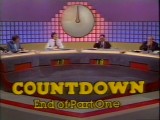 There were other notable differences between Countdown when it first launched and the same show as it appears today; the contestants do not have name labels and there were two guests in ‘dictionary corner’ as well as Carol Vorderman on hand to make sure that everything ran smoothly.
There were other notable differences between Countdown when it first launched and the same show as it appears today; the contestants do not have name labels and there were two guests in ‘dictionary corner’ as well as Carol Vorderman on hand to make sure that everything ran smoothly.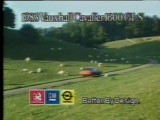 Another difference between Channel 4 and the other channels was that all programmes were shown across England, Scotland and Northern Ireland, but commercials could either be shown nationally or in specific regional areas (based on the ITV regions). The first commercial to be shown on the new channel was for the Vauxhall Cavalier 1600 GLS.
Another difference between Channel 4 and the other channels was that all programmes were shown across England, Scotland and Northern Ireland, but commercials could either be shown nationally or in specific regional areas (based on the ITV regions). The first commercial to be shown on the new channel was for the Vauxhall Cavalier 1600 GLS. Channel 4, like BBC2, got off to a shaky start but for different reasons. A disagreement concerning actor’s pay for commercials shown on the fledgling network resulted in an industrial dispute that prevented actors from appearing ‘on camera’ in commercials. This resulted in either a small number of commercials being shown or no commercials at all (depending on the region), at least until the dispute was resolved. Wales has a separate service called S4C with its own Welsh language programming (as well as showing programmes from Channel 4) which had launched the previous day.
Channel 4, like BBC2, got off to a shaky start but for different reasons. A disagreement concerning actor’s pay for commercials shown on the fledgling network resulted in an industrial dispute that prevented actors from appearing ‘on camera’ in commercials. This resulted in either a small number of commercials being shown or no commercials at all (depending on the region), at least until the dispute was resolved. Wales has a separate service called S4C with its own Welsh language programming (as well as showing programmes from Channel 4) which had launched the previous day. Channel 4 transmitted programmes in the evenings only to begin with, so Channel 4’s test card was a familiar sight for viewers tuning in during the morning and daytime. Unlike BBC2 a new television set was not mandatory, and the fact that the UK UHF transmitter network had from the outset been designed to offer four channels meant that no new aerial was required. Also unlike previous channel launches most of the transmitters were already set up so most of the population could receive the channel (apart from some remote areas).
Channel 4 transmitted programmes in the evenings only to begin with, so Channel 4’s test card was a familiar sight for viewers tuning in during the morning and daytime. Unlike BBC2 a new television set was not mandatory, and the fact that the UK UHF transmitter network had from the outset been designed to offer four channels meant that no new aerial was required. Also unlike previous channel launches most of the transmitters were already set up so most of the population could receive the channel (apart from some remote areas).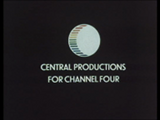 Various ITV franchises made programming contributions to the Channel 4 (and S4C) schedule alongside independent producers, including hard-hitting drama Walter produced by Central Television, Countdown produced by Yorkshire Television, 4 What Its Worth produced by Thames Television, amongst numerous others.
Various ITV franchises made programming contributions to the Channel 4 (and S4C) schedule alongside independent producers, including hard-hitting drama Walter produced by Central Television, Countdown produced by Yorkshire Television, 4 What Its Worth produced by Thames Television, amongst numerous others. The new channel tried out some brave programming ideas in its early years. The Friday Alternative was a hard-hitting politically controversial current affairs show with some key differences; no presenters were visible, there was a left-of-centre political bias and it made heavy use of computer animation between video footage. Indeed The Friday Alternative proved to be so controversial it triggered a row between Channel 4 News producer ITN and Channel 4, forcing the channel into commissioning Diverse Reports as a replacement instead.
The new channel tried out some brave programming ideas in its early years. The Friday Alternative was a hard-hitting politically controversial current affairs show with some key differences; no presenters were visible, there was a left-of-centre political bias and it made heavy use of computer animation between video footage. Indeed The Friday Alternative proved to be so controversial it triggered a row between Channel 4 News producer ITN and Channel 4, forcing the channel into commissioning Diverse Reports as a replacement instead.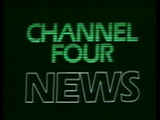 Channel 4 News, the 50 minute-long peak time news bulletin along with (perhaps amazingly) Countdown are the only two survivors of Channel 4’s original schedule that continue to be shown to this day. Early critics of the channel dubbed it “Channel Bore” or “Channel Snore”, though it’s naturally easy to knock something if it’s trying to be different.
Channel 4 News, the 50 minute-long peak time news bulletin along with (perhaps amazingly) Countdown are the only two survivors of Channel 4’s original schedule that continue to be shown to this day. Early critics of the channel dubbed it “Channel Bore” or “Channel Snore”, though it’s naturally easy to knock something if it’s trying to be different.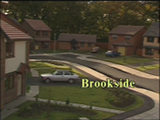 As well as all the arty experimental programming there were much more down to earth offerings like the soap opera Brookside produced by independent production company Mersey Television. Brookside used its own private housing estate as a set, which was unusual for a drama series at that time as opposed to the more normal practice of using a constructed set in a large television studio which gets dismantled and stored away when not in use, but for continuing drama like Brookside, Coronation Street or EastEnders, a permanent set makes a lot more sense. When Brookside came to an end in 2006, the Brookside Close properties were renovated and sold off as private properties, enabling anyone with enough money to actually live in a piece of televisual history.
As well as all the arty experimental programming there were much more down to earth offerings like the soap opera Brookside produced by independent production company Mersey Television. Brookside used its own private housing estate as a set, which was unusual for a drama series at that time as opposed to the more normal practice of using a constructed set in a large television studio which gets dismantled and stored away when not in use, but for continuing drama like Brookside, Coronation Street or EastEnders, a permanent set makes a lot more sense. When Brookside came to an end in 2006, the Brookside Close properties were renovated and sold off as private properties, enabling anyone with enough money to actually live in a piece of televisual history.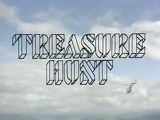 Another very popular programme shown during the first few years of the channel’s life was Treasure Hunt, a quiz show presented by Kenneth Kendall that featured two contestants in a TV studio with a library of reference books to help them find and solve clues that could be found within a particular geographical area and within a 45 minute timescale that ultimately led to a cash prize if they were successful.
Another very popular programme shown during the first few years of the channel’s life was Treasure Hunt, a quiz show presented by Kenneth Kendall that featured two contestants in a TV studio with a library of reference books to help them find and solve clues that could be found within a particular geographical area and within a 45 minute timescale that ultimately led to a cash prize if they were successful.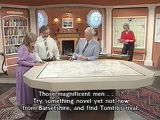 Each Treasure Hunt clue consisted of a card with a printed riddle that gave cryptic details of a location where the next clue could be found; the first clue was read out in the studio at the start of the game and the contestants then had 45 minutes to find the remaining clues that were usually positioned miles apart from each other in different locations, meaning that the contestants had to solve each clue using reference books in the studio and then give verbal instructions to a ‘skyrunner’ (Anneka Rice, later Annabel Croft) via an audio link without any form of visual assistance between the two in order to direct the skyrunner to the location where the next clue is hopefully located.
Each Treasure Hunt clue consisted of a card with a printed riddle that gave cryptic details of a location where the next clue could be found; the first clue was read out in the studio at the start of the game and the contestants then had 45 minutes to find the remaining clues that were usually positioned miles apart from each other in different locations, meaning that the contestants had to solve each clue using reference books in the studio and then give verbal instructions to a ‘skyrunner’ (Anneka Rice, later Annabel Croft) via an audio link without any form of visual assistance between the two in order to direct the skyrunner to the location where the next clue is hopefully located. Treasure Hunt’s skyrunner had the use of a helicopter to quickly travel to various locations, though inevitably she usually had to do some running and/or borrow other forms of transport in order to actually get to the clue in question from the helicopter landing site. A map on the studio wall showed the approximate location of the helicopter at any given point, and the remaining time in minutes:seconds was often displayed on the screen, with the clock stopping for a while as soon as each clue was found. All the clues had to be solved before the clock reached zero, though there was an additional clue located nearby for a bonus prize if there was still sufficient time remaining (something that almost never happened).
Treasure Hunt’s skyrunner had the use of a helicopter to quickly travel to various locations, though inevitably she usually had to do some running and/or borrow other forms of transport in order to actually get to the clue in question from the helicopter landing site. A map on the studio wall showed the approximate location of the helicopter at any given point, and the remaining time in minutes:seconds was often displayed on the screen, with the clock stopping for a while as soon as each clue was found. All the clues had to be solved before the clock reached zero, though there was an additional clue located nearby for a bonus prize if there was still sufficient time remaining (something that almost never happened). This style of promotion was used by Channel 4 during 1984, featuring an Orwellian “Big Brother”-style stone slab with added ‘4’ logo which appeared at the end. A wide variety of imaginative programming appeared on the channel during 1984, including Let’s Parlez Franglais (an adaptation of Miles Kington’s magazine feature), Night Beat News (a newsroom comedy also produced in a Welsh language version), and a television opera entitled Perfect Lives. Daytime programming also commenced in 1984 with Channel 4 Racing.
This style of promotion was used by Channel 4 during 1984, featuring an Orwellian “Big Brother”-style stone slab with added ‘4’ logo which appeared at the end. A wide variety of imaginative programming appeared on the channel during 1984, including Let’s Parlez Franglais (an adaptation of Miles Kington’s magazine feature), Night Beat News (a newsroom comedy also produced in a Welsh language version), and a television opera entitled Perfect Lives. Daytime programming also commenced in 1984 with Channel 4 Racing.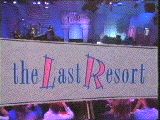 By the mid 1980s programmes such as The Word and The Last Resort gained notoriety and media coverage, making Mark Lamarr and the sharp-suited Jonathan Ross stars (among other people). What started life as Friday Live grew into Saturday Night Live was instrumental in changing the whole face of British comedy, launching a whole selection of ‘alternative’ comedians such as Ben Elton (who presented the show), Harry Enfield and Jo Brand. Channel 4 has also commissioned films such as My Beautiful Launderette, Four Weddings and a Funeral, and Slumdog Millionaire. The ‘youth’ show Network Seven was hugely influential in relation to programme production trends, even though the show itself had only a very small audience.
By the mid 1980s programmes such as The Word and The Last Resort gained notoriety and media coverage, making Mark Lamarr and the sharp-suited Jonathan Ross stars (among other people). What started life as Friday Live grew into Saturday Night Live was instrumental in changing the whole face of British comedy, launching a whole selection of ‘alternative’ comedians such as Ben Elton (who presented the show), Harry Enfield and Jo Brand. Channel 4 has also commissioned films such as My Beautiful Launderette, Four Weddings and a Funeral, and Slumdog Millionaire. The ‘youth’ show Network Seven was hugely influential in relation to programme production trends, even though the show itself had only a very small audience.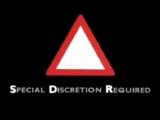 Channel 4 has never been afraid to be controversial. In 1987 the channel decided to experiment with using what was known as the ‘red triangle’; the idea being was that the triangle would be displayed in the top left hand corner of the screen throughout programmes that featured scenes containing violence or explicit sexual content, effectively serving as a content warning. Opponents to this idea said that this would be an excuse to show even more sex and violence, and viewing figures for programmes that featured the red triangle conversely went up. Within months the whole experiment was quietly dropped.
Channel 4 has never been afraid to be controversial. In 1987 the channel decided to experiment with using what was known as the ‘red triangle’; the idea being was that the triangle would be displayed in the top left hand corner of the screen throughout programmes that featured scenes containing violence or explicit sexual content, effectively serving as a content warning. Opponents to this idea said that this would be an excuse to show even more sex and violence, and viewing figures for programmes that featured the red triangle conversely went up. Within months the whole experiment was quietly dropped. The Open College was a short-lived attempt to replicate the higher education success of the Open University on Channel 4, and to this end there was an agreement between the Open College – a new educational entity independent of Channel 4 that was created by the government of the day – and Channel 4 to transmit educational programmes from 1988 onwards with Channel 4 providing assistance in terms of resources and time to the approximate value of £1m per year. Open College programmes included Make It Count presented by Fred Harris, but unlike its Open University counterpart, Open College proved to be a failure and the project was soon abandoned.
The Open College was a short-lived attempt to replicate the higher education success of the Open University on Channel 4, and to this end there was an agreement between the Open College – a new educational entity independent of Channel 4 that was created by the government of the day – and Channel 4 to transmit educational programmes from 1988 onwards with Channel 4 providing assistance in terms of resources and time to the approximate value of £1m per year. Open College programmes included Make It Count presented by Fred Harris, but unlike its Open University counterpart, Open College proved to be a failure and the project was soon abandoned. During the Christmas period in 1990 Channel 4 used this ‘psychedelic four’ with flashing colours as a special ident. As well as being controversial, Channel 4 produces the usual quizzes, soap operas, current affairs, etc., that can be found on other mainstream channels therefore catering for a very wide cross section of the population as a result.
During the Christmas period in 1990 Channel 4 used this ‘psychedelic four’ with flashing colours as a special ident. As well as being controversial, Channel 4 produces the usual quizzes, soap operas, current affairs, etc., that can be found on other mainstream channels therefore catering for a very wide cross section of the population as a result.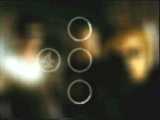 In the 1990s Channel 4 started a continuous 24-hour service, and then in 1997 controversially ditched its original ‘coloured 4’ in favour of using a white ‘4’ symbol in conjunction with either circles or squares, as shown here. This was also one of the first examples of the use of real people as part of idents as opposed to showing just a symbol or static drawing of some description; an idea which was to be later copied by many other broadcasters.
In the 1990s Channel 4 started a continuous 24-hour service, and then in 1997 controversially ditched its original ‘coloured 4’ in favour of using a white ‘4’ symbol in conjunction with either circles or squares, as shown here. This was also one of the first examples of the use of real people as part of idents as opposed to showing just a symbol or static drawing of some description; an idea which was to be later copied by many other broadcasters.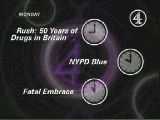 The change did not meet universal acclaim – indeed Channel 4’s image was soon to change again much sooner than expected (see below) due to a perceived unpopularity of its new circles-based identity. On January 1 1999 Channel 4 stopped promoting ITV programmes (and vice versa) as the ties between ITV and Channel 4 were finally cut – Channel 4 was now effectively an independent broadcaster.
The change did not meet universal acclaim – indeed Channel 4’s image was soon to change again much sooner than expected (see below) due to a perceived unpopularity of its new circles-based identity. On January 1 1999 Channel 4 stopped promoting ITV programmes (and vice versa) as the ties between ITV and Channel 4 were finally cut – Channel 4 was now effectively an independent broadcaster.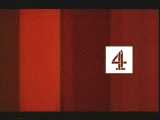 Out with the old, in with the new – Channel 4 introduced its second image ‘makeover’ on 2 April 1999. The unloved circles were ditched in favour of a simple square-shaped logo in combination with scrolling bands of colour; at the same time Channel 4 controversially also tried using a DOG (digitally originated graphic) on its digital feed, meaning that ONdigital and SkyDigital viewers of the channel are treated to a permanent on-screen symbol similar to that used by Channel 5 at the time. This however was later removed because of complaints from viewers, though Channel 4 HD has an on-screen logo presumably to help promote/distinguish the high definition service from its standard definition channel.
Out with the old, in with the new – Channel 4 introduced its second image ‘makeover’ on 2 April 1999. The unloved circles were ditched in favour of a simple square-shaped logo in combination with scrolling bands of colour; at the same time Channel 4 controversially also tried using a DOG (digitally originated graphic) on its digital feed, meaning that ONdigital and SkyDigital viewers of the channel are treated to a permanent on-screen symbol similar to that used by Channel 5 at the time. This however was later removed because of complaints from viewers, though Channel 4 HD has an on-screen logo presumably to help promote/distinguish the high definition service from its standard definition channel.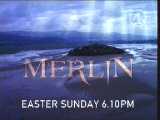 Compare and contrast: this picture was taken from the end of a programme trailer that was shown just before the April 1999 changes were introduced to the channel. The old-style ‘4 in a circle’ is just visible in the top right hand corner of the picture.
Compare and contrast: this picture was taken from the end of a programme trailer that was shown just before the April 1999 changes were introduced to the channel. The old-style ‘4 in a circle’ is just visible in the top right hand corner of the picture. And this picture was taken from the end of the revised style of trailer for exactly the same programme. Note that the screen is now essentially divided into two areas, with the larger left area being free for the display of programme information whilst maintaining the logo on the right side of the screen.
And this picture was taken from the end of the revised style of trailer for exactly the same programme. Note that the screen is now essentially divided into two areas, with the larger left area being free for the display of programme information whilst maintaining the logo on the right side of the screen. Since the ‘square’ look was introduced, subtle changes were subsequently made; at one point the ‘4’ square occasionally flipped across the screen into position, though in other respects the presentation had changed relatively little apart from the introduction of ‘split screens’ at the end of programmes along with ‘now and next’ menus. (Sometimes background images were used behind the moving lines for idents as in this example.) In July 2000, Channel 4 introduced a brand new reality TV show based in a house containing people who are continually watched by cameras and aren’t allowed to leave until they are evicted, namely Big Brother.
Since the ‘square’ look was introduced, subtle changes were subsequently made; at one point the ‘4’ square occasionally flipped across the screen into position, though in other respects the presentation had changed relatively little apart from the introduction of ‘split screens’ at the end of programmes along with ‘now and next’ menus. (Sometimes background images were used behind the moving lines for idents as in this example.) In July 2000, Channel 4 introduced a brand new reality TV show based in a house containing people who are continually watched by cameras and aren’t allowed to leave until they are evicted, namely Big Brother.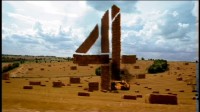 The last day of 2004 saw the launch of Channel 4’s new ident package, which essentially saw the return of the Channel 4 logo building up in three dimensions, except this time the logo is formed using building blocks comprising of abstract pieces of landscape such as hedges, concrete blocks, road signs or bales of hay for a surreal effect as the sequence progresses.
The last day of 2004 saw the launch of Channel 4’s new ident package, which essentially saw the return of the Channel 4 logo building up in three dimensions, except this time the logo is formed using building blocks comprising of abstract pieces of landscape such as hedges, concrete blocks, road signs or bales of hay for a surreal effect as the sequence progresses. Other changes were introduced at the same time including a new look for Channel 4 News (essentially swapping its black and purple colour scheme for new titles and studio appearance in white and blue colours) as well as two new styles of programme promotion, though some minor tweaks were made to Channel 4’s presentation soon after launch. Also note that Channel 4 News was one of the last regularly-broadcast programmes shown on one the main five channels to switch over to widescreen broadcasting as opposed to using the older 4:3 standard, presumably due to cost reasons and/or various other news sources still providing video in the 4:3 aspect ratio at the time.
Other changes were introduced at the same time including a new look for Channel 4 News (essentially swapping its black and purple colour scheme for new titles and studio appearance in white and blue colours) as well as two new styles of programme promotion, though some minor tweaks were made to Channel 4’s presentation soon after launch. Also note that Channel 4 News was one of the last regularly-broadcast programmes shown on one the main five channels to switch over to widescreen broadcasting as opposed to using the older 4:3 standard, presumably due to cost reasons and/or various other news sources still providing video in the 4:3 aspect ratio at the time.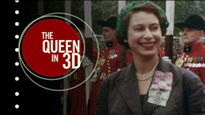 For a week in 2010, Channel 4 jumped on an emerging but short-lived bandwagon for 3D television with a special week of programmes featuring old 3D film footage taken of The Queen and various other people, places and objects. The experiment was essentially similar to the 3D experiments previously conducted by ITV franchise TVS in 1982 which required viewers to wear cardboard glasses with specially-tinted cellophane lenses that were given away with each copy of the TV Times, except that the colour tints used in the Channel 4 experiment were different therefore you couldn’t reuse the same glasses, so you most likely had to obtain new glasses that were made available from branches of Sainsbury’s supermarkets (and a few other places) in order to watch those broadcasts.
For a week in 2010, Channel 4 jumped on an emerging but short-lived bandwagon for 3D television with a special week of programmes featuring old 3D film footage taken of The Queen and various other people, places and objects. The experiment was essentially similar to the 3D experiments previously conducted by ITV franchise TVS in 1982 which required viewers to wear cardboard glasses with specially-tinted cellophane lenses that were given away with each copy of the TV Times, except that the colour tints used in the Channel 4 experiment were different therefore you couldn’t reuse the same glasses, so you most likely had to obtain new glasses that were made available from branches of Sainsbury’s supermarkets (and a few other places) in order to watch those broadcasts. Ever since Channel 4 decided to get rid of Big Brother from its schedule in 2009 (last broadcast in 2010 on Channel 4), there has been a dilemma of exactly what programming to replace it with, especially as Big Brother and Celebrity Big Brother occupied so much of the schedule. A new weekly series looking back at the week’s events from a comic perspective – 10 O’Clock Live – was introduced in 2012, with other comedy offerings such as Stand Up for the Week and panel game 8 out of 10 Cats forming part of the schedule. The controversial Big Fat Gypsy Weddings reality series and its spinoffs generated lots of publicity but not all of it was positive, therefore those have somewhat inevitably been cancelled as well; other reality shows include One Born Every Minute, The Secret Millionaire, and the controversially-titled The Undateables, as well as educational series like Embarrassing Bodies and How Britain Worked. However Channel 4 has thankfully commissioned a selection of high quality drama series that have partially helped to restore it former reputation for quality programming, namely series like Black Mirror which somewhat distorts reality to make a satirical point, Complicit and the US import Homeland.
Ever since Channel 4 decided to get rid of Big Brother from its schedule in 2009 (last broadcast in 2010 on Channel 4), there has been a dilemma of exactly what programming to replace it with, especially as Big Brother and Celebrity Big Brother occupied so much of the schedule. A new weekly series looking back at the week’s events from a comic perspective – 10 O’Clock Live – was introduced in 2012, with other comedy offerings such as Stand Up for the Week and panel game 8 out of 10 Cats forming part of the schedule. The controversial Big Fat Gypsy Weddings reality series and its spinoffs generated lots of publicity but not all of it was positive, therefore those have somewhat inevitably been cancelled as well; other reality shows include One Born Every Minute, The Secret Millionaire, and the controversially-titled The Undateables, as well as educational series like Embarrassing Bodies and How Britain Worked. However Channel 4 has thankfully commissioned a selection of high quality drama series that have partially helped to restore it former reputation for quality programming, namely series like Black Mirror which somewhat distorts reality to make a satirical point, Complicit and the US import Homeland.
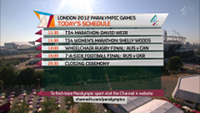
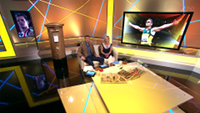
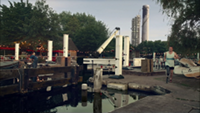 Following on from the hugely successful London 2012 Olympic Games would be a daunting task for anyone, but a combination of goodwill and the promotional skills of Channel 4 turned the following Paralympic Games into a huge success likewise, no doubt helping to make stadium events a sell-out (for the first time in Paralympic history) and generally raising the profile of various sports and competitors. A late evening programme shown during the Games entitled The Last Leg, presented by comedian Adam Hills alongside television newcomers Alex Brooker and Josh Widdecombe who discussed the Games and interviewed Paralympic athletes, became so successful on its own merits it was recommissioned after the Games as a comedy review of the week with celebrity guests. March 2013 saw the introduction of Gogglebox; a series showing families watching and talking about various television programmes in their own homes, which proved to be popular therefore inevitably spawned variants such as Gogglesprogs (featuring children) in 2015 and a one-off ‘Brexit Special’ in 2016.
Following on from the hugely successful London 2012 Olympic Games would be a daunting task for anyone, but a combination of goodwill and the promotional skills of Channel 4 turned the following Paralympic Games into a huge success likewise, no doubt helping to make stadium events a sell-out (for the first time in Paralympic history) and generally raising the profile of various sports and competitors. A late evening programme shown during the Games entitled The Last Leg, presented by comedian Adam Hills alongside television newcomers Alex Brooker and Josh Widdecombe who discussed the Games and interviewed Paralympic athletes, became so successful on its own merits it was recommissioned after the Games as a comedy review of the week with celebrity guests. March 2013 saw the introduction of Gogglebox; a series showing families watching and talking about various television programmes in their own homes, which proved to be popular therefore inevitably spawned variants such as Gogglesprogs (featuring children) in 2015 and a one-off ‘Brexit Special’ in 2016. In September 2015 Channel 4 introduced a new and highly abstract on-screen identity featuring the blocks that make up its logo appearing in different forms, using short computer-generated animated sequences; four of these created ident sequences (one shown before each programme) formed an entirely fictional ‘story’. Pictured here is an abstract ‘clock’ animation which immediately preceded the Channel 4 News at 7pm; the hidden clock hands ‘twitched’ but didn’t actually rotate though the blocks themselves did move clockwise once each second. Channel 4’s logo only occasionally appeared in its complete form at certain points between programmes.
In September 2015 Channel 4 introduced a new and highly abstract on-screen identity featuring the blocks that make up its logo appearing in different forms, using short computer-generated animated sequences; four of these created ident sequences (one shown before each programme) formed an entirely fictional ‘story’. Pictured here is an abstract ‘clock’ animation which immediately preceded the Channel 4 News at 7pm; the hidden clock hands ‘twitched’ but didn’t actually rotate though the blocks themselves did move clockwise once each second. Channel 4’s logo only occasionally appeared in its complete form at certain points between programmes.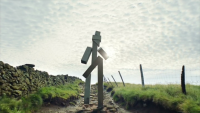 By 2017 Channel 4 introduced fresh computer-generated idents that are more ‘conventional’ in nature, replacing the previous four animated story sequences but keeping most of the rest of the channel’s presentation package as introduced in 2015. They all feature a cartoon figure made out of blocks that does various things, this time accompanied by an acoustic guitar version of the Fourscore theme as originally used back in 1982. 2017 also saw the introduction of The Great British Bake-Off to Channel 4; a baking competition series made by Love Productions but originally commissioned and shown by the BBC. However Channel 4 won the rights to The Great British Bake-Off after a furious bidding war triggered when Love Productions decided that it may be better off moving the popular format to a rival broadcaster.
By 2017 Channel 4 introduced fresh computer-generated idents that are more ‘conventional’ in nature, replacing the previous four animated story sequences but keeping most of the rest of the channel’s presentation package as introduced in 2015. They all feature a cartoon figure made out of blocks that does various things, this time accompanied by an acoustic guitar version of the Fourscore theme as originally used back in 1982. 2017 also saw the introduction of The Great British Bake-Off to Channel 4; a baking competition series made by Love Productions but originally commissioned and shown by the BBC. However Channel 4 won the rights to The Great British Bake-Off after a furious bidding war triggered when Love Productions decided that it may be better off moving the popular format to a rival broadcaster.
 Having different TV broadcasting franchises for the second channel naturally resulted in different programmes being produced in different regions, though it soon became apparent that there was a requirement to share certain programming with other franchises due to cost considerations. Also many more programmes were broadcast live due to the high cost of film recording – video recording only became commercially available in 1957 and was also extremely expensive – therefore many programmes were broadcast simultaneously on different franchises at the same time, though certain franchises occasionally declined to show programming for various reason(s).
Having different TV broadcasting franchises for the second channel naturally resulted in different programmes being produced in different regions, though it soon became apparent that there was a requirement to share certain programming with other franchises due to cost considerations. Also many more programmes were broadcast live due to the high cost of film recording – video recording only became commercially available in 1957 and was also extremely expensive – therefore many programmes were broadcast simultaneously on different franchises at the same time, though certain franchises occasionally declined to show programming for various reason(s).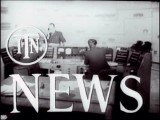 ITN (Independent Television News) provided news programmes for the ITV network and the organisation still does so today. The first bulletin was transmitted at 10pm on 22 September 1955 on ITV’s opening night, and introduced a less formal style of news broadcasting to the UK imported from America, which was in direct contrast to the cinema newsreels and still pictures that the BBC used. The appropriately-named Christopher Chataway presented the first programme, and him, along with Robin Day and Ludovic Kennedy, became household names.
ITN (Independent Television News) provided news programmes for the ITV network and the organisation still does so today. The first bulletin was transmitted at 10pm on 22 September 1955 on ITV’s opening night, and introduced a less formal style of news broadcasting to the UK imported from America, which was in direct contrast to the cinema newsreels and still pictures that the BBC used. The appropriately-named Christopher Chataway presented the first programme, and him, along with Robin Day and Ludovic Kennedy, became household names.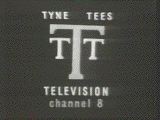 To begin with, independent television started life in London with Associated-Rediffusion providing the London weekday service plus ATV providing the London weekend service, but over the next few years the ITV network expanded with the addition of more regional franchises covering various parts of the United Kingdom. This caption from Tyne Tees (North-East England) gives the VHF channel number. Many TV sets produced before 1955 were often only capable of receiving one channel and these sets needed a “set-top convertor” to enable additional frequencies to be viewed.
To begin with, independent television started life in London with Associated-Rediffusion providing the London weekday service plus ATV providing the London weekend service, but over the next few years the ITV network expanded with the addition of more regional franchises covering various parts of the United Kingdom. This caption from Tyne Tees (North-East England) gives the VHF channel number. Many TV sets produced before 1955 were often only capable of receiving one channel and these sets needed a “set-top convertor” to enable additional frequencies to be viewed.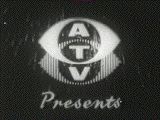 The news was not the only thing different about the new service. ITV, in contrast to the licence fee funded BBC, was more ‘downmarket’ in its approach, showing quiz games and popular light entertainment shows in order to attract viewers to the channel; many of these formats such as Associated-Rediffusion’s Double Your Money were imported from America. The caption shown here is the start of the title sequence for Sunday Night at the London Palladium, presented by Jack Parnell, and produced for the ITV network by Associated Television (ATV), which was the company that held the London ITV weekend franchise until 1968. ATV also held the Midlands ITV franchise (weekdays only until 1968) up to 1982 when ATV essentially reinvented itself as Central.
The news was not the only thing different about the new service. ITV, in contrast to the licence fee funded BBC, was more ‘downmarket’ in its approach, showing quiz games and popular light entertainment shows in order to attract viewers to the channel; many of these formats such as Associated-Rediffusion’s Double Your Money were imported from America. The caption shown here is the start of the title sequence for Sunday Night at the London Palladium, presented by Jack Parnell, and produced for the ITV network by Associated Television (ATV), which was the company that held the London ITV weekend franchise until 1968. ATV also held the Midlands ITV franchise (weekdays only until 1968) up to 1982 when ATV essentially reinvented itself as Central.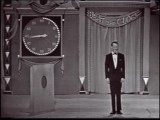 Sunday Night at the London Palladium was basically a traditional variety show format adapted for television, but it also featured what was the novel addition of a quiz show segment (Beat The Clock, shown here with Bruce Forsyth as the presenter). This entertainment mixture proved to be very popular for many years with audience figures often exceeding 20 million in its heyday, firmly establishing ITV as the home of popular entertainmentand the format has been revived on more than one occasion.
Sunday Night at the London Palladium was basically a traditional variety show format adapted for television, but it also featured what was the novel addition of a quiz show segment (Beat The Clock, shown here with Bruce Forsyth as the presenter). This entertainment mixture proved to be very popular for many years with audience figures often exceeding 20 million in its heyday, firmly establishing ITV as the home of popular entertainmentand the format has been revived on more than one occasion.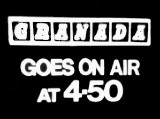 Granada Television was the third ITV franchise to launch in 1956, initially serving the North-West of England, Yorkshire and (unofficially) parts of North Wales, and over the years Granada outlived all the other franchises to form the modern ITV plc that it is today. The company started life as a chain of cinemas, entering the world of television rather reluctantly to begin with until its management was convinced of commercial television’s long term worth. Granada is famous for several programmes, especially Coronation Street (a long-running soap opera) and World in Action. (Photos above and below courtesy of Transdiffusion.)
Granada Television was the third ITV franchise to launch in 1956, initially serving the North-West of England, Yorkshire and (unofficially) parts of North Wales, and over the years Granada outlived all the other franchises to form the modern ITV plc that it is today. The company started life as a chain of cinemas, entering the world of television rather reluctantly to begin with until its management was convinced of commercial television’s long term worth. Granada is famous for several programmes, especially Coronation Street (a long-running soap opera) and World in Action. (Photos above and below courtesy of Transdiffusion.)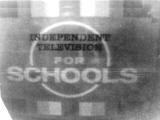 ITV started showing schools programmes as early as 13 May 1957, when Associated-Rediffusion (managed by the forward-thinking Paul Adorian) established the first regular schools broadcasting in the UK; the BBC following suit by September, initially showing one programme each afternoon. Many teachers were initially suspicious of using television as a teaching tool in the classroom, especially as they had to fit lessons around the showing of various programmes (not an easy task) with no means of recording them until the mid-1960s. Schools broadcasts also helped to lessen the perception that ITV consisted purely of mass market entertainment.
ITV started showing schools programmes as early as 13 May 1957, when Associated-Rediffusion (managed by the forward-thinking Paul Adorian) established the first regular schools broadcasting in the UK; the BBC following suit by September, initially showing one programme each afternoon. Many teachers were initially suspicious of using television as a teaching tool in the classroom, especially as they had to fit lessons around the showing of various programmes (not an easy task) with no means of recording them until the mid-1960s. Schools broadcasts also helped to lessen the perception that ITV consisted purely of mass market entertainment.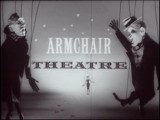 The ITV franchises may have produced ‘populist’ drama such as soap operas along with even more lightweight quiz and variety programming shown during the early evening, but ITV proved that there was a sizeable audience for more serious drama offerings such as the ABC-produced Armchair Theatre that featured one-off plays; indeed Armchair Theatre outlasted ABC and continued when Thames was formed for the London weekday ITV franchise in 1968.
The ITV franchises may have produced ‘populist’ drama such as soap operas along with even more lightweight quiz and variety programming shown during the early evening, but ITV proved that there was a sizeable audience for more serious drama offerings such as the ABC-produced Armchair Theatre that featured one-off plays; indeed Armchair Theatre outlasted ABC and continued when Thames was formed for the London weekday ITV franchise in 1968. The 1960s saw a further expansion of the ITV network, which finally enabled ITV programmes to be viewed in most parts of the country. Westward Television was arguably the first of the “second wave” of ITV franchises to start broadcasting in 1961, following on from the initial batch of franchises which had included Southern and Tyne Tees as well as the pioneers Associated-Rediffusion and Granada. At this point it seemed fairly obvious that ITV franchises were now capable of making money, though the first and only ITV company to go bankrupt whilst still holding a franchise (WWN) was soon to follow.
The 1960s saw a further expansion of the ITV network, which finally enabled ITV programmes to be viewed in most parts of the country. Westward Television was arguably the first of the “second wave” of ITV franchises to start broadcasting in 1961, following on from the initial batch of franchises which had included Southern and Tyne Tees as well as the pioneers Associated-Rediffusion and Granada. At this point it seemed fairly obvious that ITV franchises were now capable of making money, though the first and only ITV company to go bankrupt whilst still holding a franchise (WWN) was soon to follow.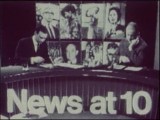 1967 saw the introduction of News at Ten, the half-hour news bulletin that became the cornerstone of the ITV schedule for over thirty years before being dropped in 1999 for a few years. ITN has always produced the news bulletins for the ITV network despite competition from other news providers in more recent times such as Sky News, and has also produced news bulletins for Channel 4 (and Channel 5 during its early years as well as nowadays).
1967 saw the introduction of News at Ten, the half-hour news bulletin that became the cornerstone of the ITV schedule for over thirty years before being dropped in 1999 for a few years. ITN has always produced the news bulletins for the ITV network despite competition from other news providers in more recent times such as Sky News, and has also produced news bulletins for Channel 4 (and Channel 5 during its early years as well as nowadays).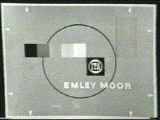 ITV’s Picasso Period…Up to the advent of colour in 1969 there was something called the ‘Picasso’ tuning signal, which was unofficially named after the famous artist by virtue of its style. (What Picasso himself would have made of it is unknown, but he surely would have given nodding approval.) The example pictured was broadcast exclusively from the Emley Moor transmitter in Yorkshire, with various other transmitters transmitting their own individual identifying captions that helped engineers and viewers to tune and adjust their receiving equipment. Old sets needed much more attention in this respect compared to their modern counterparts which are plug-and-play devices based around computers.
ITV’s Picasso Period…Up to the advent of colour in 1969 there was something called the ‘Picasso’ tuning signal, which was unofficially named after the famous artist by virtue of its style. (What Picasso himself would have made of it is unknown, but he surely would have given nodding approval.) The example pictured was broadcast exclusively from the Emley Moor transmitter in Yorkshire, with various other transmitters transmitting their own individual identifying captions that helped engineers and viewers to tune and adjust their receiving equipment. Old sets needed much more attention in this respect compared to their modern counterparts which are plug-and-play devices based around computers.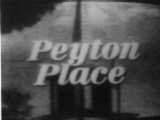 ITV’s first major shakeup caught almost everyone by surprise. The popular and respected ABC, whom prior to 1968 owned the (now extinct) Midlands and North of England weekend franchises had just expected to have been given one of the remaining major ITV franchises – London weekdays in particular being the coveted favourite – but being specifically asked to create a new ITV franchise company was a twist that nobody foresaw. Peyton Place was the very last programme to be transmitted by Rediffusion London in 1968 before the newly-created Thames Television took over as the London weekday franchise holder. ATV took over the Midlands franchise full-time with the weekend split being abolished.
ITV’s first major shakeup caught almost everyone by surprise. The popular and respected ABC, whom prior to 1968 owned the (now extinct) Midlands and North of England weekend franchises had just expected to have been given one of the remaining major ITV franchises – London weekdays in particular being the coveted favourite – but being specifically asked to create a new ITV franchise company was a twist that nobody foresaw. Peyton Place was the very last programme to be transmitted by Rediffusion London in 1968 before the newly-created Thames Television took over as the London weekday franchise holder. ATV took over the Midlands franchise full-time with the weekend split being abolished. Thames Television was created from the television production divisions of ABC (51%) and Rediffusion (49%) with ABC’s parent company ABPC being in overall control. With the new company structure, ABPC took the opportunity to change the ITV franchise name from ABC to Thames; a reason for doing this was that it would avoid confusion with the totally unrelated US and Australian ABC networks, especially when relating to international programme sales. After the creation of Thames, both the ABC and Rediffusion brands continued to be used for other purposes (cinemas and cable television to name but two) by their respective parent companies since only their ITV franchise operations had been affected.
Thames Television was created from the television production divisions of ABC (51%) and Rediffusion (49%) with ABC’s parent company ABPC being in overall control. With the new company structure, ABPC took the opportunity to change the ITV franchise name from ABC to Thames; a reason for doing this was that it would avoid confusion with the totally unrelated US and Australian ABC networks, especially when relating to international programme sales. After the creation of Thames, both the ABC and Rediffusion brands continued to be used for other purposes (cinemas and cable television to name but two) by their respective parent companies since only their ITV franchise operations had been affected. As well as the changes listed above, TWW (Television Wales and West) were ‘dispossessed’ and replaced by Harlech Television, a company named after Lord Harlech but which was soon to be renamed HTV since the Harlech name (rightly or wrongly to many viewers) reflected a Welsh bias to viewers in the West of England. The HTV franchise has since passed through the hands of UNM (United News and Media) and Carlton before Carlton was ‘merged’ with Granada to create what is now known as ITV Cymru Wales. Pre-programme company idents (as such) were no longer used from the beginning of 1988.
As well as the changes listed above, TWW (Television Wales and West) were ‘dispossessed’ and replaced by Harlech Television, a company named after Lord Harlech but which was soon to be renamed HTV since the Harlech name (rightly or wrongly to many viewers) reflected a Welsh bias to viewers in the West of England. The HTV franchise has since passed through the hands of UNM (United News and Media) and Carlton before Carlton was ‘merged’ with Granada to create what is now known as ITV Cymru Wales. Pre-programme company idents (as such) were no longer used from the beginning of 1988. World Of Sport was ITV’s famous Saturday afternoon sports programme presented by Dickie Davies which ran until 1985, and typically featured football (On The Ball), Australian rules football, stock car racing and the very popular wrestling matches that made household names of wrestlers such as Big Daddy, Giant Haystacks and Kendo Nagasaki, etc., as well as horse racing and other sports. Recently ITV revived the World of Sport brand for wrestling events and other purposes.
World Of Sport was ITV’s famous Saturday afternoon sports programme presented by Dickie Davies which ran until 1985, and typically featured football (On The Ball), Australian rules football, stock car racing and the very popular wrestling matches that made household names of wrestlers such as Big Daddy, Giant Haystacks and Kendo Nagasaki, etc., as well as horse racing and other sports. Recently ITV revived the World of Sport brand for wrestling events and other purposes.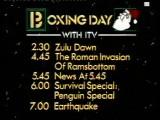 Various regional ITV companies became nationally well known for their contributions to the ITV network; for example Anglia became famous for its wildlife series Survival as well as its downmarket quiz Sale of the Century (“From Norwich, it’s the quiz of the week…”), Southern Television produced Out of Town presented by Jack Hargreaves, and the derestriction of ITV’s broadcasting hours in 1972 enabled Yorkshire Television to produce Emmerdale Farm which continues to this day as an evening soap just known as Emmerdale.
Various regional ITV companies became nationally well known for their contributions to the ITV network; for example Anglia became famous for its wildlife series Survival as well as its downmarket quiz Sale of the Century (“From Norwich, it’s the quiz of the week…”), Southern Television produced Out of Town presented by Jack Hargreaves, and the derestriction of ITV’s broadcasting hours in 1972 enabled Yorkshire Television to produce Emmerdale Farm which continues to this day as an evening soap just known as Emmerdale.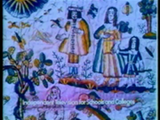
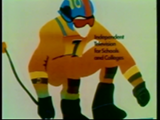

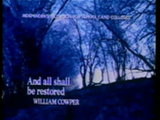
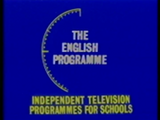 For many years, Independent Television for Schools and Colleges programming shown on ITV followed the same pattern, namely a picture was shown on screen accompanied by music, with the picture being replaced by a countdown clock with vanishing divisions showing for the final minute before the start of the programme.
For many years, Independent Television for Schools and Colleges programming shown on ITV followed the same pattern, namely a picture was shown on screen accompanied by music, with the picture being replaced by a countdown clock with vanishing divisions showing for the final minute before the start of the programme.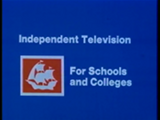 Schools programmes also enabled smaller ITV franchises like Border, Grampian and even Channel to fulfil their franchise requirements in terms of supplying networked ITV programmes. Various ITV schools programmes included A Place to Live, the ‘A’ Level chemistry programme Experiment, and arguably the most famous ITV schools programme of them all, How We Used To Live.
Schools programmes also enabled smaller ITV franchises like Border, Grampian and even Channel to fulfil their franchise requirements in terms of supplying networked ITV programmes. Various ITV schools programmes included A Place to Live, the ‘A’ Level chemistry programme Experiment, and arguably the most famous ITV schools programme of them all, How We Used To Live.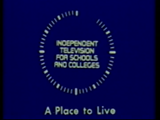 Here’s a later example of the Independent Television For Schools clock as used in the 1980s with a different clock face and font style. No commercials were shown before or during the programmes intended for schools and colleges, and this practice continued until ITV schools programming was moved to Channel 4 at the start of 1988.
Here’s a later example of the Independent Television For Schools clock as used in the 1980s with a different clock face and font style. No commercials were shown before or during the programmes intended for schools and colleges, and this practice continued until ITV schools programming was moved to Channel 4 at the start of 1988.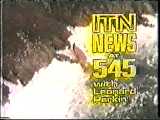 The 1980s started with a degree of uncertainty for the ITV contractors, as the second franchise review took place. Three familiar ITV names – ATV, Southern and Westward – were displaced by newcomers Central Independent Television, TVS (Television South) and TSW (Television South West) on January 1 1982, with one surprise being the loss of ATV because they were still a very successful ITV franchise holder, though Central were in essence just a ‘reorganised ATV’ with greater local commitments forced upon it by the Independent Broadcasting Authority (IBA). With improved local provisioning in mind, another change were made to the South East with the Bluebell Hill transmitter in Kent broadcasting TVS (which had pledged to improve the South-East of England’s local news service from new regional studios at Maidstone) instead of Thames/LWT.
The 1980s started with a degree of uncertainty for the ITV contractors, as the second franchise review took place. Three familiar ITV names – ATV, Southern and Westward – were displaced by newcomers Central Independent Television, TVS (Television South) and TSW (Television South West) on January 1 1982, with one surprise being the loss of ATV because they were still a very successful ITV franchise holder, though Central were in essence just a ‘reorganised ATV’ with greater local commitments forced upon it by the Independent Broadcasting Authority (IBA). With improved local provisioning in mind, another change were made to the South East with the Bluebell Hill transmitter in Kent broadcasting TVS (which had pledged to improve the South-East of England’s local news service from new regional studios at Maidstone) instead of Thames/LWT. Also ITV gained a new national breakfast television service provided by a completely separate contractor – TV-am, which began broadcasting a little more than a year after the other changes (1 February 1983), going on-air shortly after the BBC had launched its own ‘spoiler’ Breakfast Time programme on BBC1.
Also ITV gained a new national breakfast television service provided by a completely separate contractor – TV-am, which began broadcasting a little more than a year after the other changes (1 February 1983), going on-air shortly after the BBC had launched its own ‘spoiler’ Breakfast Time programme on BBC1.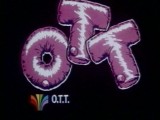 New franchises, new ideas…With three new ITV franchises wanting to attract and keep their viewers, there was an outburst of creativity on the ITV network over the next two or so years, though the end results were perhaps understandably mixed, with Central having the most luck network-wise and TSW getting the wooden spoon prize for (not) getting their shows on-air nationally. Central replaced Pipkins with Let’s Pretend and launched O.T.T.; an adult version of Tiswas which had little difficulty in attracting viewers but controversy forced it off-air after only one series.
New franchises, new ideas…With three new ITV franchises wanting to attract and keep their viewers, there was an outburst of creativity on the ITV network over the next two or so years, though the end results were perhaps understandably mixed, with Central having the most luck network-wise and TSW getting the wooden spoon prize for (not) getting their shows on-air nationally. Central replaced Pipkins with Let’s Pretend and launched O.T.T.; an adult version of Tiswas which had little difficulty in attracting viewers but controversy forced it off-air after only one series. Rather more successful shows produced by Central during its first few years included Auf Wiedersehen, Pet, which proved to be very popular and so were quizzes such as Bullseye and The Price Is Right; ATV’s Crossroads soap continued but was axed in 1988, and so did the drama Boon. In 1984 the popular satirical puppet comedy Spitting Image made its debut, though its first series featured a studio audience (an idea that was subsequently dropped).
Rather more successful shows produced by Central during its first few years included Auf Wiedersehen, Pet, which proved to be very popular and so were quizzes such as Bullseye and The Price Is Right; ATV’s Crossroads soap continued but was axed in 1988, and so did the drama Boon. In 1984 the popular satirical puppet comedy Spitting Image made its debut, though its first series featured a studio audience (an idea that was subsequently dropped). Being a significant newcomer to the ITV network, TVS came up with some new ideas of its own including detective drama C.A.T.S. Eyes, science series The Real World which featured ex-Tomorrow’s World presenter Michael Rodd and featured a 3D TV experiment with free coloured lens glasses supplied with copies of the TV Times; TVS also produced kids’ TV offerings On Safari and the Saturday morning show No 73. The only programmes that TSW managed to make an impact with on ITV were basically the quiz show Sounds Like Music, daytime canine competition That’s My Dog which also had the distinction of being the first ITV programme to have a commercial sponsor (Pedigree Chum dog food), plus the children’s cartoon series Tube Mice.
Being a significant newcomer to the ITV network, TVS came up with some new ideas of its own including detective drama C.A.T.S. Eyes, science series The Real World which featured ex-Tomorrow’s World presenter Michael Rodd and featured a 3D TV experiment with free coloured lens glasses supplied with copies of the TV Times; TVS also produced kids’ TV offerings On Safari and the Saturday morning show No 73. The only programmes that TSW managed to make an impact with on ITV were basically the quiz show Sounds Like Music, daytime canine competition That’s My Dog which also had the distinction of being the first ITV programme to have a commercial sponsor (Pedigree Chum dog food), plus the children’s cartoon series Tube Mice. Existing ITV franchises also launched new programming such as Yorkshire Television’s science show Where There’s Life, Thames Television’s Button Moon for young children, and Granada produced The Adventures of Sherlock Holmes and the hugely successful drama series The Jewel in the Crown in 1984, so ITV was still proving that it could be a force to be reckoned with despite all its recent upheavals. And 1985 saw the launch of long-running dating game show Blind Date, produced by LWT and presented for many years by Cilla Black.
Existing ITV franchises also launched new programming such as Yorkshire Television’s science show Where There’s Life, Thames Television’s Button Moon for young children, and Granada produced The Adventures of Sherlock Holmes and the hugely successful drama series The Jewel in the Crown in 1984, so ITV was still proving that it could be a force to be reckoned with despite all its recent upheavals. And 1985 saw the launch of long-running dating game show Blind Date, produced by LWT and presented for many years by Cilla Black. ITV continued to prosper during the second half of the 1980s as the new franchises bedded in, and the established ITV players continued apace; Granada adapted the novel First Among Equals into a 10-part drama series shown in 1986, and Thames’ long-running Strike It Lucky (later renamed Strike It Rich) quiz hosted by Michael Barrymore started in October of the same year. In 1988 Thames produced a highly controversial edition of current affairs programme This Week entitled Death on the Rock which some claim was a significant factor in Thames subsequently losing its ITV franchise even though this was officially denied; the same year also saw the launch of long-running drama series London’s Burning. Despite these successes there were clouds on the horizon for the ITV franchises in general; new technology such as the introduction of satellite television and the rapid growth of cable television networks meant theoretical new direct competition for ITV’s prized ad revenue – could ITV’s long-held “licence to print money” be finally coming to an end?
ITV continued to prosper during the second half of the 1980s as the new franchises bedded in, and the established ITV players continued apace; Granada adapted the novel First Among Equals into a 10-part drama series shown in 1986, and Thames’ long-running Strike It Lucky (later renamed Strike It Rich) quiz hosted by Michael Barrymore started in October of the same year. In 1988 Thames produced a highly controversial edition of current affairs programme This Week entitled Death on the Rock which some claim was a significant factor in Thames subsequently losing its ITV franchise even though this was officially denied; the same year also saw the launch of long-running drama series London’s Burning. Despite these successes there were clouds on the horizon for the ITV franchises in general; new technology such as the introduction of satellite television and the rapid growth of cable television networks meant theoretical new direct competition for ITV’s prized ad revenue – could ITV’s long-held “licence to print money” be finally coming to an end?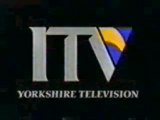 With the launch of Sky satellite TV in 1989 (and rival BSB soon to follow), some people at ITV thought that it would be opportune to create a more unified appearance for a TV channel that essentially comprised of a collection of separate regional TV broadcast franchises which happened to share much of their programming, hence the English Marshall Pockett agency were commissioned to produce a new identity package for ITV featuring a new logo plus generic-looking idents (within each ident, the ‘V’ of ITV showed part of the regional company logo), and other presentational elements intended to be used right across the ITV network, with a new theme tune composed by Lord David Dundas (also the composer of the original Channel 4 theme 4 Score). However not all of the ITV franchises adopted this new look, with the Channel, LWT and TVS franchises totally ignoring it from a local perspective, plus nearly all of the ITV franchises that did use the generic package ended up abandoning its use after only a year, with the notable exception of Grampian Television who continued to use their ITV generic ident right up until 2006 and the STV takeover.
With the launch of Sky satellite TV in 1989 (and rival BSB soon to follow), some people at ITV thought that it would be opportune to create a more unified appearance for a TV channel that essentially comprised of a collection of separate regional TV broadcast franchises which happened to share much of their programming, hence the English Marshall Pockett agency were commissioned to produce a new identity package for ITV featuring a new logo plus generic-looking idents (within each ident, the ‘V’ of ITV showed part of the regional company logo), and other presentational elements intended to be used right across the ITV network, with a new theme tune composed by Lord David Dundas (also the composer of the original Channel 4 theme 4 Score). However not all of the ITV franchises adopted this new look, with the Channel, LWT and TVS franchises totally ignoring it from a local perspective, plus nearly all of the ITV franchises that did use the generic package ended up abandoning its use after only a year, with the notable exception of Grampian Television who continued to use their ITV generic ident right up until 2006 and the STV takeover.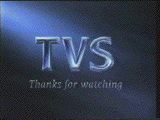 Prior to the post-2002 ITV franchise consolidation process, there were many more companies owning various individual ITV franchises that permitted them to broadcast to individual regions, and these franchises are reviewed every couple of years, with licence renewal not being an automatic process at this point, as many companies subsequently found to their cost. Thames, TVS, TSW and TV-am all lost their franchises and were replaced by Carlton, Meridian, Westcountry and GMTV at the start of 1993. The manner of which the franchise renewals were conducted in 1991 was highly controversial, and Thames Television losing its London franchise was certainly a point of huge contention. ITV programmes produced during this period included Yorkshire Television’s highly successful comedy drama adaptation of H.E.Bates’ novels entitled The Darling Buds of May.
Prior to the post-2002 ITV franchise consolidation process, there were many more companies owning various individual ITV franchises that permitted them to broadcast to individual regions, and these franchises are reviewed every couple of years, with licence renewal not being an automatic process at this point, as many companies subsequently found to their cost. Thames, TVS, TSW and TV-am all lost their franchises and were replaced by Carlton, Meridian, Westcountry and GMTV at the start of 1993. The manner of which the franchise renewals were conducted in 1991 was highly controversial, and Thames Television losing its London franchise was certainly a point of huge contention. ITV programmes produced during this period included Yorkshire Television’s highly successful comedy drama adaptation of H.E.Bates’ novels entitled The Darling Buds of May. Commercial television sometimes uses what is known as a ‘break bumper’ which is a very short (typically less than 2 second) animation with no music shown just before and/or after the commercial break – the picture is taken from one which was used by Meridian Television. Occasionally ITV companies used a simple animation between each commercial as well (technically known as an ‘optic’ or ‘ad spacer’); the one used by Westward Television featured a rotating hexagon of all things, something perhaps adopted with Channel Television in mind because for many years Westward provided the ‘parent’ programme feed for the smallest ITV contractor serving the Channel Islands.
Commercial television sometimes uses what is known as a ‘break bumper’ which is a very short (typically less than 2 second) animation with no music shown just before and/or after the commercial break – the picture is taken from one which was used by Meridian Television. Occasionally ITV companies used a simple animation between each commercial as well (technically known as an ‘optic’ or ‘ad spacer’); the one used by Westward Television featured a rotating hexagon of all things, something perhaps adopted with Channel Television in mind because for many years Westward provided the ‘parent’ programme feed for the smallest ITV contractor serving the Channel Islands. With the new ITV franchise holders came new early evening regional news programmes in their respective regions: for example, Carlton introduced London Tonight, Meridian introduced Meridian Tonight (replacing TVS’s Coast to Coast) whilst Westcountry introduced Westcountry Live as a replacement for TSW Today.
With the new ITV franchise holders came new early evening regional news programmes in their respective regions: for example, Carlton introduced London Tonight, Meridian introduced Meridian Tonight (replacing TVS’s Coast to Coast) whilst Westcountry introduced Westcountry Live as a replacement for TSW Today. TV from the heart…ITV’s new image as introduced on 5 October 1998, which includes a new lower case itv logo (replacing the 1989 design) and colour scheme. Designed by English and Pockett, the theme of hearts introduced throughout ITV’s on-screen presentation is meant to symbolise ‘warmth’ and ‘cuddliness’, though presumably ITV executives nearly had heart failure when they learnt of the BBC Choice ‘three hearts’ ident that also introduced during 1998. However not all companies made use all the changes, eg. Meridian and others frequently used their own style of ident/break bumper and appended their own logo to generic ITV trailers. LWT for some reason decided to create their own idents based around the hearts theme, perhaps to make their own output a bit more distinctive compared to Carlton’s weekday presentation. 1998 also saw the beginning of a successful long-running big money quiz: Who Wants To Be A Millionaire?.
TV from the heart…ITV’s new image as introduced on 5 October 1998, which includes a new lower case itv logo (replacing the 1989 design) and colour scheme. Designed by English and Pockett, the theme of hearts introduced throughout ITV’s on-screen presentation is meant to symbolise ‘warmth’ and ‘cuddliness’, though presumably ITV executives nearly had heart failure when they learnt of the BBC Choice ‘three hearts’ ident that also introduced during 1998. However not all companies made use all the changes, eg. Meridian and others frequently used their own style of ident/break bumper and appended their own logo to generic ITV trailers. LWT for some reason decided to create their own idents based around the hearts theme, perhaps to make their own output a bit more distinctive compared to Carlton’s weekday presentation. 1998 also saw the beginning of a successful long-running big money quiz: Who Wants To Be A Millionaire?.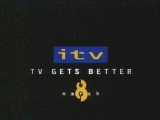 The next (and not uncontroversial) change was the axing of News at Ten from March 8 1999. Since 1967, News at Ten had been a regular feature of the ITV weekday evening schedule and it had also been a condition of the ITV franchise holders that they were to show it regardless, meaning that it was impossible to start showing a movie at (say) 9 pm without being interrupted by anything but commercials. After many complaints, the ITC forced ITV to reinstate its 10pm bulletin at least for four days a week; it was known as the “ITV News at Ten“, though it wasn’t too long before this idea was abandoned for a shorter bulletin in a later slot. Nowadays both ITV and BBC One have major news bulletins at 10pm.
The next (and not uncontroversial) change was the axing of News at Ten from March 8 1999. Since 1967, News at Ten had been a regular feature of the ITV weekday evening schedule and it had also been a condition of the ITV franchise holders that they were to show it regardless, meaning that it was impossible to start showing a movie at (say) 9 pm without being interrupted by anything but commercials. After many complaints, the ITC forced ITV to reinstate its 10pm bulletin at least for four days a week; it was known as the “ITV News at Ten“, though it wasn’t too long before this idea was abandoned for a shorter bulletin in a later slot. Nowadays both ITV and BBC One have major news bulletins at 10pm. From Monday 8 November 1999 – a year and a month after the ITV ‘heart’ logo was introduced, all English ITV franchises (except the Carlton-owned regions) adopted the ITV “generic” look for their on-screen presentation. The Carlton example is taken from the Midlands (Central) region which used orange as a background colour.
From Monday 8 November 1999 – a year and a month after the ITV ‘heart’ logo was introduced, all English ITV franchises (except the Carlton-owned regions) adopted the ITV “generic” look for their on-screen presentation. The Carlton example is taken from the Midlands (Central) region which used orange as a background colour. Behind the scenes at ITV there have been many upheavals within many of the franchises since the mid 1990s with numerous mergers and acquistions; the net result by 2000 being that Granada owned all English ITV regions apart from London weekdays, the Midlands and the HTV West/South West of England (Westcountry) which were owned by Carlton, but even that was going to change by 2004 when Granada finally ‘merged’ with Carlton to create one company holding what were still several individual ITV franchises until the Digital Economy Act abolished them in 2010. Nowadays ITV owns all of the former franchise regions (including UTV and Channel) apart from STV covering the whole of Scotland.
Behind the scenes at ITV there have been many upheavals within many of the franchises since the mid 1990s with numerous mergers and acquistions; the net result by 2000 being that Granada owned all English ITV regions apart from London weekdays, the Midlands and the HTV West/South West of England (Westcountry) which were owned by Carlton, but even that was going to change by 2004 when Granada finally ‘merged’ with Carlton to create one company holding what were still several individual ITV franchises until the Digital Economy Act abolished them in 2010. Nowadays ITV owns all of the former franchise regions (including UTV and Channel) apart from STV covering the whole of Scotland.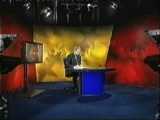 The studio set of the early evening regional news programme Central News at Six (shown here) demonstrates how the star theme used by Carlton had been utilised (note the star pattern on the backdrop of the news studio). Nowadays all the English ITV regions use the same style of general presentation, with virtually identical studio sets employed throughout the regions. (Furthermore, some former regions have now been merged with each other, for example Yorkshire and Tyne Tees.)
The studio set of the early evening regional news programme Central News at Six (shown here) demonstrates how the star theme used by Carlton had been utilised (note the star pattern on the backdrop of the news studio). Nowadays all the English ITV regions use the same style of general presentation, with virtually identical studio sets employed throughout the regions. (Furthermore, some former regions have now been merged with each other, for example Yorkshire and Tyne Tees.)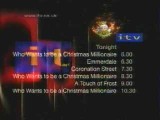 This ‘programme menu’ shows the lineup of programmes for ITV for Christmas Day 1999, which is dominated by a selection of programmes designed to try and attract the largest popular audience possible. ITV has in recent years performed relatively poorly in terms of audience share on Christmas Day, so this illustrates a clear attempt to reverse the trend, despite advertisers being less bothered about advertising on Christmas Day in spite of a potentially large captive audience.
This ‘programme menu’ shows the lineup of programmes for ITV for Christmas Day 1999, which is dominated by a selection of programmes designed to try and attract the largest popular audience possible. ITV has in recent years performed relatively poorly in terms of audience share on Christmas Day, so this illustrates a clear attempt to reverse the trend, despite advertisers being less bothered about advertising on Christmas Day in spite of a potentially large captive audience. This picture illustrates something that is starting to become more commonplace during 2001 on both ITV and BBC One; notably End Credit Promotions (or ECP for short). Whilst the end credits of one programme are being shown (in this case for an episode of the ill-fated revival of Crossroads) in one part of the screen, a promotion for another programme is being shown at the same time.
This picture illustrates something that is starting to become more commonplace during 2001 on both ITV and BBC One; notably End Credit Promotions (or ECP for short). Whilst the end credits of one programme are being shown (in this case for an episode of the ill-fated revival of Crossroads) in one part of the screen, a promotion for another programme is being shown at the same time.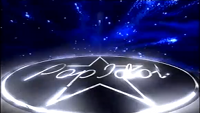 2001 saw the introduction of the first of a succession of big money-making light entertainment formats for ITV with Pop Idol; a singing contest featuring a hitherto novel combination of premium rate interactivity features (phone voting) and reality TV elements (namely, getting to know the contestants personally). This formula was subsequently adjusted by show producer Simon Cowell for the launch of The X Factor in April 2004, replacing Pop Idol in the UK, although the Pop Idol format continues to be used in certain other countries. A more traditional form of peak time weekend entertainment launched in June 2002 on ITV, namely Ant & Dec’s Saturday Night Takeaway.
2001 saw the introduction of the first of a succession of big money-making light entertainment formats for ITV with Pop Idol; a singing contest featuring a hitherto novel combination of premium rate interactivity features (phone voting) and reality TV elements (namely, getting to know the contestants personally). This formula was subsequently adjusted by show producer Simon Cowell for the launch of The X Factor in April 2004, replacing Pop Idol in the UK, although the Pop Idol format continues to be used in certain other countries. A more traditional form of peak time weekend entertainment launched in June 2002 on ITV, namely Ant & Dec’s Saturday Night Takeaway. October 2002 saw ITV1 launch a new look as part of a concerted effort to restore its image. ITV’s audience had been in steady decline over the last few years whilst (amongst other things) it concentrated efforts on the failed ONdigital/ITV Digital project. The new look featured various ITV personalities (such as Ant and Dec, pictured here) appearing before programmes, showing them as being “off duty” as part of short sequences, though an even more fundamental change at this point was that regional names such as Granada and Meridian were no longer used except for local news bulletins and sometimes seen just before regional programmes, plus some of these names were abandoned altogether at this juncture, eg. ITV1 London is used seven days a week with the LWT brand dropped (although the London region was at this point still controlled by two companies with Granada operating at the weekend and Carlton during weekdays).
October 2002 saw ITV1 launch a new look as part of a concerted effort to restore its image. ITV’s audience had been in steady decline over the last few years whilst (amongst other things) it concentrated efforts on the failed ONdigital/ITV Digital project. The new look featured various ITV personalities (such as Ant and Dec, pictured here) appearing before programmes, showing them as being “off duty” as part of short sequences, though an even more fundamental change at this point was that regional names such as Granada and Meridian were no longer used except for local news bulletins and sometimes seen just before regional programmes, plus some of these names were abandoned altogether at this juncture, eg. ITV1 London is used seven days a week with the LWT brand dropped (although the London region was at this point still controlled by two companies with Granada operating at the weekend and Carlton during weekdays).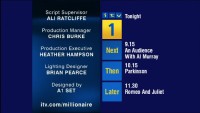 The final transformation: On 2 February 2004 Granada finally merged with Carlton to create one ITV company (“ITV plc”) for England and Wales when shares in the unified company were first traded on the Stock Exchange, though STV (Scottish/Grampian, formerly SMG) and UTV (Northern Ireland) remain separate entities at the time of writing. (Channel Television remained independent until 2010 when it was taken over by ITV plc.) The Granada name was adopted as the network production brand for a while, whilst the Carlton name promptly disappeared into the history books like so many of its ITV franchise predecessors, though the Granada brand nowadays only exists in the North-West of England as part of the title of the regional news magazine programme Granada Reports; the fate of several of the previous ITV franchise brands.
The final transformation: On 2 February 2004 Granada finally merged with Carlton to create one ITV company (“ITV plc”) for England and Wales when shares in the unified company were first traded on the Stock Exchange, though STV (Scottish/Grampian, formerly SMG) and UTV (Northern Ireland) remain separate entities at the time of writing. (Channel Television remained independent until 2010 when it was taken over by ITV plc.) The Granada name was adopted as the network production brand for a while, whilst the Carlton name promptly disappeared into the history books like so many of its ITV franchise predecessors, though the Granada brand nowadays only exists in the North-West of England as part of the title of the regional news magazine programme Granada Reports; the fate of several of the previous ITV franchise brands.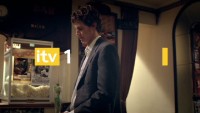 A new unified look was introduced for ITV1 and ITV2, with ITV3 being created soon afterwards when Granada bought out BSkyB’s share of the digital channel (Granada). ITV4 was subsequently launched in 2005 with a new style of ITV logo that would be adopted elsewhere during 2006; the original plan was to scrap the Men & Motors channel but its continued popularity led to a reprieve and the ITV News Channel ended up being scrapped instead ostensibly due to the popularity of “on-demand” news (the ITV News Channel closed on 23 December 2005).
A new unified look was introduced for ITV1 and ITV2, with ITV3 being created soon afterwards when Granada bought out BSkyB’s share of the digital channel (Granada). ITV4 was subsequently launched in 2005 with a new style of ITV logo that would be adopted elsewhere during 2006; the original plan was to scrap the Men & Motors channel but its continued popularity led to a reprieve and the ITV News Channel ended up being scrapped instead ostensibly due to the popularity of “on-demand” news (the ITV News Channel closed on 23 December 2005). ITV suffered more than most from the decline in viewers experienced by nearly all television channels from the late-1990s onward, which was caused by numerous factors including most notably a large increase in the number of channels available via the uptake of digital television. With advertising revenues and market share still suffering from double-digit declines, ITV introduced a completely new look for its channels along with a new ‘itv’ logo in an attempt to reverse its declining fortunes, though it was (and still is) the most popular commercial television channel in the UK by a fair margin.
ITV suffered more than most from the decline in viewers experienced by nearly all television channels from the late-1990s onward, which was caused by numerous factors including most notably a large increase in the number of channels available via the uptake of digital television. With advertising revenues and market share still suffering from double-digit declines, ITV introduced a completely new look for its channels along with a new ‘itv’ logo in an attempt to reverse its declining fortunes, though it was (and still is) the most popular commercial television channel in the UK by a fair margin.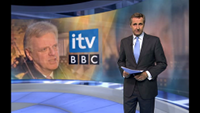 At this point, what ITV really needed was a manager with a proven track record within the media industry as well as being deeply familiar with the history of ITV and its inner workings as a programme maker. Step forward Michael Grade, who was convinced of a need to return to his old employer in order to revive its flagging fortunes, even if his return to ITV in November 2006 was going to be relatively short-lived. Indeed Grade left the BBC at what seemed to be a critical point during licence fee negotiations which had taken place in conjunction with Mark Thompson, so this move was rather surprising yet welcome for ITV, all things considered. Whatever your views on Grade, his name gave some much-needed reassurance to ITV’s shareholders at an important juncture.
At this point, what ITV really needed was a manager with a proven track record within the media industry as well as being deeply familiar with the history of ITV and its inner workings as a programme maker. Step forward Michael Grade, who was convinced of a need to return to his old employer in order to revive its flagging fortunes, even if his return to ITV in November 2006 was going to be relatively short-lived. Indeed Grade left the BBC at what seemed to be a critical point during licence fee negotiations which had taken place in conjunction with Mark Thompson, so this move was rather surprising yet welcome for ITV, all things considered. Whatever your views on Grade, his name gave some much-needed reassurance to ITV’s shareholders at an important juncture. This caption illustrates the style of end credit promotion used by ITV around this time, showing what is coming up next on various other ITV channels. Note the mention of a (short-lived) ITV Play channel, which was forced to close due to industry-wide concerns over the use of premium rate phone lines for viewers to call in order to answer quiz questions. ITV Nightscreen still continues to be shown at various times during the early morning.
This caption illustrates the style of end credit promotion used by ITV around this time, showing what is coming up next on various other ITV channels. Note the mention of a (short-lived) ITV Play channel, which was forced to close due to industry-wide concerns over the use of premium rate phone lines for viewers to call in order to answer quiz questions. ITV Nightscreen still continues to be shown at various times during the early morning.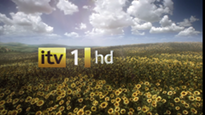 ITV formally launched a high definition version of ITV1 on 2 April 2010 with six regional variations, and is available on Freeview HD unlike the high definition versions of other ITV channels due to a lack of available bandwidth, though not all new programmes were produced in HD at the time. ITV HD initially launched as a trial channel to Telewest cable TV customers in 2006 as well as being a limited experimental terrestrial broadcast in the London area from Crystal Palace, and was launched primarily for the showing of World Cup games as well as other programming such as films, Poirot, and a remastered version of the 70s sci-fi epic Space: 1999. 2009 saw the ITV HD channel appear on Freesat and Freeview HD (rebranded ITV1 HD), but the HD service was still limited to the hours of 18:00-23:00 7 days a week until the official launch; the same year also saw the demise of long-running arts series The South Bank Show in December, an occasion seen by some as the death of serious factual programming on the channel.
ITV formally launched a high definition version of ITV1 on 2 April 2010 with six regional variations, and is available on Freeview HD unlike the high definition versions of other ITV channels due to a lack of available bandwidth, though not all new programmes were produced in HD at the time. ITV HD initially launched as a trial channel to Telewest cable TV customers in 2006 as well as being a limited experimental terrestrial broadcast in the London area from Crystal Palace, and was launched primarily for the showing of World Cup games as well as other programming such as films, Poirot, and a remastered version of the 70s sci-fi epic Space: 1999. 2009 saw the ITV HD channel appear on Freesat and Freeview HD (rebranded ITV1 HD), but the HD service was still limited to the hours of 18:00-23:00 7 days a week until the official launch; the same year also saw the demise of long-running arts series The South Bank Show in December, an occasion seen by some as the death of serious factual programming on the channel. A long-running institution came to an end on 31 August 2010 with the final episode of The Bill (Part 2 of a story entitled ‘Respect’). Produced by Thames Television, it started life as a one-off drama entitled ‘Woodentop‘ in 1984 which then got turned into a series, and its cast rapidly became household names as the series increased in popularity. The Bill went through several changes throughout its lifetime, including the controversial adoption of soap opera-style storylines (along with several cast changes), alienating many of the drama’s core fans before reverting back to predominantly self-contained stories using a regular cast as had been the case from the beginning. It has been claimed that the final nail in the coffin for this series came with an abrupt move to a post-9pm timeslot with barely enough notice given so as to modify existing stories for the extended hour-long slot, hence the end result proved to be relatively unsuitable despite some strong storylines.
A long-running institution came to an end on 31 August 2010 with the final episode of The Bill (Part 2 of a story entitled ‘Respect’). Produced by Thames Television, it started life as a one-off drama entitled ‘Woodentop‘ in 1984 which then got turned into a series, and its cast rapidly became household names as the series increased in popularity. The Bill went through several changes throughout its lifetime, including the controversial adoption of soap opera-style storylines (along with several cast changes), alienating many of the drama’s core fans before reverting back to predominantly self-contained stories using a regular cast as had been the case from the beginning. It has been claimed that the final nail in the coffin for this series came with an abrupt move to a post-9pm timeslot with barely enough notice given so as to modify existing stories for the extended hour-long slot, hence the end result proved to be relatively unsuitable despite some strong storylines. When ITV had an opportunity to acquire the independent Channel 3 breakfast TV franchise held by GMTV by buying out Disney’s share of the company it did so, and a new breakfast show was soon created for ITV1 – Daybreak, which launched on 6 September 2010 and isn’t to be confused with a programme of the same name broadcast by the TV-am franchise. (The breakfast television franchise remained classed as a separate entity within the 2010 Digital Economy Act passed within the last weeks of Gordon Brown’s Labour administration.)
When ITV had an opportunity to acquire the independent Channel 3 breakfast TV franchise held by GMTV by buying out Disney’s share of the company it did so, and a new breakfast show was soon created for ITV1 – Daybreak, which launched on 6 September 2010 and isn’t to be confused with a programme of the same name broadcast by the TV-am franchise. (The breakfast television franchise remained classed as a separate entity within the 2010 Digital Economy Act passed within the last weeks of Gordon Brown’s Labour administration.) Poaching Adrian Chiles and Christine Bleakley from the BBC was supposedly going to be a ‘safe’ option in an attempt to somehow transplant the popularity of BBC One’s The One Show into breakfast time television, but by doing so ended up alienating loyal GMTV viewers who had become accustomed to its cosy charms, and just as GMTV had slowly evolved to become more like its TV-am predecessor, Daybreak soon made changes to its format in order to become a little more like its GMTV predecessor, though BBC One’s rival Breakfast News continued to outperform Daybreak in terms of popularity and Daybreak‘s sinking fortunes caused ITV to have yet another rethink and yet another borrowing from the past with the launch of Good Morning Britain in April 2014 (sharing a title with TV-am’s original breakfast time show).
Poaching Adrian Chiles and Christine Bleakley from the BBC was supposedly going to be a ‘safe’ option in an attempt to somehow transplant the popularity of BBC One’s The One Show into breakfast time television, but by doing so ended up alienating loyal GMTV viewers who had become accustomed to its cosy charms, and just as GMTV had slowly evolved to become more like its TV-am predecessor, Daybreak soon made changes to its format in order to become a little more like its GMTV predecessor, though BBC One’s rival Breakfast News continued to outperform Daybreak in terms of popularity and Daybreak‘s sinking fortunes caused ITV to have yet another rethink and yet another borrowing from the past with the launch of Good Morning Britain in April 2014 (sharing a title with TV-am’s original breakfast time show). January 2013 saw ITV’s biggest identity and corporate rebrand in 12 years, and a brand new curvy and joined-up lowercase logo was just one of several changes. Gone was the designation of ITV1 for the most popular channel; it’s now just known as ITV because that’s how most viewers refer to it (apparently). In theory doing such a thing might make distinguishing between ITV the broadcaster and ITV the channel a little tricky, but ITV has basically copied Channel 4 in this respect. All ITV channels had a simultaneous presentational makeover; the ITV channel gaining several new idents where the different colours of the logo change as the ident progresses, with the logo only becoming fully-formed at various points, taking a cue from the nature of Channel 4’s acclaimed idents on this occasion.
January 2013 saw ITV’s biggest identity and corporate rebrand in 12 years, and a brand new curvy and joined-up lowercase logo was just one of several changes. Gone was the designation of ITV1 for the most popular channel; it’s now just known as ITV because that’s how most viewers refer to it (apparently). In theory doing such a thing might make distinguishing between ITV the broadcaster and ITV the channel a little tricky, but ITV has basically copied Channel 4 in this respect. All ITV channels had a simultaneous presentational makeover; the ITV channel gaining several new idents where the different colours of the logo change as the ident progresses, with the logo only becoming fully-formed at various points, taking a cue from the nature of Channel 4’s acclaimed idents on this occasion. Unsurprisingly ITV News also received a makeover at the same time, with a more sober single colour treatment of the logo and a very contemporary feel applied to the studio with a designer combination of creamy white, navy blue and a wooden floor. All the regional news studios were updated similarly, and the colour scheme also applies to the graphics and associated promotional material. As of 2013, ITV’s programme portfolio includes the acclaimed period drama Downton Abbey, recently-introduced period drama Mr Selfridge, and the new Saturday evening entertainment show Splash! that features celebrities diving into a pool, though the early evening cookery contest Food Glorious Food! turned out to be less appetising to viewers than originally expected.
Unsurprisingly ITV News also received a makeover at the same time, with a more sober single colour treatment of the logo and a very contemporary feel applied to the studio with a designer combination of creamy white, navy blue and a wooden floor. All the regional news studios were updated similarly, and the colour scheme also applies to the graphics and associated promotional material. As of 2013, ITV’s programme portfolio includes the acclaimed period drama Downton Abbey, recently-introduced period drama Mr Selfridge, and the new Saturday evening entertainment show Splash! that features celebrities diving into a pool, though the early evening cookery contest Food Glorious Food! turned out to be less appetising to viewers than originally expected.
 The BBC (British Broadcasting Company, as it was known at the time) started the world’s first regular high definition – ‘high’ in this case being relative to what was technologically possible at the time – public television service at 3 p.m. on 2 November 1936, transmitting 405-line black-and-white pictures from Alexandra Palace (London) to an audience of less than 400 sets. The transmitter range was only 30 miles, and programming was very minimal to begin with – an hour in the afternoon and an hour in the evening, and nothing on Sundays until February 1938 – due to a lack of budget and studio facilities (only one studio available until 1938 when the second studio housing the Baird camera was recommissioned) and also due to early concerns about eye strain, though staring for long periods at a small flickering screen must have been difficult.
The BBC (British Broadcasting Company, as it was known at the time) started the world’s first regular high definition – ‘high’ in this case being relative to what was technologically possible at the time – public television service at 3 p.m. on 2 November 1936, transmitting 405-line black-and-white pictures from Alexandra Palace (London) to an audience of less than 400 sets. The transmitter range was only 30 miles, and programming was very minimal to begin with – an hour in the afternoon and an hour in the evening, and nothing on Sundays until February 1938 – due to a lack of budget and studio facilities (only one studio available until 1938 when the second studio housing the Baird camera was recommissioned) and also due to early concerns about eye strain, though staring for long periods at a small flickering screen must have been difficult. Lord Selsdon’s Committee, set up by the Postmaster General in 1935 had advised that the BBC should hold a public trial of the two systems proposed – Baird’s 240-line mechanical scanning system and Marconi-EMI’s 405-line electronic scanning system, so both systems were used on alternate weeks with each system’s equipment housed in separate 40 foot long studios. The Marconi-EMI system was so obviously superior in all respects that the Baird system was dropped by February 1937; Baird’s camera was fixed and required the subject to be specially lit, compared with Marconi-EMI’s cameras which could even be used outside with an extension lead. Baird had tried to overcome camera restrictions using an “intermediate film system” where celluloid film was rapidly processed and fed into an optical scanner, but it became fairly obvious that this cumbersome and expensive technique was merely a stop-gap compared to the Marconi-EMI system’s future potential.
Lord Selsdon’s Committee, set up by the Postmaster General in 1935 had advised that the BBC should hold a public trial of the two systems proposed – Baird’s 240-line mechanical scanning system and Marconi-EMI’s 405-line electronic scanning system, so both systems were used on alternate weeks with each system’s equipment housed in separate 40 foot long studios. The Marconi-EMI system was so obviously superior in all respects that the Baird system was dropped by February 1937; Baird’s camera was fixed and required the subject to be specially lit, compared with Marconi-EMI’s cameras which could even be used outside with an extension lead. Baird had tried to overcome camera restrictions using an “intermediate film system” where celluloid film was rapidly processed and fed into an optical scanner, but it became fairly obvious that this cumbersome and expensive technique was merely a stop-gap compared to the Marconi-EMI system’s future potential. Before World War 2 television was slow to catch on, largely due to the limited range of the transmissions, lack of programmes, and the cost of the receivers (£60 upwards) meant that typically only wealthy people could afford them, so programming was aimed generally at this audience; especially as the BBC itself was controlled by people from these affluent social groups.
Before World War 2 television was slow to catch on, largely due to the limited range of the transmissions, lack of programmes, and the cost of the receivers (£60 upwards) meant that typically only wealthy people could afford them, so programming was aimed generally at this audience; especially as the BBC itself was controlled by people from these affluent social groups. Television was still very much in its infancy when the service restarted in 1946. One set per street was common, and families often visited friends or relatives who had a set in order to watch events such as the Coronation in 1953. Also only two studios were available until 1949 when the BBC opened eight new West London studios (one ex-variety theatre and the rest were converted film studios).
Television was still very much in its infancy when the service restarted in 1946. One set per street was common, and families often visited friends or relatives who had a set in order to watch events such as the Coronation in 1953. Also only two studios were available until 1949 when the BBC opened eight new West London studios (one ex-variety theatre and the rest were converted film studios). After World War 2 a comprehensive transmitter building programme ensured more people outside heavy populated areas such as London could watch television, though it was slow to progress due to funding restrictions. In 1949 television reached the Midlands, Manchester in 1951, Scotland in 1952, then Wales and the West Country. Lack of signal coverage didn’t stop people living in ‘fringe’ areas putting up large aerials in an attempt to receive some form of television picture even if the end result was unwatchable from time to time due to nearby interference, even though for the first few post-war years television was heavily restricted to a small number of programmes each day, typically starting with a demonstration film in the morning and concluding with a news broadcast being relayed in sound only. Large gaps between programmes were very common, with interlude films or tuning signal captions being displayed between programmes.
After World War 2 a comprehensive transmitter building programme ensured more people outside heavy populated areas such as London could watch television, though it was slow to progress due to funding restrictions. In 1949 television reached the Midlands, Manchester in 1951, Scotland in 1952, then Wales and the West Country. Lack of signal coverage didn’t stop people living in ‘fringe’ areas putting up large aerials in an attempt to receive some form of television picture even if the end result was unwatchable from time to time due to nearby interference, even though for the first few post-war years television was heavily restricted to a small number of programmes each day, typically starting with a demonstration film in the morning and concluding with a news broadcast being relayed in sound only. Large gaps between programmes were very common, with interlude films or tuning signal captions being displayed between programmes. On December 2 1953, the BBC introduced a new symbol for use as visual identification (or an ident) for its Television Service, which quickly gained the nickname of “bat’s wings” due to its shape, and was the world’s first animated television ident symbol. Two ‘eyes’ rotated in the centre of a mechanical model whilst flashes of light shone on the wings at quarter-turn intervals; this was constructed as a mechanical model and the animation was filmed because the model was too fragile for regular use. The concept was developed by talented designer Abram Games, who was commissioned by the BBC on the strength of his emblem design for the Festival of Britain in 1951.
On December 2 1953, the BBC introduced a new symbol for use as visual identification (or an ident) for its Television Service, which quickly gained the nickname of “bat’s wings” due to its shape, and was the world’s first animated television ident symbol. Two ‘eyes’ rotated in the centre of a mechanical model whilst flashes of light shone on the wings at quarter-turn intervals; this was constructed as a mechanical model and the animation was filmed because the model was too fragile for regular use. The concept was developed by talented designer Abram Games, who was commissioned by the BBC on the strength of his emblem design for the Festival of Britain in 1951. Games also designed this clock as well as static cards featuring a simplified version of the same logo. Both the animated symbol and the clock remained in use until the end of 1959, but static captions featuring the symbol continued to be used until October 1960, whilst elements of the symbol (such as miniature lightning flashes) continued to be used for Schools programming until October 1961. During the mid-fifties, television was becoming more ambitious in terms of quantity and breadth, especially as post-war rationing was gradually coming to an end; programmes during this era included Mainly For Women, quiz show What’s My Line?, comedy series Emney Enterprises, drama serial The Grove Family, children’s favourite The Flowerpot Men and the groundbreaking six-part science fiction drama Quatermass and the Pit.
Games also designed this clock as well as static cards featuring a simplified version of the same logo. Both the animated symbol and the clock remained in use until the end of 1959, but static captions featuring the symbol continued to be used until October 1960, whilst elements of the symbol (such as miniature lightning flashes) continued to be used for Schools programming until October 1961. During the mid-fifties, television was becoming more ambitious in terms of quantity and breadth, especially as post-war rationing was gradually coming to an end; programmes during this era included Mainly For Women, quiz show What’s My Line?, comedy series Emney Enterprises, drama serial The Grove Family, children’s favourite The Flowerpot Men and the groundbreaking six-part science fiction drama Quatermass and the Pit.

 Television was starting to prove that the coverage of news and current events could combine the immediacy of a radio news report with visuals which were far more up-to-date than a cinema newsreel, even if news bulletins in particular were somewhat restricted in terms of what was achievable with the resources available to them. The use of still photographs to illustrate news stories (as opposed to moving pictures) was extremely commonplace, with regional news programmes in particular continuing with the practice into the 1980s primarily due to a lack of resources.
Television was starting to prove that the coverage of news and current events could combine the immediacy of a radio news report with visuals which were far more up-to-date than a cinema newsreel, even if news bulletins in particular were somewhat restricted in terms of what was achievable with the resources available to them. The use of still photographs to illustrate news stories (as opposed to moving pictures) was extremely commonplace, with regional news programmes in particular continuing with the practice into the 1980s primarily due to a lack of resources. The early post-war BBC news bulletins were often almost identical in format to the newsreels shown in cinemas, but competition from Independent Television News from 1955 onwards caused the BBC to adopt a more flexible presentation format for its bulletins. Shown here is Richard Baker presenting the 6pm news bulletin.
The early post-war BBC news bulletins were often almost identical in format to the newsreels shown in cinemas, but competition from Independent Television News from 1955 onwards caused the BBC to adopt a more flexible presentation format for its bulletins. Shown here is Richard Baker presenting the 6pm news bulletin. Post-war improvements in television technology meant that outside broadcasts of events such as horse racing were not only technically feasible but a wireless link meant that the action could be relayed back to the studios in real time from a moving vehicle for a truly live broadcast with no need to rush-process reels of film.
Post-war improvements in television technology meant that outside broadcasts of events such as horse racing were not only technically feasible but a wireless link meant that the action could be relayed back to the studios in real time from a moving vehicle for a truly live broadcast with no need to rush-process reels of film. The advent of video recording using magnetic tape in 1956 not only meant that programmes could now be easily recorded and reused, but also allowed for the recording of outdoor and indoor events for replaying at a more convenient time. Shown here is one of the first videotape recorders that was housed at the BBC’s Lime Grove studios; early videotapes were unreliable so the recording had to be replayed by a technician to check the quality of the recording before it was used for broadcast. Due to the high price of both the recorder and the tapes, the tapes were frequently wiped and reused after a programme had been shown or after a later repeat showing, therefore many programmes were not kept for posterity as a consequence unless they were judged to be of particular importance.
The advent of video recording using magnetic tape in 1956 not only meant that programmes could now be easily recorded and reused, but also allowed for the recording of outdoor and indoor events for replaying at a more convenient time. Shown here is one of the first videotape recorders that was housed at the BBC’s Lime Grove studios; early videotapes were unreliable so the recording had to be replayed by a technician to check the quality of the recording before it was used for broadcast. Due to the high price of both the recorder and the tapes, the tapes were frequently wiped and reused after a programme had been shown or after a later repeat showing, therefore many programmes were not kept for posterity as a consequence unless they were judged to be of particular importance. Video playback was particularly useful for the replay of sporting events such as horse racing, though good quality and immediate slow motion action replays had to wait for the invention of magnetic videodisc recording in 1968, and the replay time of these early disc recorders was limited to less than 30 seconds. Pictured here is the presenter of Sportsview, Peter Dimmock.
Video playback was particularly useful for the replay of sporting events such as horse racing, though good quality and immediate slow motion action replays had to wait for the invention of magnetic videodisc recording in 1968, and the replay time of these early disc recorders was limited to less than 30 seconds. Pictured here is the presenter of Sportsview, Peter Dimmock. Current affairs is a very important part of the schedule, and uses the medium of television to effectively cover the background to current news stories with a greater depth than is generally possible with a conventional news bulletin; here is Cliff Michelmore presenting an episode of Tonight. Other similar programmes include Panorama, which was (and still is) the BBC’s flagship current affairs programme that usually tackles a single topical issue in depth.
Current affairs is a very important part of the schedule, and uses the medium of television to effectively cover the background to current news stories with a greater depth than is generally possible with a conventional news bulletin; here is Cliff Michelmore presenting an episode of Tonight. Other similar programmes include Panorama, which was (and still is) the BBC’s flagship current affairs programme that usually tackles a single topical issue in depth. Dixon of Dock Green, with Jack Warner as PC Dixon was a long running police series that was rather old-fashioned in its approach even when it was first shown, but was popular nevertheless and lasted right up until 1976 when the competition (such as Z Cars and Softly Softly Task Force) started to make it look way past its “sell-by date”.
Dixon of Dock Green, with Jack Warner as PC Dixon was a long running police series that was rather old-fashioned in its approach even when it was first shown, but was popular nevertheless and lasted right up until 1976 when the competition (such as Z Cars and Softly Softly Task Force) started to make it look way past its “sell-by date”. The increase in viewers combined with competition from ITV by 1955 lead to new programme ideas being explored. From 1956 onwards, Barry Bucknell (pictured here) presented do-it-yourself projects on television, firstly as a contributor to About The Home which was then followed by his own series, entitled Barry Bucknell’s Do It Yourself. Just like many contemporaneous studio-based productions, this was broadcast live, resulting in the occasional (and inevitable) on-screen mishap. He then went on to present the much more ambitious house renovation programme Bucknell’s House in 1962, featuring a house in Ealing bought for £2,250. This area of programming was relatively neglected during the following decades until the advent of Changing Rooms in 1994, though there was On the House shown in the mid 1980s.
The increase in viewers combined with competition from ITV by 1955 lead to new programme ideas being explored. From 1956 onwards, Barry Bucknell (pictured here) presented do-it-yourself projects on television, firstly as a contributor to About The Home which was then followed by his own series, entitled Barry Bucknell’s Do It Yourself. Just like many contemporaneous studio-based productions, this was broadcast live, resulting in the occasional (and inevitable) on-screen mishap. He then went on to present the much more ambitious house renovation programme Bucknell’s House in 1962, featuring a house in Ealing bought for £2,250. This area of programming was relatively neglected during the following decades until the advent of Changing Rooms in 1994, though there was On the House shown in the mid 1980s. Grandstand was the name of the BBC’s long-running sports magazine programme that was broadcast between 1958 and 2007, mainly on Saturday afternoons when much of the sporting action took place. Peter Dimmock presented the first three programmes but David Coleman then took over the role of presenter who was followed by Frank Bough, Des Lynam, Steve Rider and a slew of guest presenters during its final years up until Grandstand‘s final broadcasts during the last weekend of January 2007. It was most likely axed because the BBC now had fewer rights to broadcast sport than it did in the past due to increased competition from other broadcasters; notably pay-TV sport channels provided by broadcasters like BSkyB and BT.
Grandstand was the name of the BBC’s long-running sports magazine programme that was broadcast between 1958 and 2007, mainly on Saturday afternoons when much of the sporting action took place. Peter Dimmock presented the first three programmes but David Coleman then took over the role of presenter who was followed by Frank Bough, Des Lynam, Steve Rider and a slew of guest presenters during its final years up until Grandstand‘s final broadcasts during the last weekend of January 2007. It was most likely axed because the BBC now had fewer rights to broadcast sport than it did in the past due to increased competition from other broadcasters; notably pay-TV sport channels provided by broadcasters like BSkyB and BT.

 The above images illustrate the style of programme promotion used circa 1960, with its contemporary style and bold graphics replacing the Abram Games-designed “bat’s wings” symbol; elements of the new design had been introduced during 1959 prior to its formal introduction in 1960. Note the “BBC tv” italic letters appearing in separate square boxes similar to the modern BBC logo style, and the clock kept the unusually long second hand previously used for the “bat’s wing” clock. However this presentation style didn’t last nearly as long as the Abram Games symbol, with the introduction of the first of a succession of various globe symbols used to identify BBC Television soon to follow together with changes in style for the BBC corporate logo.
The above images illustrate the style of programme promotion used circa 1960, with its contemporary style and bold graphics replacing the Abram Games-designed “bat’s wings” symbol; elements of the new design had been introduced during 1959 prior to its formal introduction in 1960. Note the “BBC tv” italic letters appearing in separate square boxes similar to the modern BBC logo style, and the clock kept the unusually long second hand previously used for the “bat’s wing” clock. However this presentation style didn’t last nearly as long as the Abram Games symbol, with the introduction of the first of a succession of various globe symbols used to identify BBC Television soon to follow together with changes in style for the BBC corporate logo. With television now rapidly becoming the dominant broadcasting medium in the UK, the BBC needed somewhere that was much bigger than Alexandra Palace to accommodate its production requirements, therefore a new headquarters known as BBC Television Centre was commissioned and built on a suitable site in West London, with construction commencing in 1952 and Television Centre was ready for use by June 1960. From the air, the Television Centre buildings appear to take on the shape of a question mark, because that layout was thought to be best for the site in general.
With television now rapidly becoming the dominant broadcasting medium in the UK, the BBC needed somewhere that was much bigger than Alexandra Palace to accommodate its production requirements, therefore a new headquarters known as BBC Television Centre was commissioned and built on a suitable site in West London, with construction commencing in 1952 and Television Centre was ready for use by June 1960. From the air, the Television Centre buildings appear to take on the shape of a question mark, because that layout was thought to be best for the site in general. The BBC naturally wanted to show off its new Television Centre building to its viewers, so a special light entertainment programme was shown on 29 June 1960 in order to do just that, logically entitled First Night. Not all of the BBC’s departments moved into the new building straightaway, with (for example) the News division not moving into Television Centre until 1969. The Open University was to make use of otherwise-unused Alexandra Palace studio facilities from 1970 onwards.
The BBC naturally wanted to show off its new Television Centre building to its viewers, so a special light entertainment programme was shown on 29 June 1960 in order to do just that, logically entitled First Night. Not all of the BBC’s departments moved into the new building straightaway, with (for example) the News division not moving into Television Centre until 1969. The Open University was to make use of otherwise-unused Alexandra Palace studio facilities from 1970 onwards.

 The introduction of BBC2 in 1964, which enabled extra programmes which were not necessarily of mass appeal to be shown, and eventually colour was introduced to (what was now known as) BBC1 by the end of the decade. Some very memorable and ground-breaking programmes were being produced during this period which are still being shown around the world today, such as Steptoe and Son, and the long-running Doctor Who series began. Other programmes shown during the late 1960s included the popular sitcom Beggar My Neighbour, soap The Newcomers and football club drama United.
The introduction of BBC2 in 1964, which enabled extra programmes which were not necessarily of mass appeal to be shown, and eventually colour was introduced to (what was now known as) BBC1 by the end of the decade. Some very memorable and ground-breaking programmes were being produced during this period which are still being shown around the world today, such as Steptoe and Son, and the long-running Doctor Who series began. Other programmes shown during the late 1960s included the popular sitcom Beggar My Neighbour, soap The Newcomers and football club drama United. The weather forecast had progressed from the use of hand-drawn maps to the use of magnetic symbols by the mid-1960s as shown here, and this style of map continued to be used for several years after BBC1 had started broadcasting in colour in 1969. Before the use of magnetic symbols, everything had to be hand-drawn which was a time-consuming practice as well as being rather inflexible; the whole map obviously had to be redrawn if a correction was required.
The weather forecast had progressed from the use of hand-drawn maps to the use of magnetic symbols by the mid-1960s as shown here, and this style of map continued to be used for several years after BBC1 had started broadcasting in colour in 1969. Before the use of magnetic symbols, everything had to be hand-drawn which was a time-consuming practice as well as being rather inflexible; the whole map obviously had to be redrawn if a correction was required. Despite BBC1 getting the go-ahead to start a colour service in 1969, the regional centres were inevitably slower to upgrade all of their equipment to provide a colour service due to cost reasons, and it was several months before Television Centre was fully colour-equipped. The news magazine programme Nationwide incorporating reports and features from the various regions also started in this particular year, and some of the regional contributions weren’t produced in colour until the end of the 1970s. (Inside Out is perhaps the modern spiritual successor to Nationwide even if The One Show has a similar mix of features and studio discussion pieces.)
Despite BBC1 getting the go-ahead to start a colour service in 1969, the regional centres were inevitably slower to upgrade all of their equipment to provide a colour service due to cost reasons, and it was several months before Television Centre was fully colour-equipped. The news magazine programme Nationwide incorporating reports and features from the various regions also started in this particular year, and some of the regional contributions weren’t produced in colour until the end of the 1970s. (Inside Out is perhaps the modern spiritual successor to Nationwide even if The One Show has a similar mix of features and studio discussion pieces.) 1972 was the 50th anniversary of the BBC, though at that time less than 20% of viewers had a colour television despite a colour service being available on all three channels since 1969; the BBC’s summer Olympic Games coverage did however help to boost colour television sales during 1972. Notable BBC1 programmes broadcast during the early 1970s included Bruce Forsyth and the Generation Game (its initial title) which started in 1971, science fiction drama Moonbase 3, drama series Owen, M.D., plus the popular sitcoms Are You Being Served? and the very long-running Last Of The Summer Wine began in 1972.
1972 was the 50th anniversary of the BBC, though at that time less than 20% of viewers had a colour television despite a colour service being available on all three channels since 1969; the BBC’s summer Olympic Games coverage did however help to boost colour television sales during 1972. Notable BBC1 programmes broadcast during the early 1970s included Bruce Forsyth and the Generation Game (its initial title) which started in 1971, science fiction drama Moonbase 3, drama series Owen, M.D., plus the popular sitcoms Are You Being Served? and the very long-running Last Of The Summer Wine began in 1972. By the mid 1970s most families had at least one television set, and nearly all of the populated regions of the British Isles could receive television pictures in some form even if it was only a 405-line monochrome signal. Sitcoms and studio-based light entertainment were of extremely high quality during this period, with many classic programmes produced including It Ain’t Half Hot Mum, Some Mothers Do ‘Ave ‘Em, The Good Life and The Liver Birds. The Two Ronnies, The Morecambe and Wise Show and The Mike Yarwood Show featured in what many people now consider to be the BBC’s greatest ever Christmas Day schedule in 1977.
By the mid 1970s most families had at least one television set, and nearly all of the populated regions of the British Isles could receive television pictures in some form even if it was only a 405-line monochrome signal. Sitcoms and studio-based light entertainment were of extremely high quality during this period, with many classic programmes produced including It Ain’t Half Hot Mum, Some Mothers Do ‘Ave ‘Em, The Good Life and The Liver Birds. The Two Ronnies, The Morecambe and Wise Show and The Mike Yarwood Show featured in what many people now consider to be the BBC’s greatest ever Christmas Day schedule in 1977. The Basil Brush Show started life as a children’s programme in 1968, showing on Thursdays just before the early evening news, but by the mid-1970s it had moved to an early Saturday evening slot and was now a very popular mainstream family entertainment show, featuring top singing stars like Cilla Black, Demis Roussos and Petula Clark that often did a comedy duet with fox puppet Basil as well as singing on their own. Basil is shown here with Roy North, who became Basil’s human sidekick in 1976.
The Basil Brush Show started life as a children’s programme in 1968, showing on Thursdays just before the early evening news, but by the mid-1970s it had moved to an early Saturday evening slot and was now a very popular mainstream family entertainment show, featuring top singing stars like Cilla Black, Demis Roussos and Petula Clark that often did a comedy duet with fox puppet Basil as well as singing on their own. Basil is shown here with Roy North, who became Basil’s human sidekick in 1976. Angels was a popular drama series set in a fictional (St. Angela’s) hospital, and is just one example of the BBC’s prodigious drama output from the 1970s. Indeed Angels survived until the early 1980s and was the spiritual predecessor to Casualty (which started in 1986) and its later spin-off Holby City which are now shown on a regular basis. Other drama offerings from this period included historical drama I, Claudius, and science fiction series Blake’s 7 began in 1978.
Angels was a popular drama series set in a fictional (St. Angela’s) hospital, and is just one example of the BBC’s prodigious drama output from the 1970s. Indeed Angels survived until the early 1980s and was the spiritual predecessor to Casualty (which started in 1986) and its later spin-off Holby City which are now shown on a regular basis. Other drama offerings from this period included historical drama I, Claudius, and science fiction series Blake’s 7 began in 1978.


 Pictured is what a typical BBC News bulletin looked like in 1978, with Angela Rippon being the newsreader. There was still a predominance of photographs used during this period as opposed to the video clips that typify modern news bulletins, though national news bulletins were steadily becoming more sophisticated in their visual presentation.
Pictured is what a typical BBC News bulletin looked like in 1978, with Angela Rippon being the newsreader. There was still a predominance of photographs used during this period as opposed to the video clips that typify modern news bulletins, though national news bulletins were steadily becoming more sophisticated in their visual presentation. Here’s an example of a BBC1 Saturday evening programme schedule as broadcast on 14 April 1979. At this point virtually all new programmes were now being produced in colour, though there were still a significant number of people that didn’t have colour televisions; 1976 being the year when colour TV licences outnumbered those issued for black and white. 1979 also saw the broadcast of what was the most ambitious natural history series commissioned up to that point, namely Life on Earth, presented by David Attenborough.
Here’s an example of a BBC1 Saturday evening programme schedule as broadcast on 14 April 1979. At this point virtually all new programmes were now being produced in colour, though there were still a significant number of people that didn’t have colour televisions; 1976 being the year when colour TV licences outnumbered those issued for black and white. 1979 also saw the broadcast of what was the most ambitious natural history series commissioned up to that point, namely Life on Earth, presented by David Attenborough. Blankety Blank was a popular BBC quiz show which was first presented by Terry Wogan (famous for having his long stick microphone bent by Kenny Everett), but was later presented by Les Dawson. Then the series was revived with Lilly Savage at the helm, followed by ITV giving the idea a brief revival itself but none of these revivals matched the popularity of the original series.
Blankety Blank was a popular BBC quiz show which was first presented by Terry Wogan (famous for having his long stick microphone bent by Kenny Everett), but was later presented by Les Dawson. Then the series was revived with Lilly Savage at the helm, followed by ITV giving the idea a brief revival itself but none of these revivals matched the popularity of the original series. 1982 was the 60th anniversary of the BBC, and the “60 BBC Years” slogan was also used at the bottom of the BBC1 globe ident for a while as part of the celebrations. September that same year also saw the introduction of a new light entertainment series: The Late, Late Breakfast Show, which featured a selection of occasionally dangerous stunts performed by members of the public in the “Give It A Whirl” slot that resulted in several injuries and a death that caused the show to be cancelled in 1986. The Late-Late Breakfast Show was presented by Noel Edmonds who at that point was famous for presenting breakfast shows both on the radio and Swap Shop on BBC1, hence the tongue-in-cheek title.
1982 was the 60th anniversary of the BBC, and the “60 BBC Years” slogan was also used at the bottom of the BBC1 globe ident for a while as part of the celebrations. September that same year also saw the introduction of a new light entertainment series: The Late, Late Breakfast Show, which featured a selection of occasionally dangerous stunts performed by members of the public in the “Give It A Whirl” slot that resulted in several injuries and a death that caused the show to be cancelled in 1986. The Late-Late Breakfast Show was presented by Noel Edmonds who at that point was famous for presenting breakfast shows both on the radio and Swap Shop on BBC1, hence the tongue-in-cheek title. 1982 was also the year of the Falklands War, with the BBC naturally devoting significant coverage to this particular news story allowing for the limitations of war reporting. Also the raising of the wreck of the Mary Rose was shown live on television in the same year.
1982 was also the year of the Falklands War, with the BBC naturally devoting significant coverage to this particular news story allowing for the limitations of war reporting. Also the raising of the wreck of the Mary Rose was shown live on television in the same year. The start of 1983 heralded the launch of breakfast television, with the BBC getting in first with their Breakfast Time before the new TV-am ITV franchise started over on Channel 3. Frank Bough and the team turned out to be just what the nation was waiting for in terms of breakfast television in the morning, and the new TV-am got off to a bad start to the day as a consequence.
The start of 1983 heralded the launch of breakfast television, with the BBC getting in first with their Breakfast Time before the new TV-am ITV franchise started over on Channel 3. Frank Bough and the team turned out to be just what the nation was waiting for in terms of breakfast television in the morning, and the new TV-am got off to a bad start to the day as a consequence. By January 1985 the old 405-line VHF network had completely closed down, and a full daytime television schedule launched in 1986 that included Neighbours, the Australian soap opera which is still being shown on Channel 5. By 1989 the BBC and other broadcasters also faced competition from the newly-emerging satellite services (Sky and BSB, with Sky eventually taking over BSB to form BSkyB). Pictured is an example of what a Saturday evening’s viewing on BBC1 looked like on the 6th of June 1987.
By January 1985 the old 405-line VHF network had completely closed down, and a full daytime television schedule launched in 1986 that included Neighbours, the Australian soap opera which is still being shown on Channel 5. By 1989 the BBC and other broadcasters also faced competition from the newly-emerging satellite services (Sky and BSB, with Sky eventually taking over BSB to form BSkyB). Pictured is an example of what a Saturday evening’s viewing on BBC1 looked like on the 6th of June 1987.


 This graphic style used for BBC News has the nickname of “Star Wars” due to the logo appearing to be constructed in space using a beam of light; it certainly seemed to match the mood of the period in terms of its drama and pomposity.
This graphic style used for BBC News has the nickname of “Star Wars” due to the logo appearing to be constructed in space using a beam of light; it certainly seemed to match the mood of the period in terms of its drama and pomposity. The 1980s was also the era of the video cassette recorder or ‘VCR’; although such devices were available in the 1970s (and earlier) it was this decade that saw them become widely available and (by 1987) inexpensive thanks to the aggressive pricing of Far Eastern-produced machines such as Amstrad. Teletext became commonplace on more expensive sets and included on some of the cheaper ones too, and Nicam stereo sound was introduced towards the end of the decade, initially from certain transmitters only.
The 1980s was also the era of the video cassette recorder or ‘VCR’; although such devices were available in the 1970s (and earlier) it was this decade that saw them become widely available and (by 1987) inexpensive thanks to the aggressive pricing of Far Eastern-produced machines such as Amstrad. Teletext became commonplace on more expensive sets and included on some of the cheaper ones too, and Nicam stereo sound was introduced towards the end of the decade, initially from certain transmitters only. All smoke and mirrors? The globe above was replaced with this smoky light reflecting version in 1991, together with the return of the 1960s typeface. The word ‘Stereo’ appeared in the top-left hand corner when a programme with a stereo soundtrack followed – BBC1 was the last established UK channel to formally introduce Nicam stereo, which it did in September 1991, but not all major transmitters had been upgraded to carry the digital signal from day one.
All smoke and mirrors? The globe above was replaced with this smoky light reflecting version in 1991, together with the return of the 1960s typeface. The word ‘Stereo’ appeared in the top-left hand corner when a programme with a stereo soundtrack followed – BBC1 was the last established UK channel to formally introduce Nicam stereo, which it did in September 1991, but not all major transmitters had been upgraded to carry the digital signal from day one. The change from a globe to a balloon (albeit with a globe pattern) came at the same time as the BBC changed its onscreen font to Gill Sans in October 1997, which was part of Martin Lambie-Nairn’s corporate vision for the BBC. The adoption of Gill Sans was something that was both traditional and forward-thinking in terms of looking better when displayed in the new widescreen format and when decompressed from a digitally-compressed datastream compared with the old sloping rhombus typeface that dates back to the 1960s. A variety of short video clips are used featuring the BBC balloon in different locations around the British Isles (above a castle, behind a suspension bridge, etc.), meaning that the balloon usually had a different ‘view’ before each programme as opposed to the essentially static backdrop that the globe had.
The change from a globe to a balloon (albeit with a globe pattern) came at the same time as the BBC changed its onscreen font to Gill Sans in October 1997, which was part of Martin Lambie-Nairn’s corporate vision for the BBC. The adoption of Gill Sans was something that was both traditional and forward-thinking in terms of looking better when displayed in the new widescreen format and when decompressed from a digitally-compressed datastream compared with the old sloping rhombus typeface that dates back to the 1960s. A variety of short video clips are used featuring the BBC balloon in different locations around the British Isles (above a castle, behind a suspension bridge, etc.), meaning that the balloon usually had a different ‘view’ before each programme as opposed to the essentially static backdrop that the globe had.







 Also launched at the same time as the new corporate look for the BBC was perhaps the most successful UK TV-based promotion of all time; it was based around a simple concept, namely that the BBC offers a huge variety of different types of music, catering for almost every taste on its numerous radio and television services.
Also launched at the same time as the new corporate look for the BBC was perhaps the most successful UK TV-based promotion of all time; it was based around a simple concept, namely that the BBC offers a huge variety of different types of music, catering for almost every taste on its numerous radio and television services. Set to the soundtrack of Perfect Day, a song originally performed by Lou Reed who also appears amongst the numerous celebrities who both take it in turns to sing and appear on screen, with a slide projector showing various images interspersed with the celebrities. Also note the thin black bars appearing at the top and bottom of the pictures, indicating that it was one of the first BBC productions to be produced in widescreen format, though the widescreen format was only formally introduced with the introduction of digital widescreen broadcasting the following year.
Set to the soundtrack of Perfect Day, a song originally performed by Lou Reed who also appears amongst the numerous celebrities who both take it in turns to sing and appear on screen, with a slide projector showing various images interspersed with the celebrities. Also note the thin black bars appearing at the top and bottom of the pictures, indicating that it was one of the first BBC productions to be produced in widescreen format, though the widescreen format was only formally introduced with the introduction of digital widescreen broadcasting the following year. This version of Perfect Day was released as a charity record and sold more than a million copies in the UK, reaching Number 1 in the singles chart and most likely to have been a major factor in the popularity of this particular promotion, though it has to be said that the promotion itself was exquisitely produced and directed therefore is essentially a work of art in its own right.
This version of Perfect Day was released as a charity record and sold more than a million copies in the UK, reaching Number 1 in the singles chart and most likely to have been a major factor in the popularity of this particular promotion, though it has to be said that the promotion itself was exquisitely produced and directed therefore is essentially a work of art in its own right. March 2002 saw a radical new look introduced for BBC One; the main channel logo now appears in a box just like the BBC Two logo, but more controversially the globe as a centrepiece has now been banished to the history books, and instead various sequences using dance as a theme have been introduced. The whole emphasis was to introduce a modern multicultural ‘feel’ to the channel, but whether the identity of the channel had been diluted as a result is open to debate, especially as the channel’s presentation package only lasted four years before being replaced by something else.
March 2002 saw a radical new look introduced for BBC One; the main channel logo now appears in a box just like the BBC Two logo, but more controversially the globe as a centrepiece has now been banished to the history books, and instead various sequences using dance as a theme have been introduced. The whole emphasis was to introduce a modern multicultural ‘feel’ to the channel, but whether the identity of the channel had been diluted as a result is open to debate, especially as the channel’s presentation package only lasted four years before being replaced by something else. Several programming ideas were tried in 2004 with mixed results; Test your Pet, presumably intended to be educational in relation to animal training but ended up being closer in spirit to to the somewhat infamous but fun Pets Win Prizes. As well as testing pets, humans were equally tested in Come and Have a Go… If You Think You’re Smart Enough, consumer issues were aired in the short-lived Brassed Off Britain, detective drama Murphy’s Law received an airing but something rather more enduring also debuted soon afterwards – Strictly Come Dancing, a dance competition show which rapidly became very popular and continues to this day. And the following year saw the rejuvenation of an old idea which also proved to be just as popular.
Several programming ideas were tried in 2004 with mixed results; Test your Pet, presumably intended to be educational in relation to animal training but ended up being closer in spirit to to the somewhat infamous but fun Pets Win Prizes. As well as testing pets, humans were equally tested in Come and Have a Go… If You Think You’re Smart Enough, consumer issues were aired in the short-lived Brassed Off Britain, detective drama Murphy’s Law received an airing but something rather more enduring also debuted soon afterwards – Strictly Come Dancing, a dance competition show which rapidly became very popular and continues to this day. And the following year saw the rejuvenation of an old idea which also proved to be just as popular. By 2005 Lorraine Heggessey had been replaced by Peter Fincham as controller of BBC One, and the general consensus was that Heggessey had left the channel in a relatively strong position in terms of its drama output with a newly rejuvenated Doctor Who alongside other popular series like New Tricks, proving that it is still possible to have a drama series that appeals to the whole family, though the channel was criticised in the BBC Annual Report for perhaps running too many repeats in peak time. Hustle and A Picture of Britain were other examples of popular programmes, plus The Kumars at No 42 being an example of a programme transferred from BBC Two to BBC One.
By 2005 Lorraine Heggessey had been replaced by Peter Fincham as controller of BBC One, and the general consensus was that Heggessey had left the channel in a relatively strong position in terms of its drama output with a newly rejuvenated Doctor Who alongside other popular series like New Tricks, proving that it is still possible to have a drama series that appeals to the whole family, though the channel was criticised in the BBC Annual Report for perhaps running too many repeats in peak time. Hustle and A Picture of Britain were other examples of popular programmes, plus The Kumars at No 42 being an example of a programme transferred from BBC Two to BBC One. August 2006 saw the first four week trial run of The ONE Show, but its debut had notable differences compared to what the series became when it returned as an (almost) regular fixture of early weekday evenings on BBC One starting from July 2007, notably a different co-presenter alongside Adrian Chiles (Nadia Sawalha), plus a different title sequence with different music as well as the studio being based in Birmingham (the studio overlooked a canal).
August 2006 saw the first four week trial run of The ONE Show, but its debut had notable differences compared to what the series became when it returned as an (almost) regular fixture of early weekday evenings on BBC One starting from July 2007, notably a different co-presenter alongside Adrian Chiles (Nadia Sawalha), plus a different title sequence with different music as well as the studio being based in Birmingham (the studio overlooked a canal). During the 2006 trial there was a more formal use of a map showing different UK locations where each regional feature originated from. The ONE Show was thought of by some people as being a spiritual successor to Nationwide, but this was perhaps more the case for the trial run with its map-based presentation as opposed to the revamped final version which had essentially become just a succession of studio-linked features.
During the 2006 trial there was a more formal use of a map showing different UK locations where each regional feature originated from. The ONE Show was thought of by some people as being a spiritual successor to Nationwide, but this was perhaps more the case for the trial run with its map-based presentation as opposed to the revamped final version which had essentially become just a succession of studio-linked features. The ONE Show‘s trial run was judged to have been a success but several changes were made including the moderately controversial step of moving the show’s studio base to London as well as employing Christine Bleakley as a co-presenter since Sawalha was no longer available, though both Chiles and Bleakley were later lured by ITV in order to head up their new GMTV replacement, Daybreak, but that didn’t work out as expected therefore both are now employed on different projects within ITV productions. (Chiles was and still is noted for his football punditry.)
The ONE Show‘s trial run was judged to have been a success but several changes were made including the moderately controversial step of moving the show’s studio base to London as well as employing Christine Bleakley as a co-presenter since Sawalha was no longer available, though both Chiles and Bleakley were later lured by ITV in order to head up their new GMTV replacement, Daybreak, but that didn’t work out as expected therefore both are now employed on different projects within ITV productions. (Chiles was and still is noted for his football punditry.) Also included immediately after The ONE Show during its 2006 trial was a short regional news opt-out billed as an “news update”; illustrated here is the BBC North West Tonight News Update, presented by Gordon Burns who has now retired and been replaced by Roger Johnson (ex-BBC South Today).
Also included immediately after The ONE Show during its 2006 trial was a short regional news opt-out billed as an “news update”; illustrated here is the BBC North West Tonight News Update, presented by Gordon Burns who has now retired and been replaced by Roger Johnson (ex-BBC South Today). What comes around…The dance and movement idents were inevitably replaced by new idents in 2006, and Red Bee Media had been contracted to produce their replacement. For inspiration they looked at some of the early 1950s BBC Television Service idents which inevitably used some form of circle as part of a tuning signal for viewers to adjust their TV sets, and everything from the Abram Games “bat’s wing” symbol to the later globes also featured a circle as part of their design, so Red Bee proposed that a new identity theme should be based around the concept of circles. New idents were produced which featured real life circular elements such as hippos, surfers, dancing children and the moon, plus the channel logo was given a new and bolder treatment. A circle signifies ‘togetherness’ in the eyes of the branding consultants, but whether viewers actually made the connection remained to be seen.
What comes around…The dance and movement idents were inevitably replaced by new idents in 2006, and Red Bee Media had been contracted to produce their replacement. For inspiration they looked at some of the early 1950s BBC Television Service idents which inevitably used some form of circle as part of a tuning signal for viewers to adjust their TV sets, and everything from the Abram Games “bat’s wing” symbol to the later globes also featured a circle as part of their design, so Red Bee proposed that a new identity theme should be based around the concept of circles. New idents were produced which featured real life circular elements such as hippos, surfers, dancing children and the moon, plus the channel logo was given a new and bolder treatment. A circle signifies ‘togetherness’ in the eyes of the branding consultants, but whether viewers actually made the connection remained to be seen. The second series of the critically-acclaimed drama Life On Mars (about a policeman who thinks that he’s living in 1973) was shown on BBC One and repeated on BBC Four during February and March of 2007. Red Bee Media was given the contract to produce promotional material for this series, and the end result was an imaginative collection of various items such as bus shelter posters and promotional clips which had been given a retro 1970s-style treatment.
The second series of the critically-acclaimed drama Life On Mars (about a policeman who thinks that he’s living in 1973) was shown on BBC One and repeated on BBC Four during February and March of 2007. Red Bee Media was given the contract to produce promotional material for this series, and the end result was an imaginative collection of various items such as bus shelter posters and promotional clips which had been given a retro 1970s-style treatment. Plus each episode of Life On Mars on BBC One began with a widescreen recreation of the style of globe ident that was in use during this era, whilst viewers in Wales were treated to a different, genuine mechanical globe complete with a voiceover provided by a continuity announcer who had worked during the early-’70s period. (Though BBC Wales didn’t actually use this type of globe until 1974.)
Plus each episode of Life On Mars on BBC One began with a widescreen recreation of the style of globe ident that was in use during this era, whilst viewers in Wales were treated to a different, genuine mechanical globe complete with a voiceover provided by a continuity announcer who had worked during the early-’70s period. (Though BBC Wales didn’t actually use this type of globe until 1974.) Other BBC One programmes in 2007 included the rather ambitious series Andrew Marr’s History of Modern Britain which attempted to cover a huge subject in five programmes broadcast between 22 May and 19 June, and its critical success resulted in a follow-up series entitled Andrew Marr’s The Making of Modern Britain.
Other BBC One programmes in 2007 included the rather ambitious series Andrew Marr’s History of Modern Britain which attempted to cover a huge subject in five programmes broadcast between 22 May and 19 June, and its critical success resulted in a follow-up series entitled Andrew Marr’s The Making of Modern Britain. 2010 saw a General Election in which a coalition government was returned, given no overall majority in the House of Commons. The BBC was on-hand to provide its comprehensive results service as is normal for such occasions, with its BBC News channel also providing rolling coverage once the main programme had drawn to a close.
2010 saw a General Election in which a coalition government was returned, given no overall majority in the House of Commons. The BBC was on-hand to provide its comprehensive results service as is normal for such occasions, with its BBC News channel also providing rolling coverage once the main programme had drawn to a close. The first major department to move from London’s Television Centre to MediaCityUK in Salford Quays was children’s television, with the Blue Peter garden following Blue Peter to its new Salford home and is now a rooftop garden. This picture is taken from the very first Blue Peter to be broadcast from Salford, with the two regular presenters arriving via dramatic means – Helen Skelton by helicopter and Barney Harwood by jet ski.
The first major department to move from London’s Television Centre to MediaCityUK in Salford Quays was children’s television, with the Blue Peter garden following Blue Peter to its new Salford home and is now a rooftop garden. This picture is taken from the very first Blue Peter to be broadcast from Salford, with the two regular presenters arriving via dramatic means – Helen Skelton by helicopter and Barney Harwood by jet ski.

 2012 was certainly a busy year for the BBC in terms of large public events; firstly there was the Queen’s Diamond Jubilee with its associated river pageant and concert to cover as well as the London Olympic Games later in the year. The BBC’s coverage of the pageant was, however, not one of its finest moments due to several technical problems meaning that many of the planned live links with boats taking part in the pageant had to be cancelled, inevitably resulting in land-based presenters such as Fearne Cotton being left with the task of filling in much more frequently than originally intended.
2012 was certainly a busy year for the BBC in terms of large public events; firstly there was the Queen’s Diamond Jubilee with its associated river pageant and concert to cover as well as the London Olympic Games later in the year. The BBC’s coverage of the pageant was, however, not one of its finest moments due to several technical problems meaning that many of the planned live links with boats taking part in the pageant had to be cancelled, inevitably resulting in land-based presenters such as Fearne Cotton being left with the task of filling in much more frequently than originally intended. Thankfully the BBC’s coverage of the Diamond Jubilee concert went much more smoothly, even if there were a few complaints about concert sound quality from some viewers. Various big-name acts took to the stage, including Stevie Wonder, Annie Lennox, Robbie Williams, Tom Jones, Sir Cliff Richard, Grace Jones doing a highly memorable routine with a hula hoop to Slave to the Rhythm, and Madness performing on top of Buckingham Palace whilst various images were being projected on the front of the building. The end result was a concert which was watched by an average of nearly 15 million viewers.
Thankfully the BBC’s coverage of the Diamond Jubilee concert went much more smoothly, even if there were a few complaints about concert sound quality from some viewers. Various big-name acts took to the stage, including Stevie Wonder, Annie Lennox, Robbie Williams, Tom Jones, Sir Cliff Richard, Grace Jones doing a highly memorable routine with a hula hoop to Slave to the Rhythm, and Madness performing on top of Buckingham Palace whilst various images were being projected on the front of the building. The end result was a concert which was watched by an average of nearly 15 million viewers.

 Once in a lifetime…The London 2012 Olympic Games promised the biggest sporting spectacle the UK had ever seen, therefore it was the BBC’s obligation to provide the best and most comprehensive coverage possible for its viewers. Indeed the BBC devoted a very significant chunk of its resources to the Games as a consequence, which included an extra HD TV channel for digital terrestrial (Freeview) viewers, 30 additional HD channels for viewing via satellite, cable or online plus other radio and online resources. It wasn’t surprising therefore that an elaborate animated promotion was commissioned to promote the BBC’s wide-ranging coverage of such a major event.
Once in a lifetime…The London 2012 Olympic Games promised the biggest sporting spectacle the UK had ever seen, therefore it was the BBC’s obligation to provide the best and most comprehensive coverage possible for its viewers. Indeed the BBC devoted a very significant chunk of its resources to the Games as a consequence, which included an extra HD TV channel for digital terrestrial (Freeview) viewers, 30 additional HD channels for viewing via satellite, cable or online plus other radio and online resources. It wasn’t surprising therefore that an elaborate animated promotion was commissioned to promote the BBC’s wide-ranging coverage of such a major event. Shown on BBC1, BBC One HD and also on the BBC HD channel in 3D, the London 2012 Olympics Opening Ceremony was watched by a peak of 27 million viewers; that’s roughly half the population of the UK tuning in to watch at least some of the ceremony’s live coverage. Danny Boyle was responsible for producing and directing the ceremony’s elaborate routines, set design and special effects that culminated in the lighting of the Olympic cauldron by eight promising young athletes using the Olympic torch that had previously been carried around the UK by various selected individuals over the previous weeks.
Shown on BBC1, BBC One HD and also on the BBC HD channel in 3D, the London 2012 Olympics Opening Ceremony was watched by a peak of 27 million viewers; that’s roughly half the population of the UK tuning in to watch at least some of the ceremony’s live coverage. Danny Boyle was responsible for producing and directing the ceremony’s elaborate routines, set design and special effects that culminated in the lighting of the Olympic cauldron by eight promising young athletes using the Olympic torch that had previously been carried around the UK by various selected individuals over the previous weeks. Despite recent distractions such as the aforementioned Olympics and Diamond Jubilee as well as the upheaval of moving staff and equipment out of Television Centre prior to its redevelopment, BBC One as a channel has continued to be a strong performer in terms of popular entertainment, factual programming, drama and comedy, with shows such as Strictly Come Dancing, Frozen Planet, Africa and Call the Midwife all attracting attention, with Miranda, Mrs Brown’s Boys and Outnumbered being three of the most popular comedies produced by the BBC in recent years. (Mrs Brown’s Boys is actually a co-production with Irish broadcaster RTÉ, who gets to broadcast each episode before the BBC does.)
Despite recent distractions such as the aforementioned Olympics and Diamond Jubilee as well as the upheaval of moving staff and equipment out of Television Centre prior to its redevelopment, BBC One as a channel has continued to be a strong performer in terms of popular entertainment, factual programming, drama and comedy, with shows such as Strictly Come Dancing, Frozen Planet, Africa and Call the Midwife all attracting attention, with Miranda, Mrs Brown’s Boys and Outnumbered being three of the most popular comedies produced by the BBC in recent years. (Mrs Brown’s Boys is actually a co-production with Irish broadcaster RTÉ, who gets to broadcast each episode before the BBC does.) Another important event for the BBC happened on 21 December 2012, which was the very last occasion when CBBC programmes were broadcast in a block on BBC One. Showing selected children’s television programmes on BBC One in the future isn’t out of the question, and there were plans to show series such as Horrible Histories in a teatime slot where they can be appreciated by a family audience as opposed to the (predominantly) children (and their parents) audience of the CBBC and CBeebies channels. Childrens’ television has perhaps been changed the most radically by the digital TV revolution, namely that many parents quickly opted to choose dedicated childrens’ TV channels for their children to watch when given the choice to do so.
Another important event for the BBC happened on 21 December 2012, which was the very last occasion when CBBC programmes were broadcast in a block on BBC One. Showing selected children’s television programmes on BBC One in the future isn’t out of the question, and there were plans to show series such as Horrible Histories in a teatime slot where they can be appreciated by a family audience as opposed to the (predominantly) children (and their parents) audience of the CBBC and CBeebies channels. Childrens’ television has perhaps been changed the most radically by the digital TV revolution, namely that many parents quickly opted to choose dedicated childrens’ TV channels for their children to watch when given the choice to do so.


 Where next…2012 also saw the BBC on the receiving end of some bad publicity in relation to the alleged antics of a now-deceased DJ and TV presenter Jimmy Savile, with some people thinking that BBC management at the time had some knowledge of Savile’s behind-the-scenes misbehaviour even though it’s almost certain that management at the time knew relatively little (if anything) as to what really happened, as well as most of his lewd behaviour occurring outside of BBC premises. Anyway, this breaking news story subsequently led to two misreporting mishaps primarily involving the BBC’s Newsnight current affairs programme that were most likely caused by major staff changes made in short succession leading to mistakes being made, but these incidents did somewhat tarnish the BBC’s reputation for scrupulously accurate current affairs reporting as a consequence, hence something was clearly needed to act as a PR offensive in order to repair the damage.
Where next…2012 also saw the BBC on the receiving end of some bad publicity in relation to the alleged antics of a now-deceased DJ and TV presenter Jimmy Savile, with some people thinking that BBC management at the time had some knowledge of Savile’s behind-the-scenes misbehaviour even though it’s almost certain that management at the time knew relatively little (if anything) as to what really happened, as well as most of his lewd behaviour occurring outside of BBC premises. Anyway, this breaking news story subsequently led to two misreporting mishaps primarily involving the BBC’s Newsnight current affairs programme that were most likely caused by major staff changes made in short succession leading to mistakes being made, but these incidents did somewhat tarnish the BBC’s reputation for scrupulously accurate current affairs reporting as a consequence, hence something was clearly needed to act as a PR offensive in order to repair the damage. Visually impressive in its design and scope, “Where Next?” sets out to remind the BBC’s viewers of all the good things the BBC has done over the years in terms of both programming and innovative firsts, starting with the British Broadcasting Company’s first radio broadcasts followed by the first TV broadcasts, the first live outside broadcast, the 1952 Coronation coverage, satellite broadcasting, the start of colour broadcasting on BBC2, Monty Python’s Flying Circus, CEEFAX, computer literacy with the BBC Micro, Newsround, Live Aid, Morph, Walking With Dinosaurs, The Office, Planet Earth on the iPlayer, Doctor Who and the online video streams for the 2012 Olympic Games, seamlessly linking one clip to another using all manner of visual trickery, and ending in a succession of BBC logos shown below an enduring symbol of BBC television, namely a globe.
Visually impressive in its design and scope, “Where Next?” sets out to remind the BBC’s viewers of all the good things the BBC has done over the years in terms of both programming and innovative firsts, starting with the British Broadcasting Company’s first radio broadcasts followed by the first TV broadcasts, the first live outside broadcast, the 1952 Coronation coverage, satellite broadcasting, the start of colour broadcasting on BBC2, Monty Python’s Flying Circus, CEEFAX, computer literacy with the BBC Micro, Newsround, Live Aid, Morph, Walking With Dinosaurs, The Office, Planet Earth on the iPlayer, Doctor Who and the online video streams for the 2012 Olympic Games, seamlessly linking one clip to another using all manner of visual trickery, and ending in a succession of BBC logos shown below an enduring symbol of BBC television, namely a globe. Moving out…As the BBC Television Centre site was now going to be substantially redeveloped to include apartments and office space amongst other uses including new television studios, the final BBC One news broadcast from the ‘old’ Television Centre took place on 18 March 2013, followed by programmes shown on 22 March comprising of a concert featuring the group Madness followed by a farewell programme: Goodbye Television Centre, both broadcast on BBC Four. Originally tried as a one-off Christmas special in 2015, 2016 saw the introduction of Michael McIntyre’s Big Show as a series with celebrity guests and features based around members of the public which recall earlier entertainment formats such as Noel’s House Party and The Late Late Breakfast Show.
Moving out…As the BBC Television Centre site was now going to be substantially redeveloped to include apartments and office space amongst other uses including new television studios, the final BBC One news broadcast from the ‘old’ Television Centre took place on 18 March 2013, followed by programmes shown on 22 March comprising of a concert featuring the group Madness followed by a farewell programme: Goodbye Television Centre, both broadcast on BBC Four. Originally tried as a one-off Christmas special in 2015, 2016 saw the introduction of Michael McIntyre’s Big Show as a series with celebrity guests and features based around members of the public which recall earlier entertainment formats such as Noel’s House Party and The Late Late Breakfast Show. BBC One’s on-screen identity based around circles had served the channel well for ten years but by the start of 2017 it was inevitably considered to be time for a new look for the channel. A new identity package was introduced that was built around the concept of ‘oneness’, namely the shared experiences of groups of people such as roller skaters (pictured), an exercise class, wheelchair athletes, tandem cyclists, night kayakers, etc., and inevitably this invited some comparisons with the dance-and-movement idents used from 2002-2006 except this time there was no dancing and no accompanying music.
BBC One’s on-screen identity based around circles had served the channel well for ten years but by the start of 2017 it was inevitably considered to be time for a new look for the channel. A new identity package was introduced that was built around the concept of ‘oneness’, namely the shared experiences of groups of people such as roller skaters (pictured), an exercise class, wheelchair athletes, tandem cyclists, night kayakers, etc., and inevitably this invited some comparisons with the dance-and-movement idents used from 2002-2006 except this time there was no dancing and no accompanying music. 2017 also saw the delayed completion of Television Centre refurbishment under new owners, with BBC Studioworks (a separate private company) now in charge of Television Centre’s three studios and post-production facilities which officially re-opened on 1 September 2017, with programmes such as the new music show Sounds Like Friday Night already making use of them.
2017 also saw the delayed completion of Television Centre refurbishment under new owners, with BBC Studioworks (a separate private company) now in charge of Television Centre’s three studios and post-production facilities which officially re-opened on 1 September 2017, with programmes such as the new music show Sounds Like Friday Night already making use of them. Christmas 2017 saw the introduction of a new festive package of idents and on-screen graphics, and it soon became clear that there was a new star of the show (so to speak). A promotional animation featuring a girl and her father where the girl suffers stage fright at a school concert proved to be popular with many viewers, and also formed the basis for short ‘stings’ and idents shown during the Christmas period such as this pictured ident where father and daughter are trying to fix Christmas lights.
Christmas 2017 saw the introduction of a new festive package of idents and on-screen graphics, and it soon became clear that there was a new star of the show (so to speak). A promotional animation featuring a girl and her father where the girl suffers stage fright at a school concert proved to be popular with many viewers, and also formed the basis for short ‘stings’ and idents shown during the Christmas period such as this pictured ident where father and daughter are trying to fix Christmas lights. From early 2018 the BBC began a gradual corporate-wide roll out of a new font entitled ‘Reith’ to replace Gill Sans (Gill Sans also requiring an expensive corporate licence for its usage), though the new font wasn’t generally used for on-screen presentation until October 2021 when a new look was introduced across most of the television channels. Some areas such as News and online had to wait a little longer before updating, so initially the BBC logo refresh wasn’t as comprehensive as it was back in 1997.
From early 2018 the BBC began a gradual corporate-wide roll out of a new font entitled ‘Reith’ to replace Gill Sans (Gill Sans also requiring an expensive corporate licence for its usage), though the new font wasn’t generally used for on-screen presentation until October 2021 when a new look was introduced across most of the television channels. Some areas such as News and online had to wait a little longer before updating, so initially the BBC logo refresh wasn’t as comprehensive as it was back in 1997. The beginning of 2020 saw a major global COVID pandemic breaking out which necessitated a fundamental rethink of ‘Oneness’ as a branding concept for BBC One, because if groups of people could no longer safely congregate together for fear of transmitting a potentially deadly virus, showing groups of people as ‘Oneness’ would obviously be no longer appropriate. Hence ‘lockdown Oneness’ was introduced, with a new selection of idents showing groups of people, pets or objects in separate rectangles but congregated together virtually, therefore showing solidarity with people confined to their homes for health reasons. Likewise various programmes were badly affected by social distancing measures introduced to avoid infection; the production of drama series such as EastEnders were put on hold and other programmes such as Have I Got News For You, The One Show and The Ranganation were rejigged to avoid using studio audiences as well as making use of ‘virtual guests’ using video links.
The beginning of 2020 saw a major global COVID pandemic breaking out which necessitated a fundamental rethink of ‘Oneness’ as a branding concept for BBC One, because if groups of people could no longer safely congregate together for fear of transmitting a potentially deadly virus, showing groups of people as ‘Oneness’ would obviously be no longer appropriate. Hence ‘lockdown Oneness’ was introduced, with a new selection of idents showing groups of people, pets or objects in separate rectangles but congregated together virtually, therefore showing solidarity with people confined to their homes for health reasons. Likewise various programmes were badly affected by social distancing measures introduced to avoid infection; the production of drama series such as EastEnders were put on hold and other programmes such as Have I Got News For You, The One Show and The Ranganation were rejigged to avoid using studio audiences as well as making use of ‘virtual guests’ using video links. One surprise was the return of BBC Three as a TV channel in February 2022. Obviously it was thought that BBC Three was still a valuable proposition as a traditional linear TV channel and it still wasn’t as relevant when restricted as an iPlayer-only service. Clearly linear TV is still appreciated by lots of young people despite the rise of the BBC’s iPlayer and commercial streaming services such as Netflix, Disney+ and Amazon Prime Video.
One surprise was the return of BBC Three as a TV channel in February 2022. Obviously it was thought that BBC Three was still a valuable proposition as a traditional linear TV channel and it still wasn’t as relevant when restricted as an iPlayer-only service. Clearly linear TV is still appreciated by lots of young people despite the rise of the BBC’s iPlayer and commercial streaming services such as Netflix, Disney+ and Amazon Prime Video. The worldwide decline of the ‘soap opera’ (serial drama) combined with recent budget cuts caused by government freezing of the TV licence fee (still the BBC’s primary income at this point) meant that the BBC took a decision to cancel medical drama series Holby City. On air since 12 January 1999, Holby City was basically a complementary series to Casualty. The last episode was transmitted on 29 March 2022 and Holby City as a whole was fundamentally a ‘love letter’ to the NHS.
The worldwide decline of the ‘soap opera’ (serial drama) combined with recent budget cuts caused by government freezing of the TV licence fee (still the BBC’s primary income at this point) meant that the BBC took a decision to cancel medical drama series Holby City. On air since 12 January 1999, Holby City was basically a complementary series to Casualty. The last episode was transmitted on 29 March 2022 and Holby City as a whole was fundamentally a ‘love letter’ to the NHS. 1 April 2022 finally saw the previously-delayed introduction of new ‘lens’ idents based around a rotating ‘sphere’ or lens effect incorporating two or more live action scenes. Several idents feature different scenes including a dance floor, park bench, skateboard park and outdoors late at night.
1 April 2022 finally saw the previously-delayed introduction of new ‘lens’ idents based around a rotating ‘sphere’ or lens effect incorporating two or more live action scenes. Several idents feature different scenes including a dance floor, park bench, skateboard park and outdoors late at night. 2022 represents a major milestone for the BBC as a whole, being the 100th anniversary of both the BBC being incorporated as a company (18 October) and the first 2LO broadcast on November 14…
2022 represents a major milestone for the BBC as a whole, being the 100th anniversary of both the BBC being incorporated as a company (18 October) and the first 2LO broadcast on November 14…